Tag Archives: huawei
Huawei Wi Fi 7 Mesh Router Turns Connectivity into Sculptural Lighting
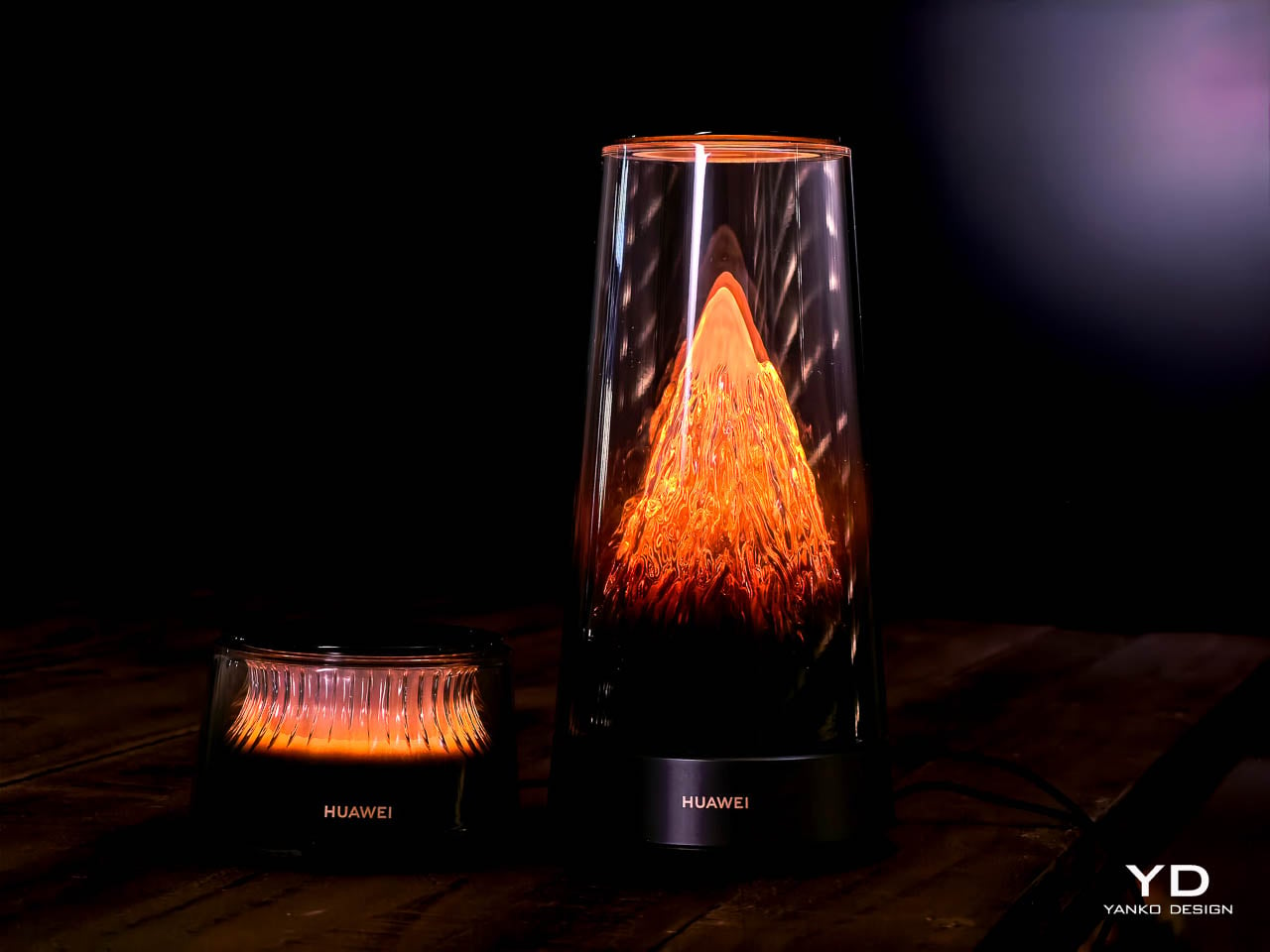
Most mesh routers exist to be hidden. They sit behind television consoles, inside media cabinets, anywhere out of sight. Huawei’s Wi-Fi 7 Mesh Router rejects that premise entirely-it was designed to occupy a shelf the way a sculptural lamp or a blown-glass vase might, demanding visibility rather than tolerating it. The system ships as a main router paired with up to two extenders, and every unit in the family brings aesthetic presence to a category that usually hides function. Whether that ambition translates into livable design depends on how much visual weight a room can absorb.
Form and First Impression
The main unit rises vertically under a tall transparent dome, and the first impression lands somewhere between illuminated glassware and a miniature architectural model. A sculpted cone sits inside the chamber, channeling warm LED light upward through fine vertical ribs that stretch the glow into elongated streaks. The gradient begins deep amber at the base, fades toward soft cream near the midpoint, and dissolves into near-invisibility at the dome’s crown. Under morning sun the dome reads as a sculptural artifact with subtle internal texture; under evening lamps it becomes a warm, glowing presence that anchors an entire corner of a room.
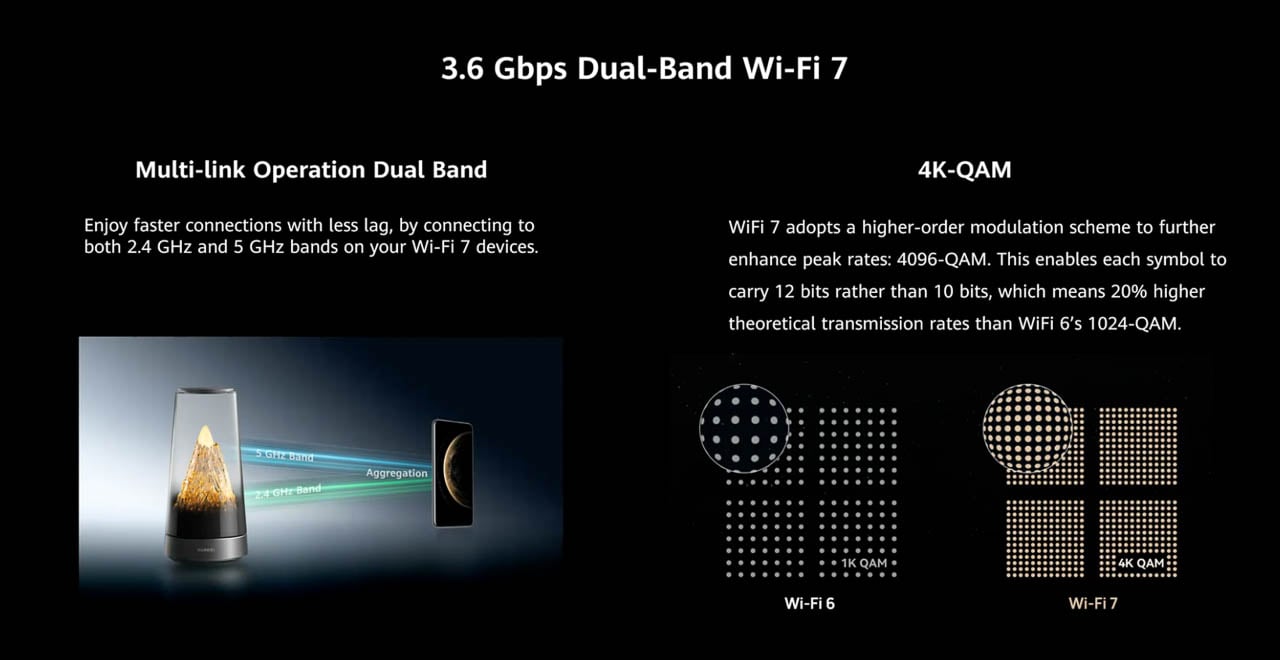
That visual prominence carries a trade-off worth acknowledging early. The dome’s height and luminosity demand attention in a way that softer network hardware does not. In quieter rooms-bedrooms, reading nooks, minimalist spaces-the persistent glow may feel like a permanent nightlight rather than a subtle accent. Huawei leans fully into the decorative category, and the result works best in spaces that already embrace statement objects.
Material Language
Huawei appears to use a dense transparent polymer that mimics the refraction and clarity of hand-blown glass. Close inspection reveals the material catches daylight differently than it catches artificial light, giving the object a living quality that shifts throughout the day. Fine vertical channels line the inner cone and catch the LEDs, stretching them into long streaks that resemble molten glass rising through a chimney. The effect positions the router closer to ambient lighting than consumer electronics.
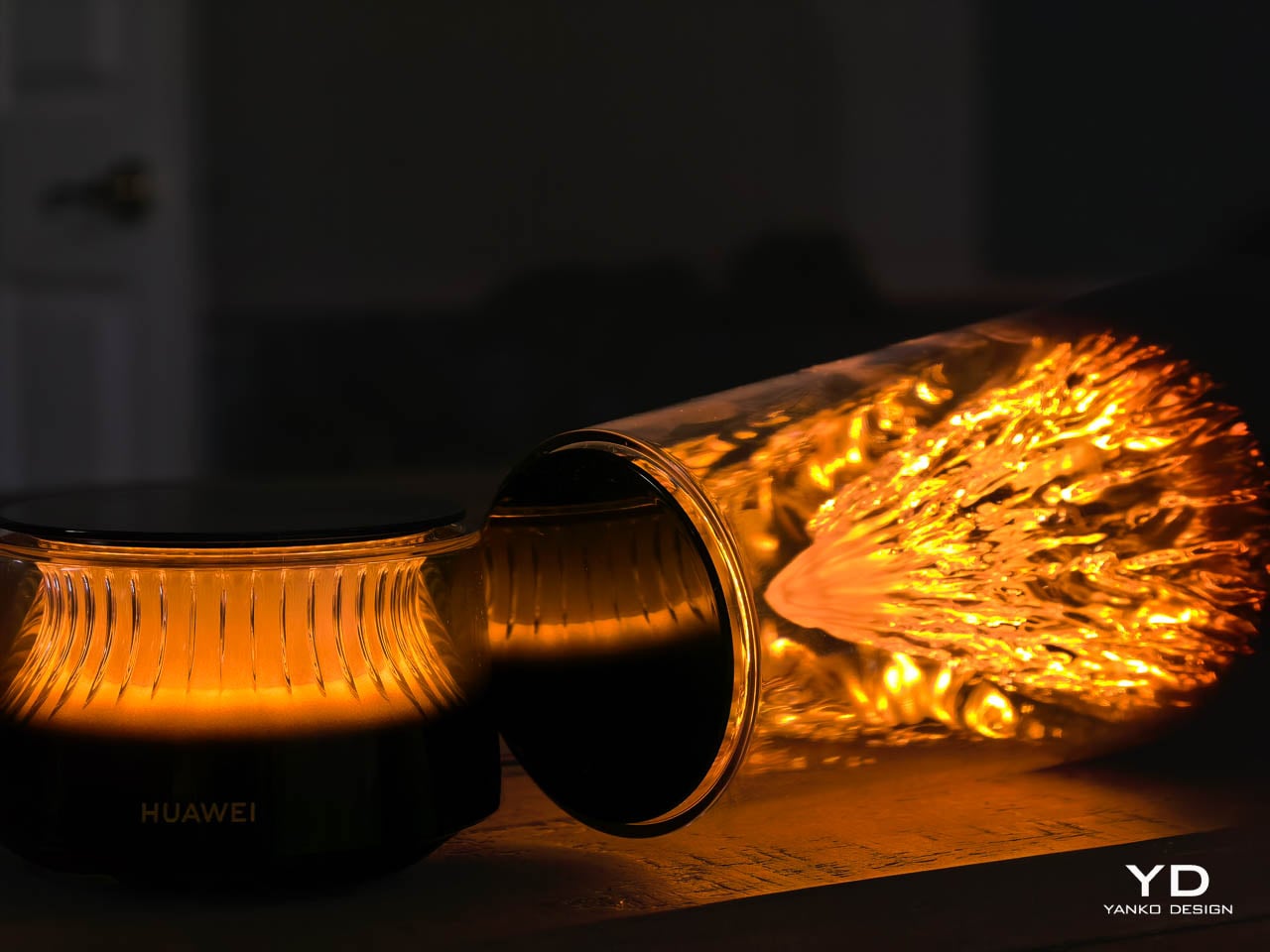
Placement matters here. The design reads best on open shelving in a living area, a console table near an entryway, or a display ledge in a modern kitchen. Treating it as background hardware-tucked beside a television or wedged into a media cabinet-misreads the intent entirely.
Hidden Engineering
Functional elements remain invisible by design, but the engineering underneath is anything but minimal. Ports sit inside a recessed cavity on the underside, tucked into the dark base, so cables disappear the moment the device rests on a flat surface. The separation between glowing dome and utilitarian base gives the impression of a clean floating cylinder even though Ethernet, power, and every technical connection remain accessible.

Weight distribution pulls toward the base-intentional, since the main router includes active cooling with a built-in fan for high-throughput scenarios. That engineering decision affects form directly: the base must accommodate thermal management, which explains the unit’s footprint relative to passive competitors. The dark matte finish stays quiet, letting the luminous chamber dominate, but the chassis is doing real work underneath.

One detail that rarely survives the translation from engineering to marketing: Huawei literally etched the antennas into the sculpted mountain shape inside the dome. Six antennas-three for 2.4GHz, three for 5GHz-run along the contours of the internal cone, hidden in plain sight. The design team integrated signal hardware into the decorative structure rather than bolting it on as an afterthought. That level of form-function synthesis is rare in consumer networking equipment, and it suggests the industrial design team had genuine authority over the final product rather than decorating an engineering prototype.
The Satellite System
Satellite extenders interpret the same visual language in a shorter, more restrained form. Huawei’s briefing compared them to elegant whisky glasses-a fair analogy. Each unit features smoked outer walls with spaced vertical ribs that break the internal gradient into a soft, pulsing glow. The warm tone matches the main router but feels more intimate, less theatrical.
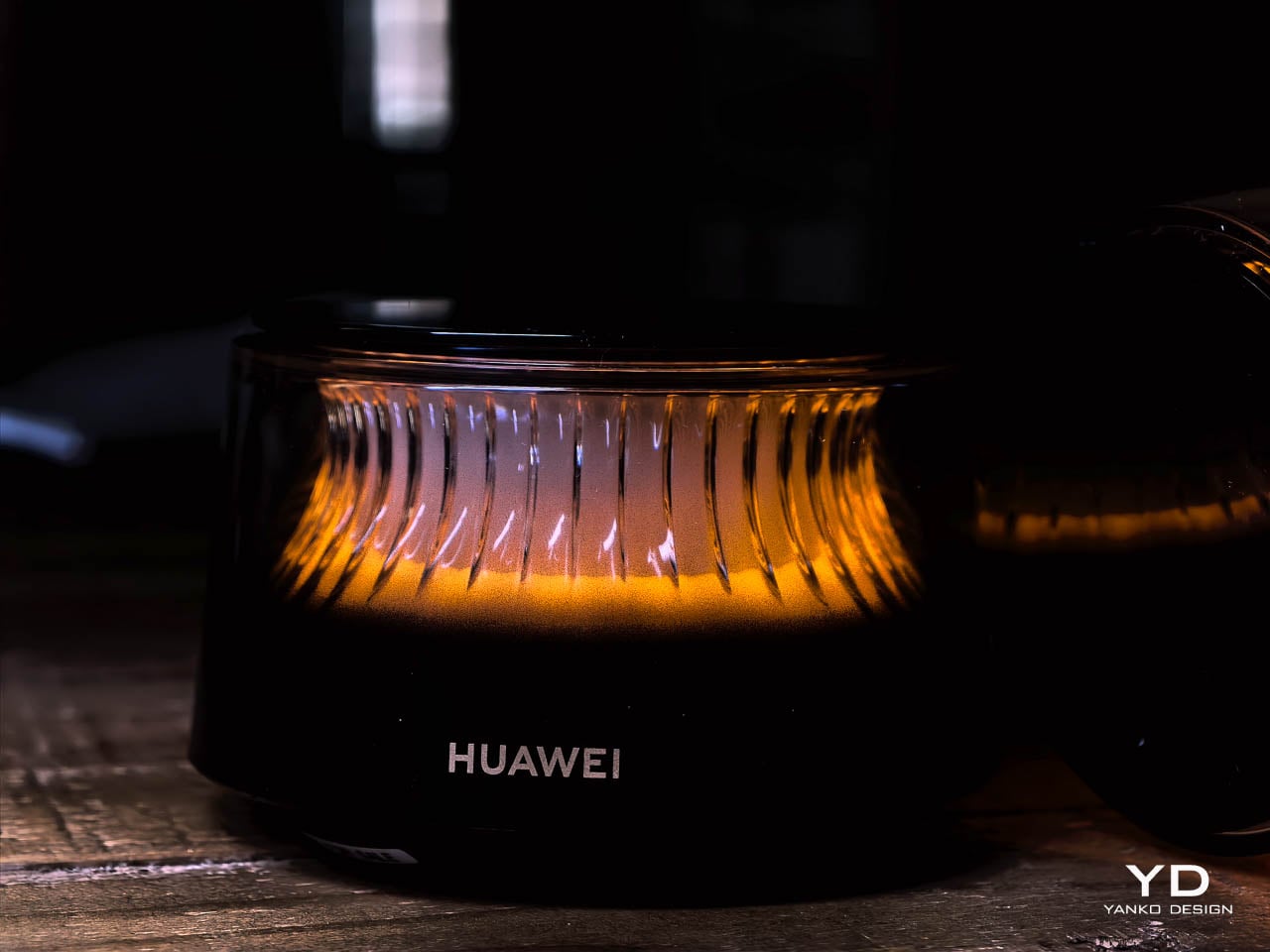
These units read as decorative accents on a shelf rather than technical equipment. No protruding antennas, no plastic ventilation grilles, no indicator LEDs screaming status codes from across the room. A candle holder or compact speaker would sit just as naturally in the same arrangement. The restraint here is notable-Huawei resisted the temptation to differentiate the satellites through size or brightness, which keeps the family identity coherent.
Interaction Design
Both the main router and each satellite include a flush touch surface on the top, letting users adjust lighting modes directly from the device. The touch panel sits flush with the rim, preserving the cylindrical outline-no buttons, no visible interface elements, no mechanical disruption. The top surface remains dark and reflective when inactive, reinforcing the contrast with the illuminated body below.
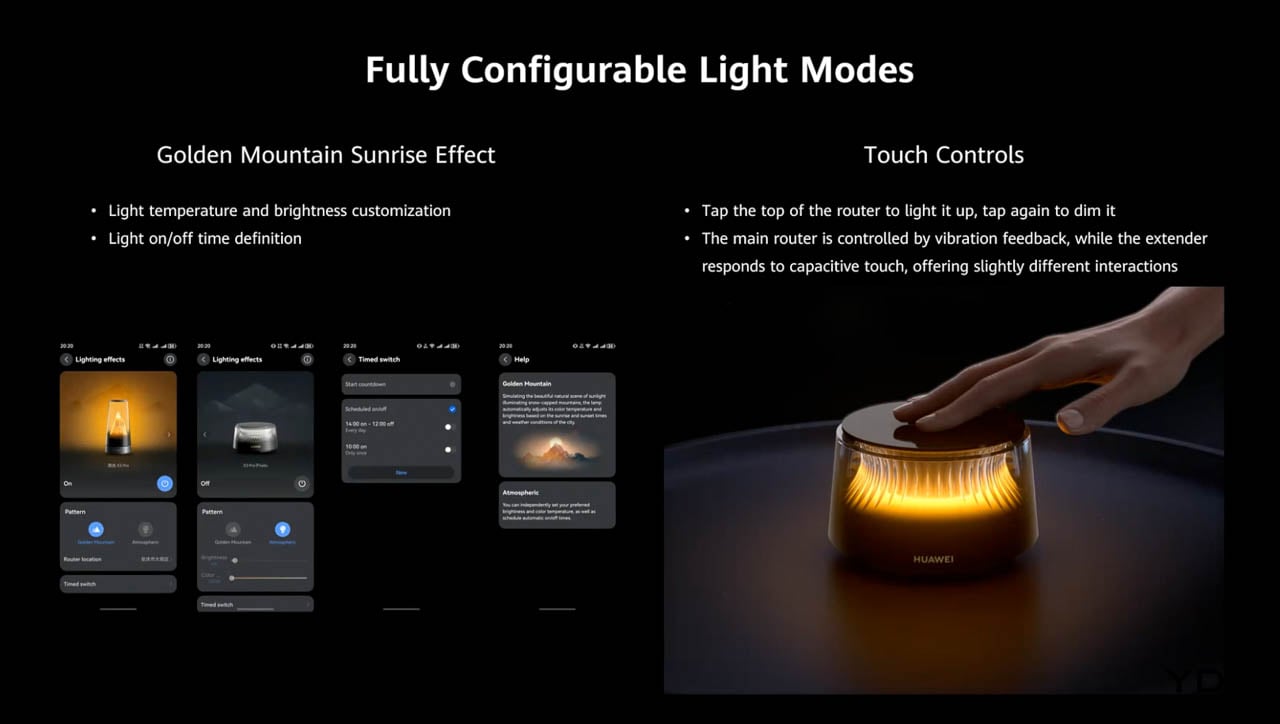
That restraint suggests confidence in the form itself. Huawei trusts the design enough to let it speak without interface clutter. The interaction layer exists, but it never competes with the sculptural presence.
The Placement Tension
The system’s visual cohesion raises a practical question that Huawei’s marketing sidesteps. Mesh networks exist to blanket a home in wireless coverage, which means placing extenders in locations optimized for signal propagation-hallways, stairwell landings, rooms far from the main router. Huawei designed units beautiful enough to display prominently, but optimal placement for aesthetics rarely aligns with optimal placement for coverage.
A living room shelf may showcase the extender perfectly while delivering weaker signal to a home office two walls away. Buyers should expect to choose between form and function in at least one placement decision, and that tension deserves acknowledgment. The router rewards homes where signal-optimal spots happen to be visible spots-and punishes homes where they don’t.
System Coherence
Material consistency across the system reinforces the family identity in ways that most mesh systems ignore. The polymer domes, the dark matte bases, the warm LED gradients, and the vertical rib detailing all repeat across main unit and satellites. Nothing about the extenders looks like a compromise or an accessory-they read as intentional companions rather than technical necessities.
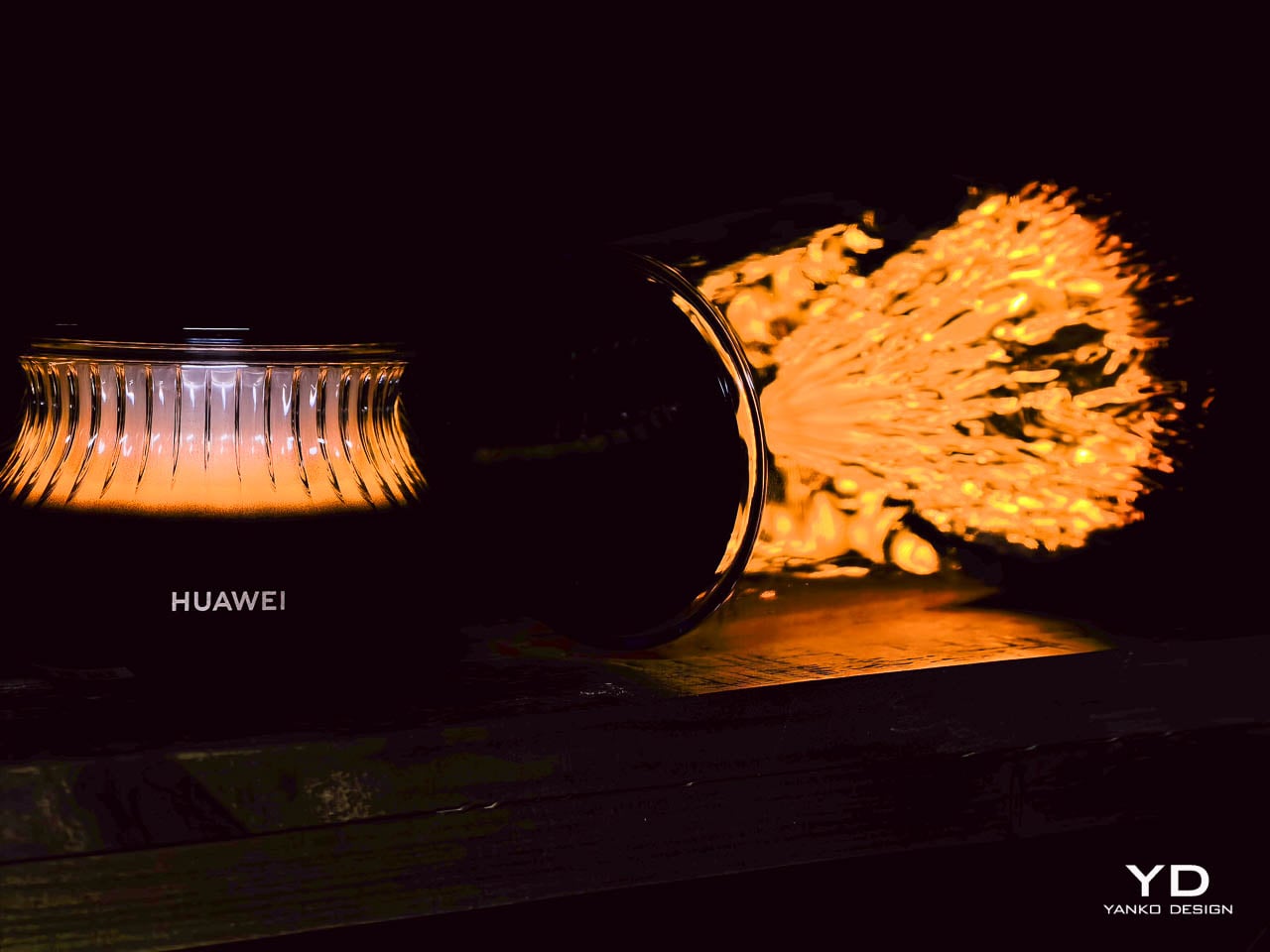
That coherence reflects a design philosophy that treats network hardware as a coordinated interior collection rather than a primary device surrounded by lesser satellites. The approach borrows from furniture design, where a sofa and matching armchairs share fabric and form language. It’s an unusual strategy for networking equipment, and it pays off visually.
Design Verdict
Together, these choices carve out a new category for consumer networking equipment. Huawei positions the Wi-Fi 7 Mesh Router not as infrastructure but as decor, borrowing visual cues from glass art, ambient lighting, and sculptural furniture rather than traditional electronics. The approach invites users to display their network hardware rather than hide it-a genuine inversion of the category’s usual logic.
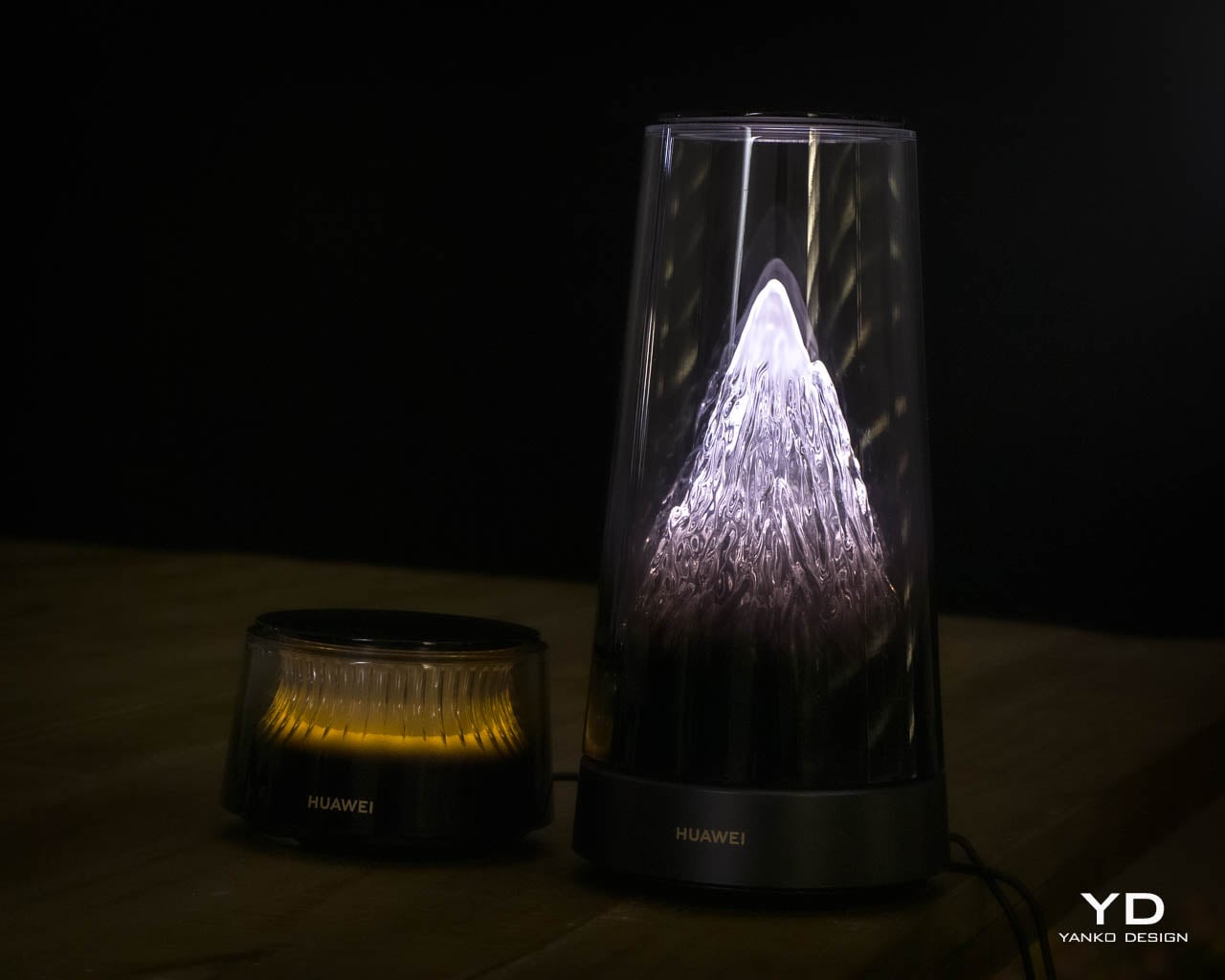
That ambition has limits worth naming. The design rewards specific interiors-modern, curated, comfortable with statement objects-and punishes others. A room already crowded with visual noise may find the router’s glow overwhelming. A household that treats connectivity as invisible utility may resent paying for aesthetics they plan to hide. The placement tension between signal optimization and display value will frustrate anyone expecting both without compromise.
Huawei built a router for people who want their home network to carry emotional weight through form and material alone. The system achieves this without abandoning its technical identity: Wi-Fi 7 support, six integrated antennas, active cooling, and mesh scalability all remain intact beneath the decorative surface. For everyone else, the category’s quieter options remain available.
The post Huawei Wi Fi 7 Mesh Router Turns Connectivity into Sculptural Lighting first appeared on Yanko Design.
Huawei’s Dubai Trio: A Foldable That Disappears, Earbuds That Double Down, and a Router Disguised as a Mountain
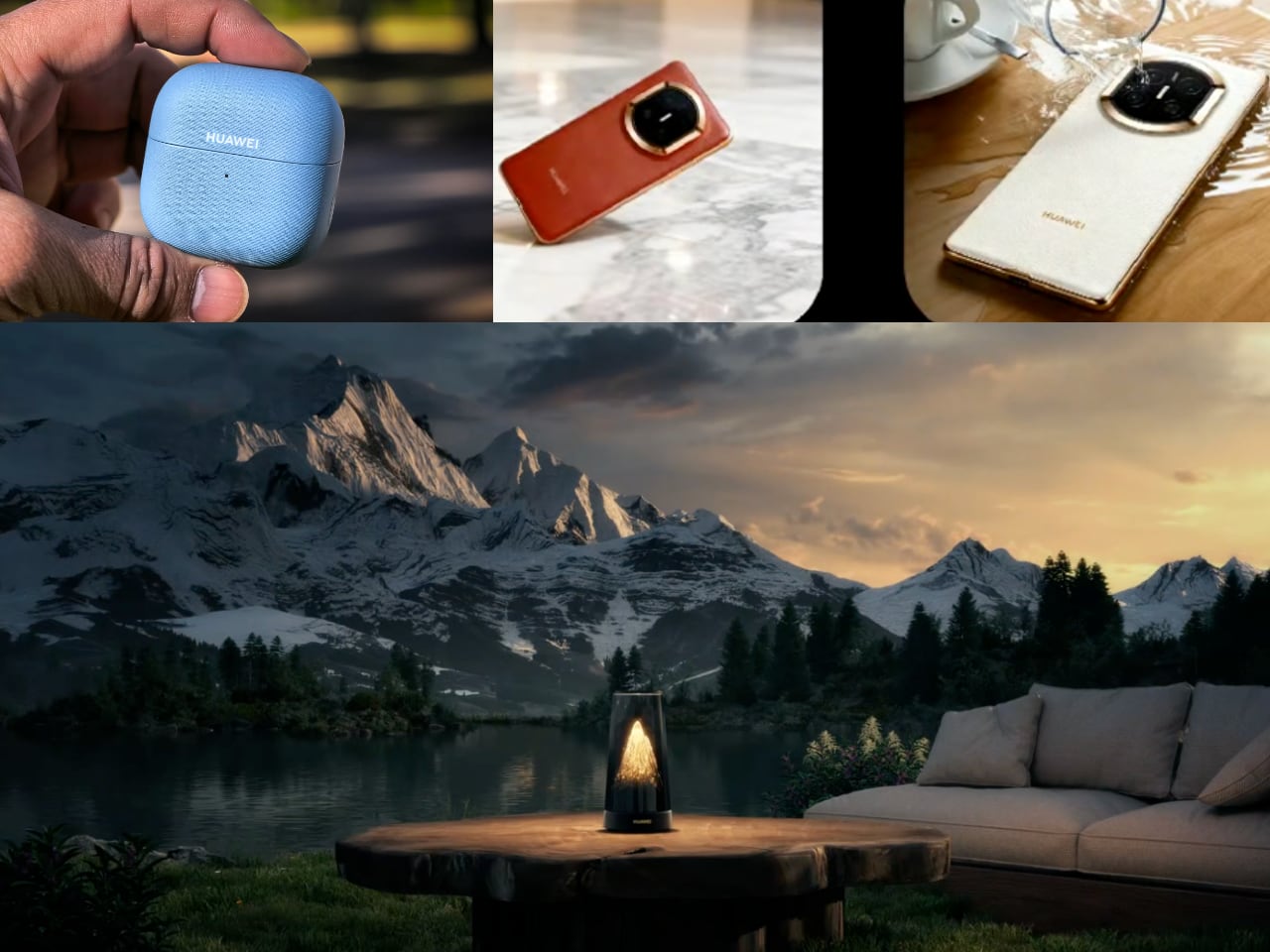
Five years into the foldable smartphone experiment, thinness remains the singular obsession. Huawei just crossed a threshold that reframes the conversation. The Mate X7, unveiled today at the company’s Dubai global launch alongside the FreeClip 2 earbuds and a Wi-Fi 7 mesh router, measures 4.5mm when unfolded. That figure matters less as specification than as experience: the fold becomes incidental to use rather than the defining characteristic of handling.
The Mate X7: Engineering the Fold Away
Huawei traces its foldable lineage to 2019, positioning itself as the category’s original commercializer. Six generations later, the design philosophy has crystallized into something specific and unambiguous: make the fold invisible to daily interaction. Quad-curved edges. A 4.5mm unfolded profile. Under 10mm closed. These dimensions place the Mate X7 closer to conventional smartphone territory than any previous book-style foldable has achieved. The engineering ambition centers not on what the fold enables, but on eliminating what the fold disrupts.
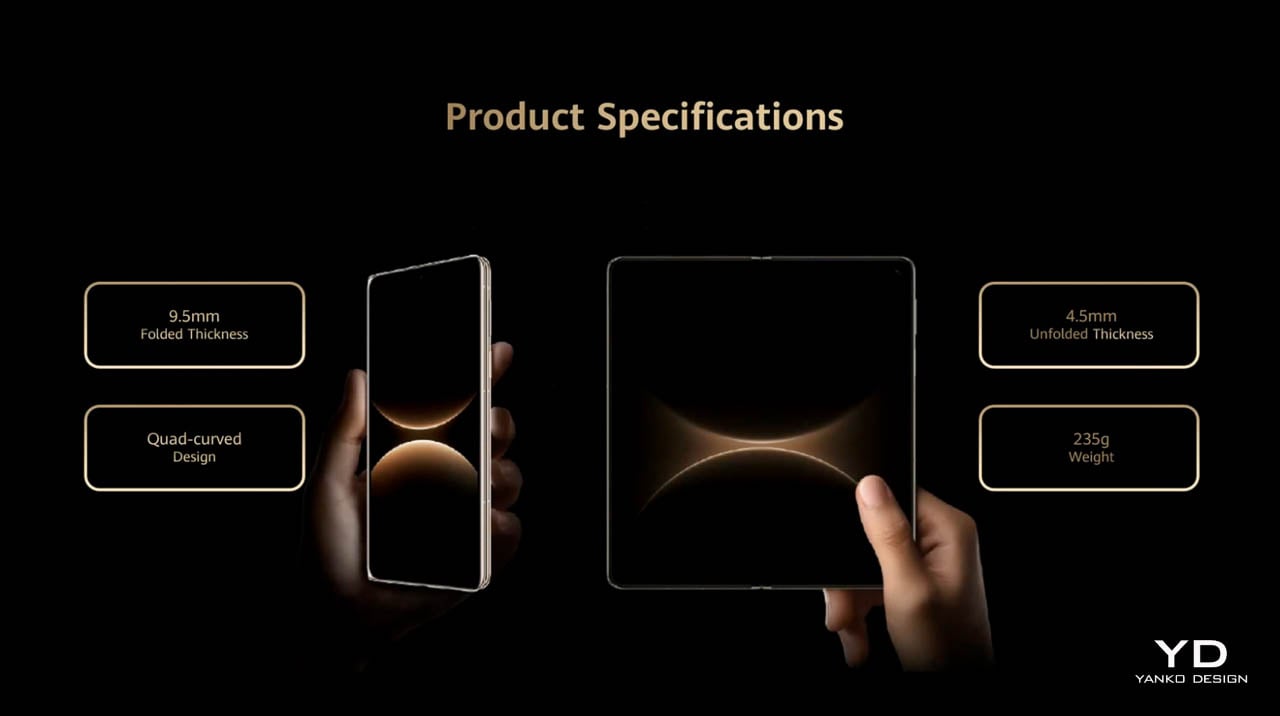
Where previous generations housed cameras in circular modules, the Time-Space Portal introduces flat edges to the protrusion. Huawei weaves between 900 and 1,700 threads into the finish, creating a textile-like visual texture that catches light across micro-patterns. This thread-woven treatment ships exclusively in China. Global variants arrive in standard colorways. The material strategy treats the camera bump as design opportunity rather than engineering compromise, an approach that signals continued investment in tactile differentiation where competitors minimize and apologize.
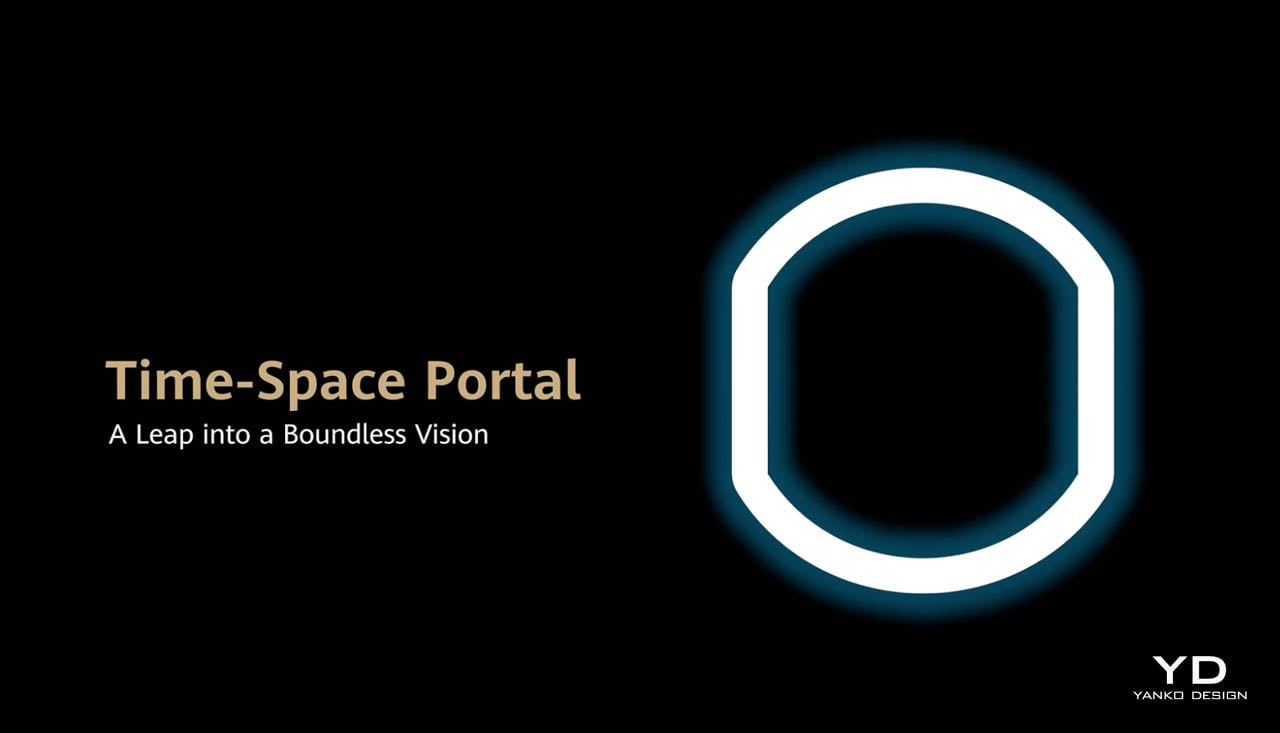

Both displays run at 2.4K resolution. Adaptive refresh spans 1Hz to 120Hz. The outer screen peaks at 3,000 nits while the inner reaches 2,500 nits, and high-frequency PWM dimming addresses the eye strain concerns that have plagued OLED panels since their adoption. These specifications alone would be unremarkable in any conventional flagship. Achieving them across two flexible panels within a 4.5mm envelope represents the actual engineering story, the quiet difficulty hidden beneath familiar numbers.
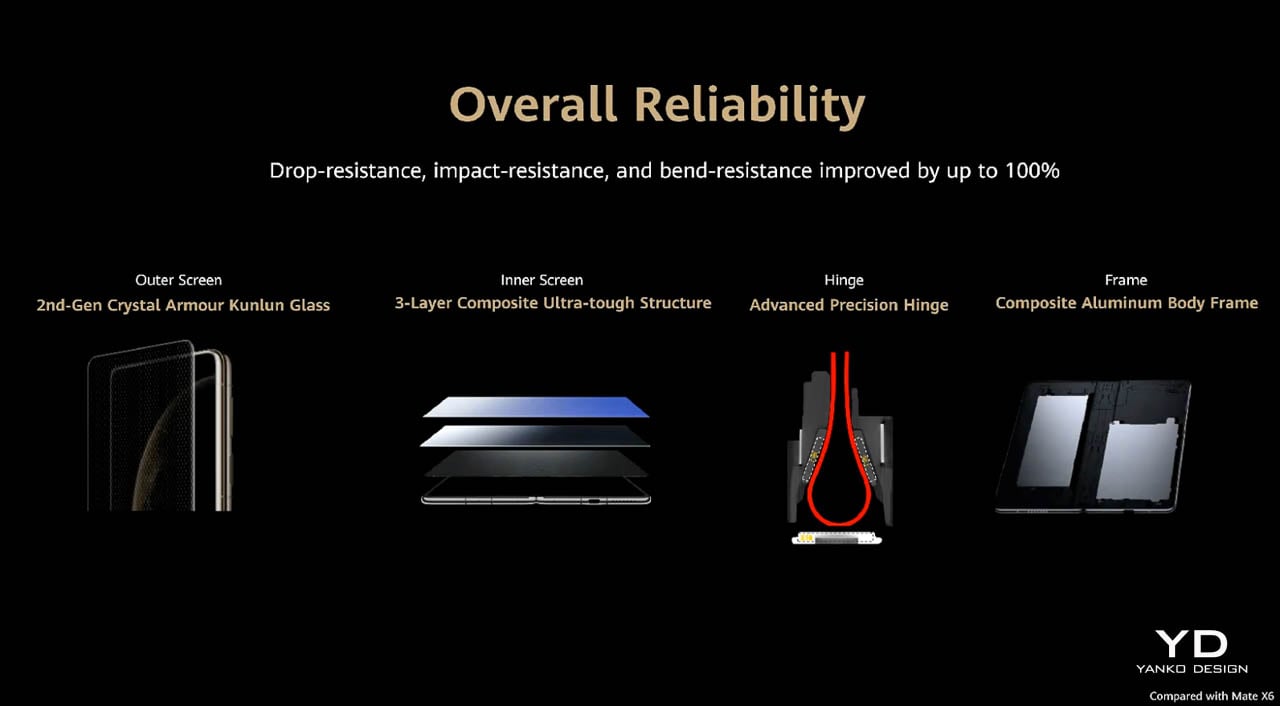
Durability targets the foldable’s historical weakness with measurable aggression. Drop resistance improved 100% over the previous generation according to Huawei’s internal testing. Impact resistance matched that improvement. The outer glass uses second-generation crystal armor technology. The inner screen employs a three-layer composite structure including a non-Newtonian fluid layer, material that increases rigidity under sudden impact pressure while remaining flexible during normal operation. Hinge redesign contributes over 100% improvement in bend resistance. IP59 certification covers high-temperature and water-jet resistance when open, with IP8 rating when the device closes.
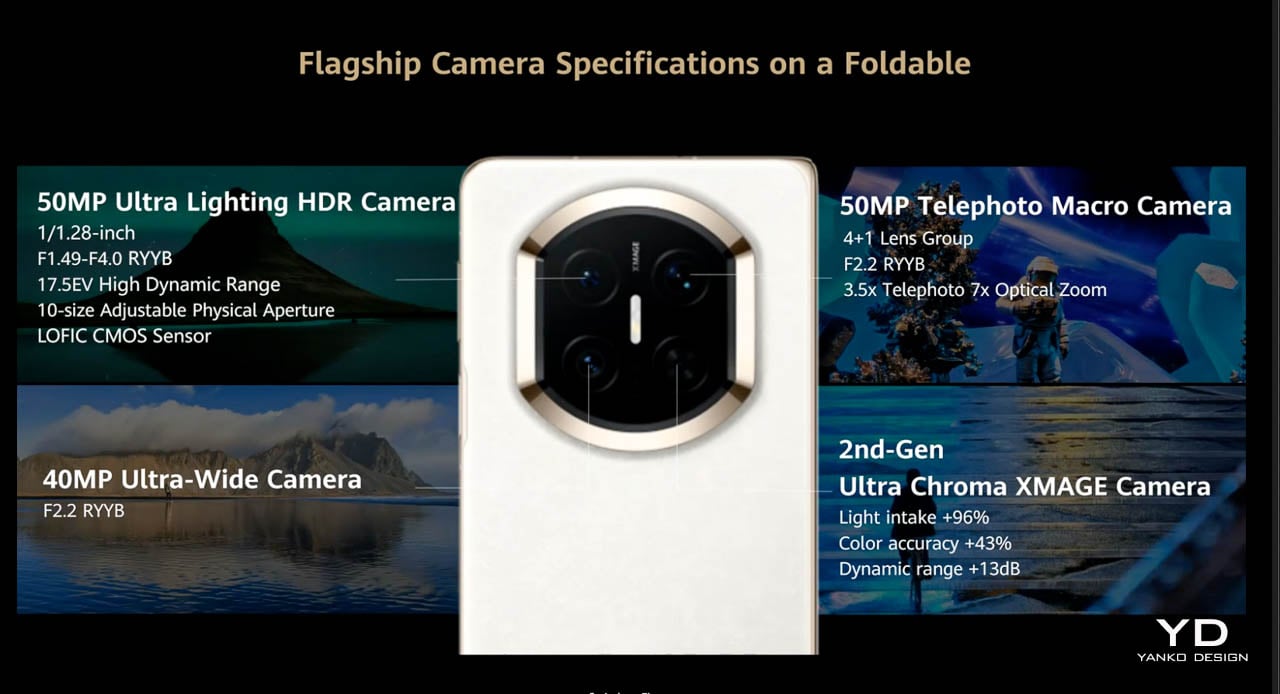
Camera architecture compresses flagship-grade optics into 26% less volume than equivalent modules. A 50MP main sensor pairs with variable mechanical aperture reaching f/1.49. The 50MP telephoto deploys a vertical periscope structure, a first for the foldable category, achieving 3.5x optical zoom within constrained depth. Light intake improved 127% through these spatial optimizations. Second-generation ultrachroma sensors handle color science while LOPIC technology extends dynamic range for stills and video alike.
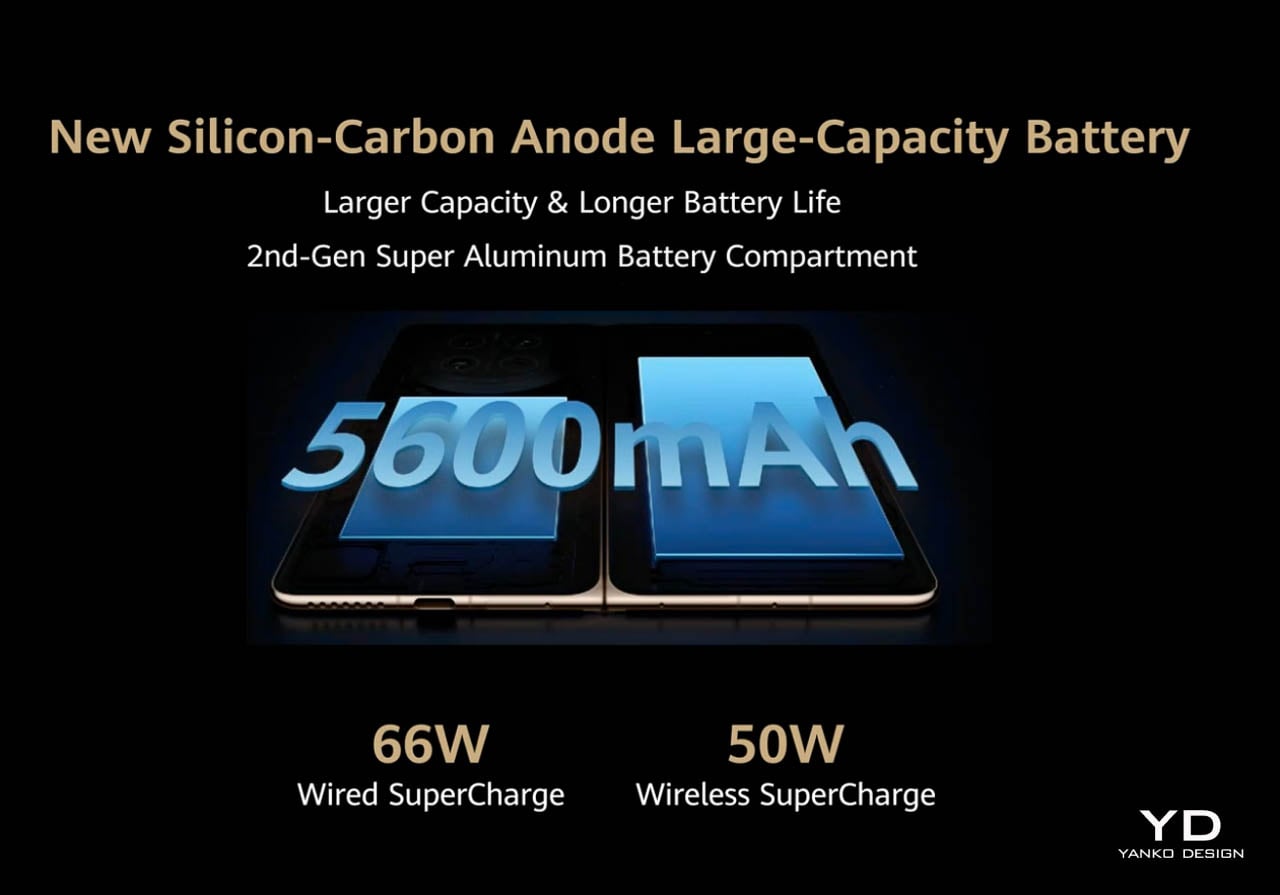
Battery capacity reaches 5,300mAh for global markets. The Chinese variant ships at 5,600mAh, the difference attributed to European import regulations that cap certain cell chemistries. Wired charging supports 66W. Wireless reaches 50W. Thermal management relies on an 18% larger vapor chamber paired with graphene-based loop dissipation. Additional antennas distributed around the device edges address connectivity challenges arising when folding reorients internal components relative to cell towers and Wi-Fi access points.
Wi-Fi 7 Mesh: Infrastructure as Object
Router design typically optimizes for invisibility. Mesh systems tuck behind furniture or blend into wall-mounted anonymity. Huawei inverts this assumption entirely. The main unit mimics a mountain range enclosed within a transparent dome. Extender units feature indirect lighting resembling whisky glasses set on a shelf. Touch controls on each surface adjust lighting modes and network settings. The design explicitly treats network infrastructure as decorative object rather than functional necessity demanding concealment.
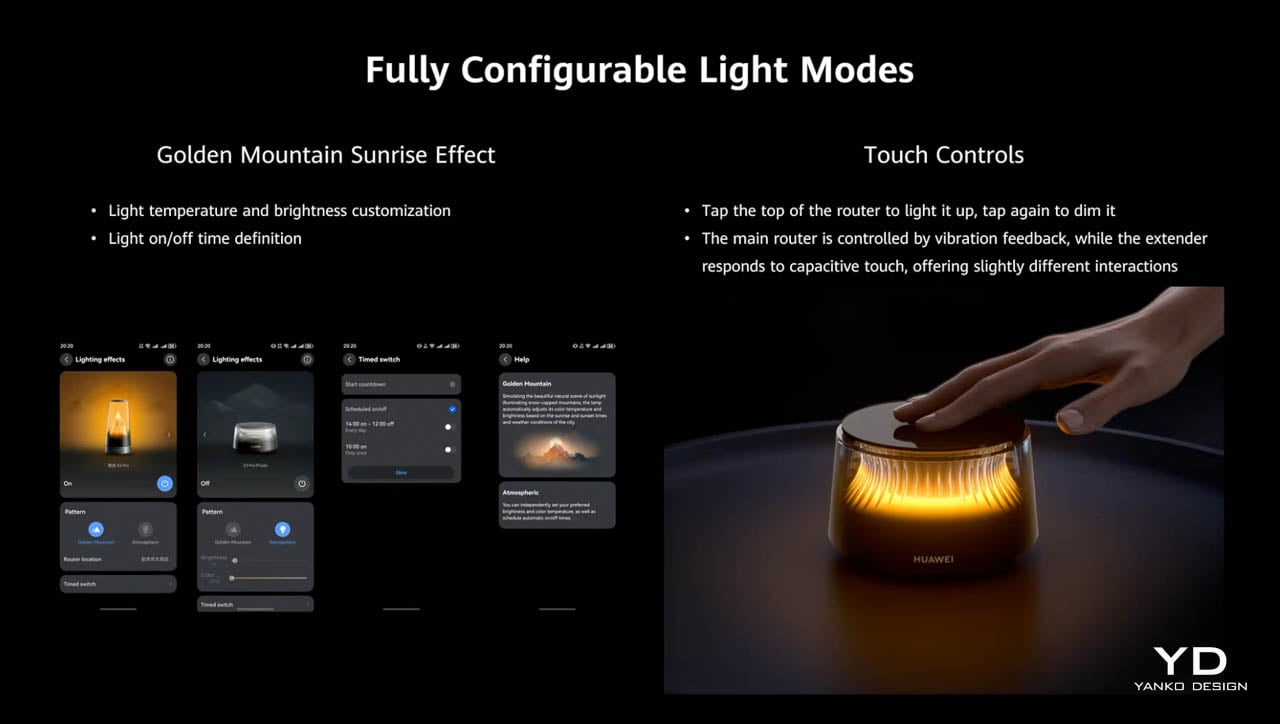
Technical specifications support the visual ambition without contradiction. Wi-Fi 7 operates with six antennas, three at 2.4GHz frequency. 4K SQAM and Multilink Operation enable simultaneous connections across frequency bands for devices supporting the standard. The main router includes active cooling via internal fan for sustained high-throughput scenarios. Up to two extenders pair with each base unit.

This approach acknowledges domestic reality: mesh routers occupy visible positions in living spaces. Huawei treats that visibility as opportunity for intentional form rather than problem requiring solution.
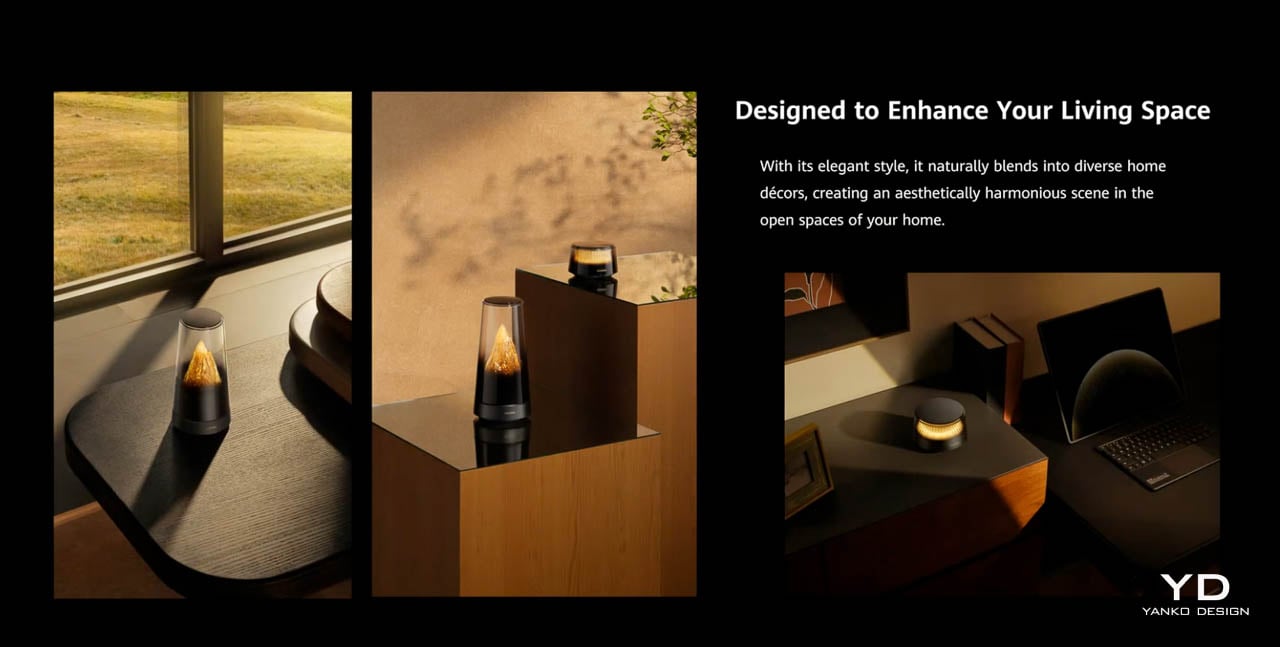
FreeClip 2: Iteration on a Proven Form
Three million first-generation FreeClip units shipped, establishing category viability that justifies continued investment. Open-ear designs occupy a specific niche: awareness of surroundings traded against audio immersion. The sequel addresses the original’s primary limitations through incremental refinement. Weight dropped 9% to 4.1 grams per earbud. Case dimensions shrank 11% while narrowing 17%. The redesigned Seabridge improves comfort across extended wear sessions where the previous generation began to fatigue.
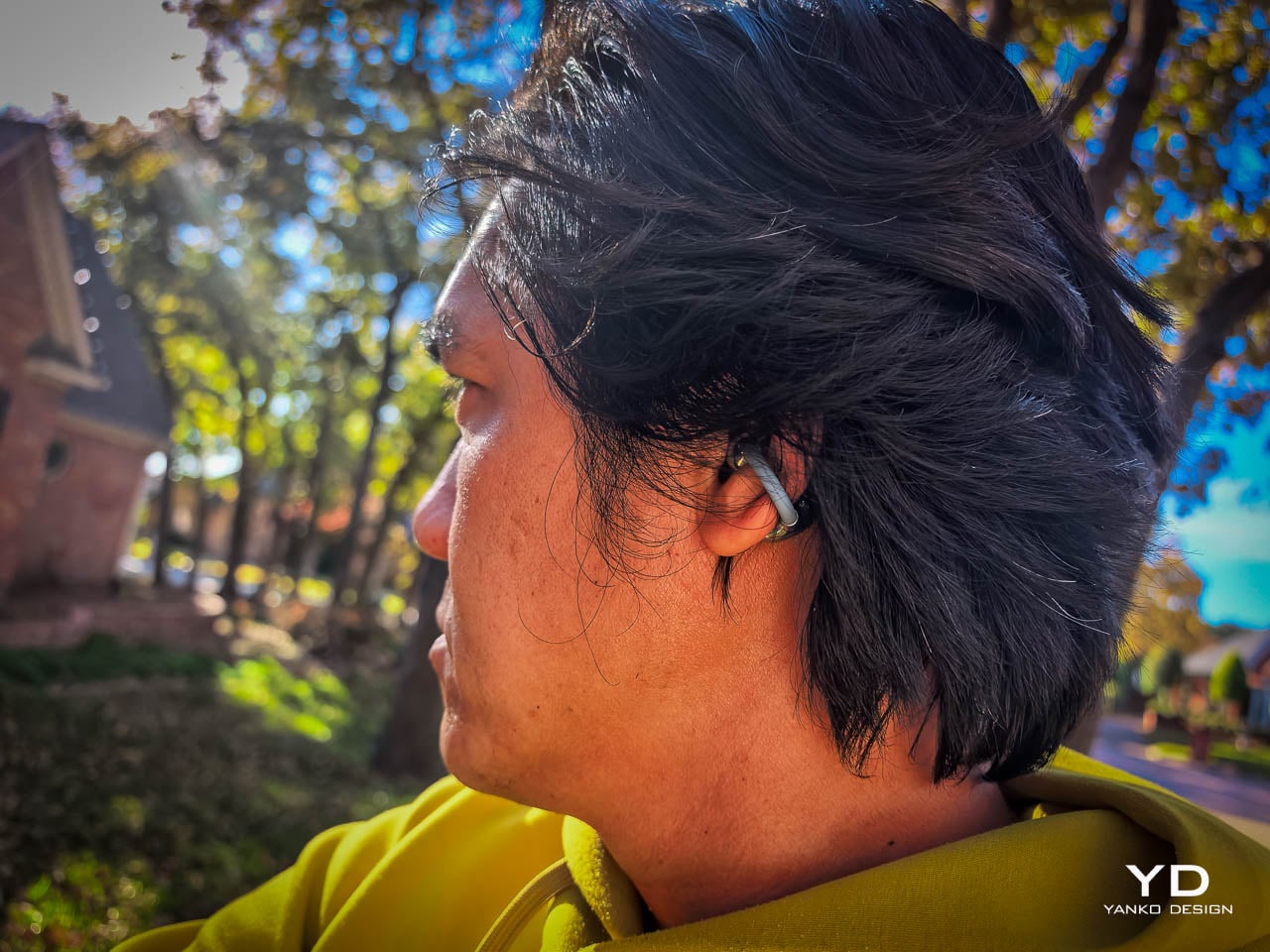
Dual 11mm diaphragms share a single magnetic circuit, an engineering choice that doubles bass output compared to the previous generation while reducing acoustic ball size by 11%. The architecture trades spatial efficiency for low-frequency presence that open-ear designs historically lacked. Battery life extends to 9 hours per earbud and 38 hours total with case, improvements of one and two hours respectively. IP57 certifies the earbuds while the case carries IP54.
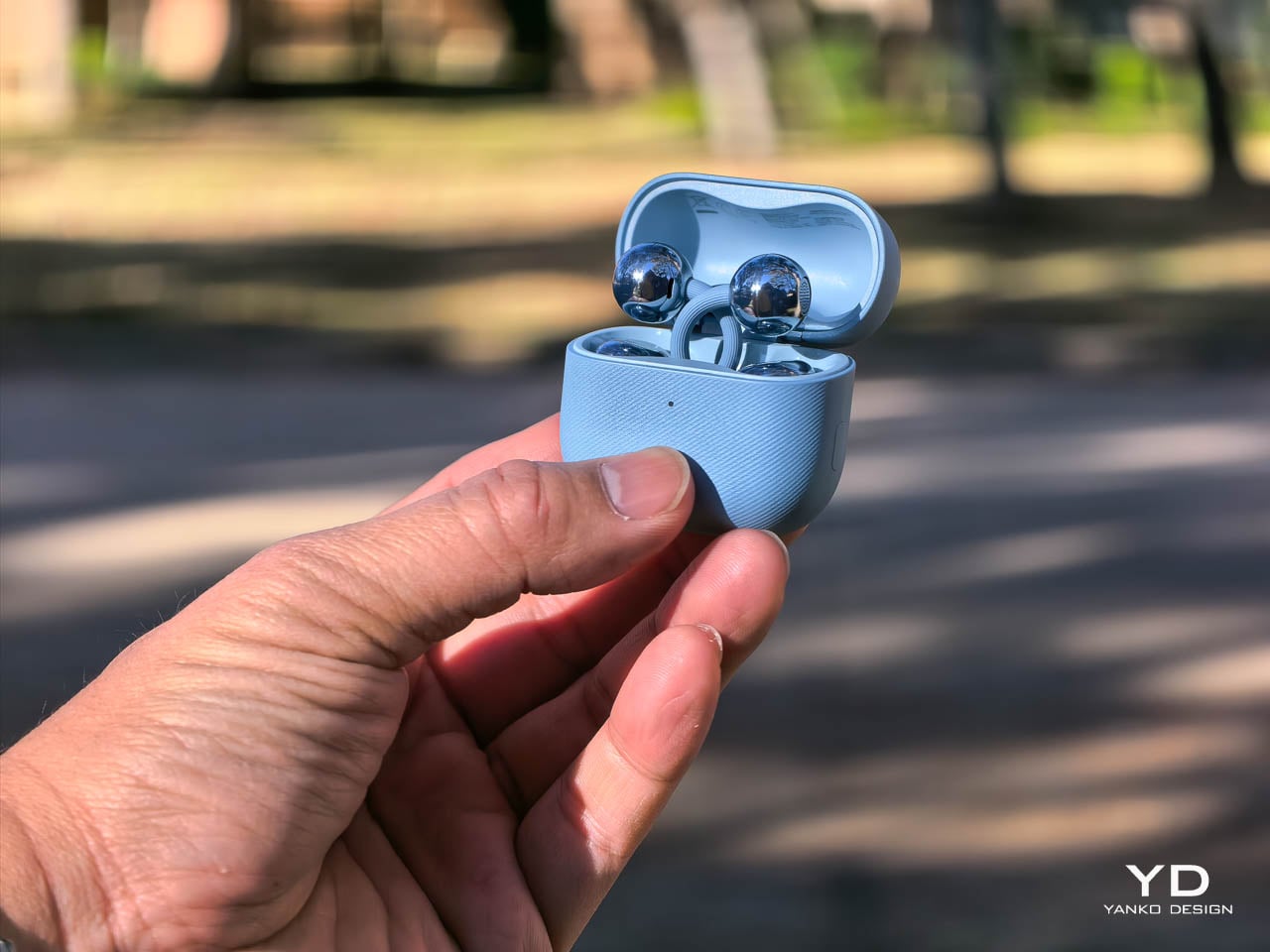
For deeper examination of the FreeClip 2’s material execution and acoustic performance, my full review covers the dual-diaphragm engineering and comfort improvements in detail.
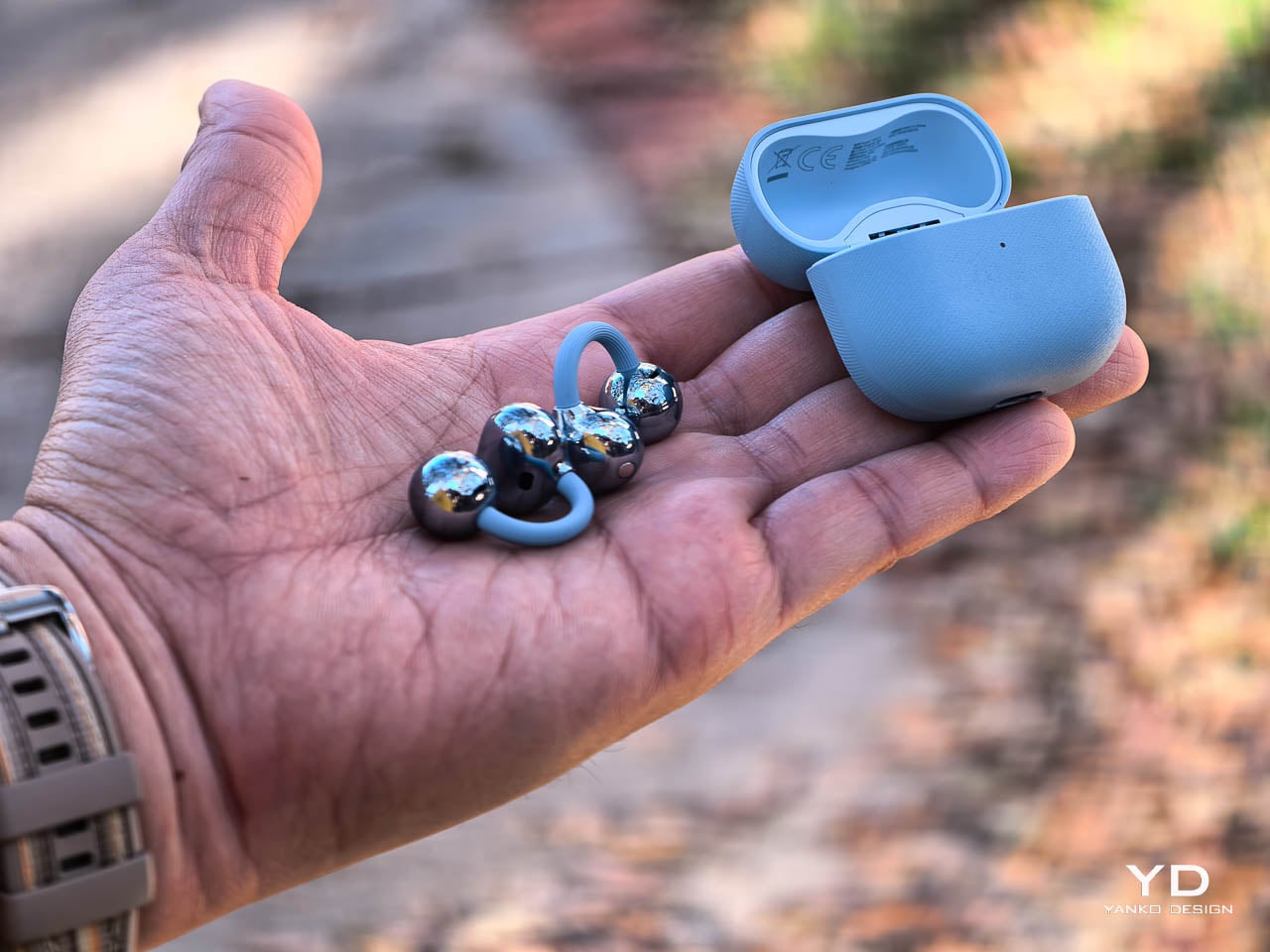
Automatic left/right detection, swipe volume controls, and head gesture support complete the interaction model. Huawei Audio Connect supports iOS and Samsung devices, with no Google Play availability announced. Color options span Denim Blue, Feather Sand White, Modern Black, and Rose Gold.

Market Position
Global launch proceeds December 11, 2025 from Dubai. Pricing remains unannounced. Product configuration suggests premium positioning matching or exceeding the previous generation’s placement.
For the foldable category broadly, the Mate X7’s dimensional achievements demonstrate that thinness progression continues regardless of engineering complexity. The mesh router and FreeClip 2 complete an ecosystem play: smartphone, audio, and home networking under unified design language. Huawei signals capability breadth alongside flagship ambition, using Dubai as statement of global market re-entry after years of constraint.
The post Huawei’s Dubai Trio: A Foldable That Disappears, Earbuds That Double Down, and a Router Disguised as a Mountain first appeared on Yanko Design.
Huawei Unfolds New Flagship Lineup at Dubai Event
The Huawei X3 Pro Wi-Fi Router Is What Happens When a Mesh Router Meets a Lava Lamp
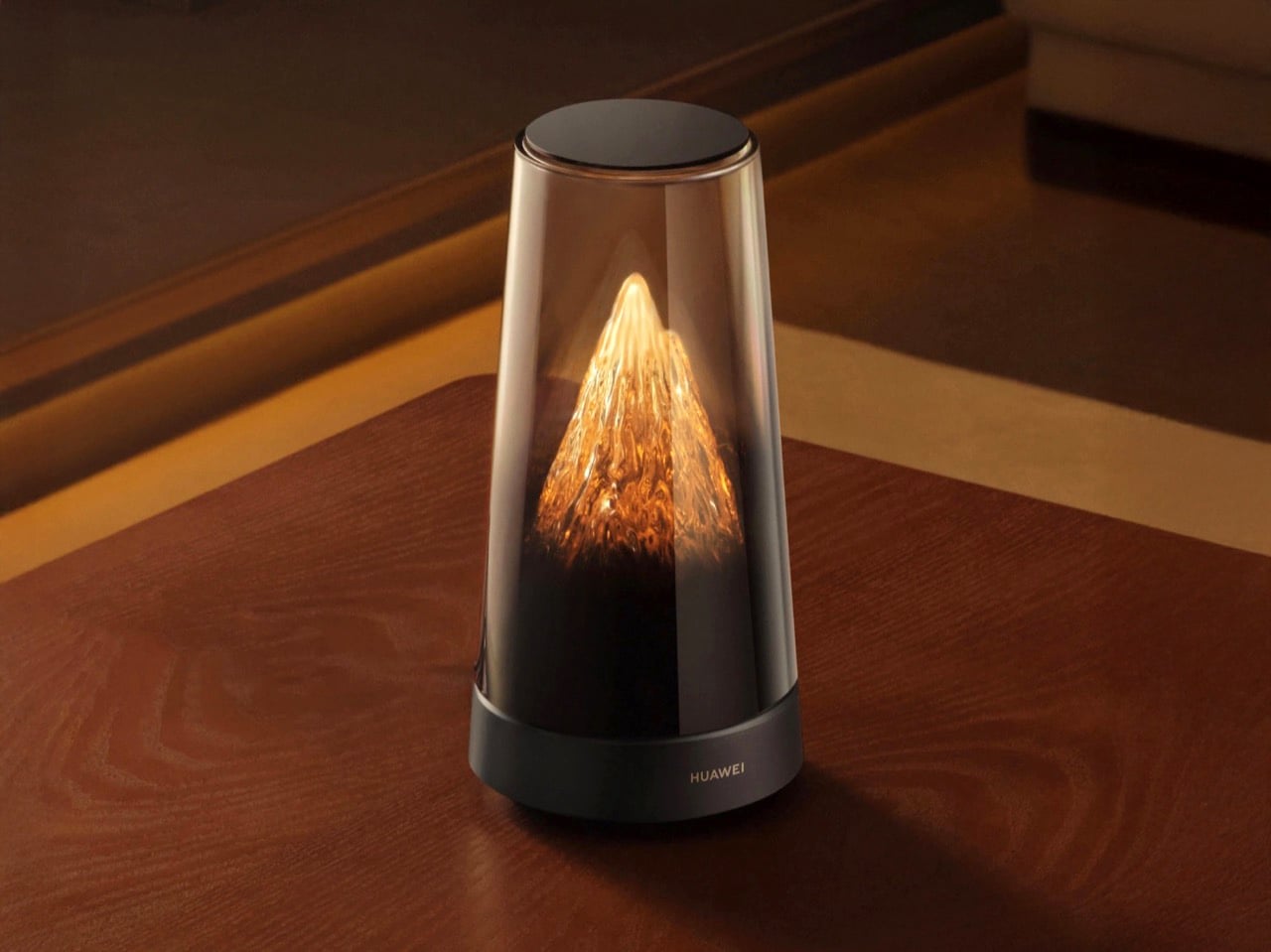
Not many people know this, but there is a wall filled with lava lamps in San Francisco that helps keep our internet secure. Cloudflare’s office lobby has a “Wall of Entropy,” a bank of about 100 lava lamps whose constantly shifting, gooey patterns are filmed by a camera. The video feed is converted into a stream of unpredictable, random bytes that helps create cryptographic keys to encrypt a significant chunk of the world’s web traffic. It is a brilliant, whimsical solution to a serious digital problem and perhaps the first instance of a piece of home decor serving a grander purpose in our connected world. Huawei’s new X3 Pro, a sculptural tabletop mesh router that looks like a tiny, self-contained icy mountain, might just be the second.
For years, the router has been the ugliest, most unloved piece of tech in the house. A black or white plastic box bristling with spidery antennas and blinking lights, it is the sort of device you shove behind a bookshelf or a plant, hoping no one notices it. The irony, of course, is that the best place for a router is out in the open, where its signal can propagate freely. Huawei seems to have taken this problem to heart, deciding that if a router has to be visible, it might as well be beautiful. The X3 Pro is the result: a tall, translucent cone that houses a textured, mountain-like sculpture. It looks less like networking hardware and more like an art glass piece you would find in a museum gift shop.
Designer: Huawei
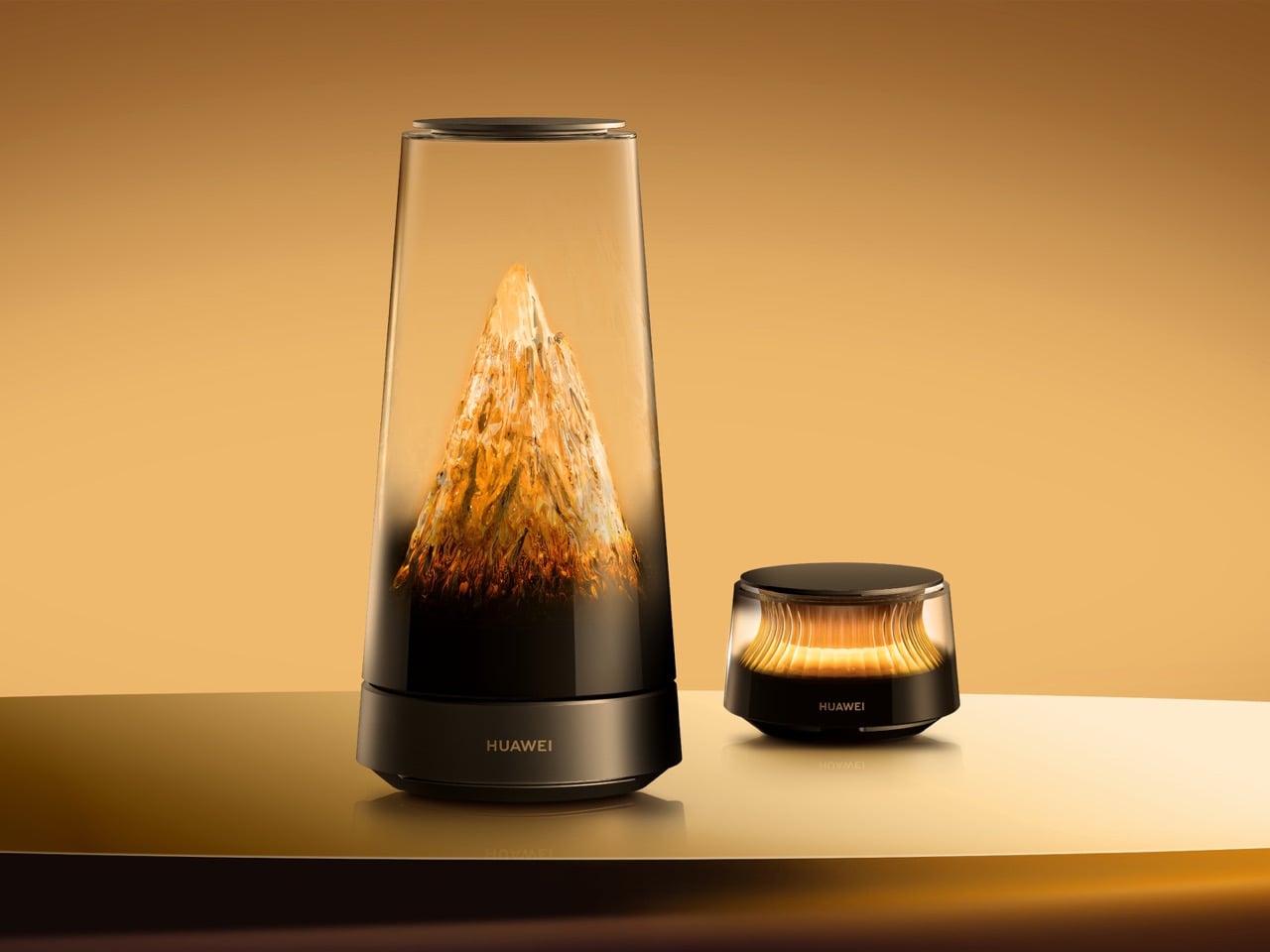
The design is not just for show; it is deeply functional. The antennas, the components that are usually the most visually offensive part of a router, are cleverly hidden inside that central mountain core. The lighting is not a series of distracting blue and green status LEDs but a soft, ambient glow that shifts between warm, fiery amber and cool, glacial white throughout the day, mimicking a sunrise over a peak. It is designed to be a conversation piece, a calm presence on a coffee table that encourages you to place it right in the center of your living space, which is exactly where it will perform best.
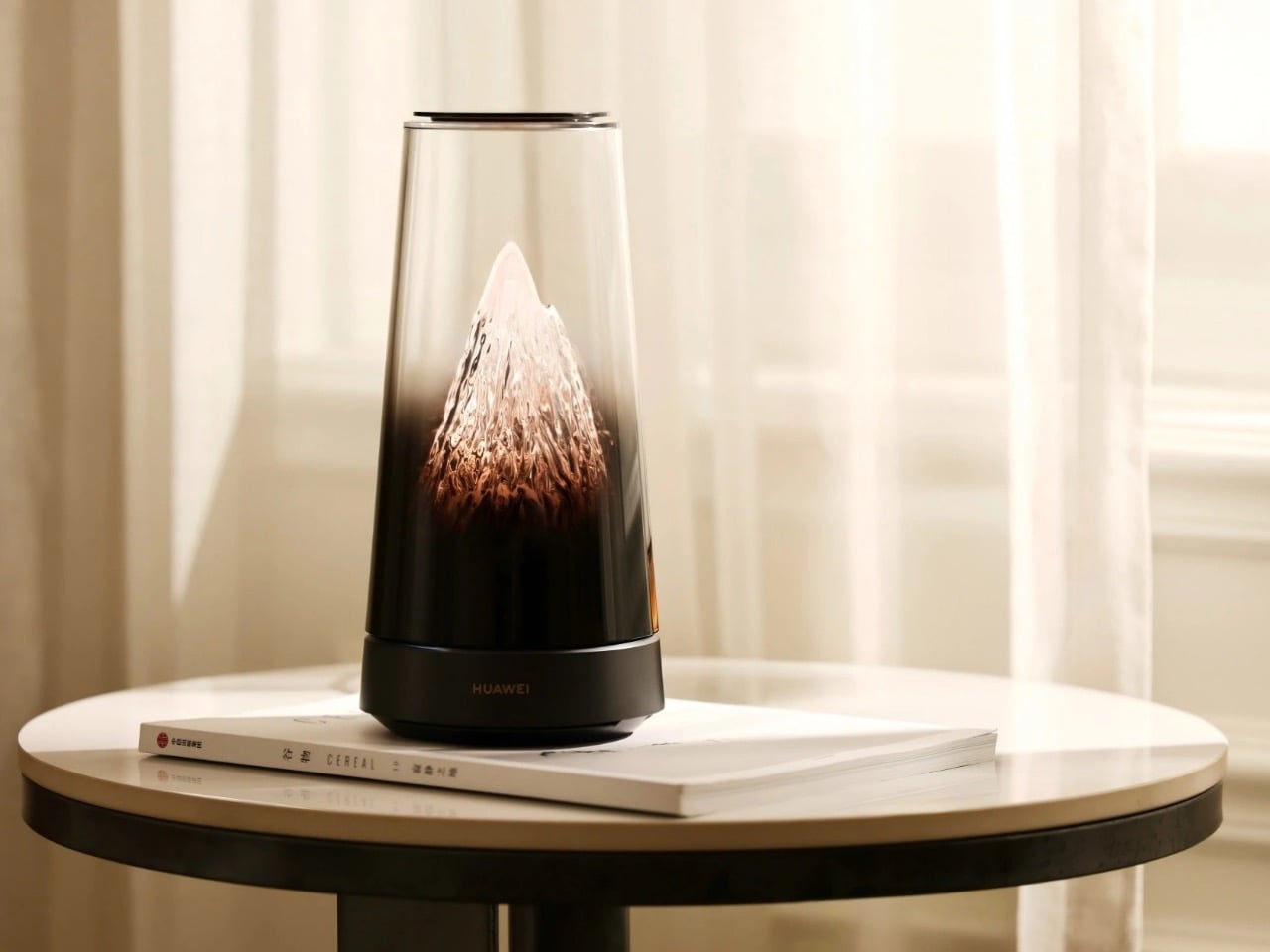
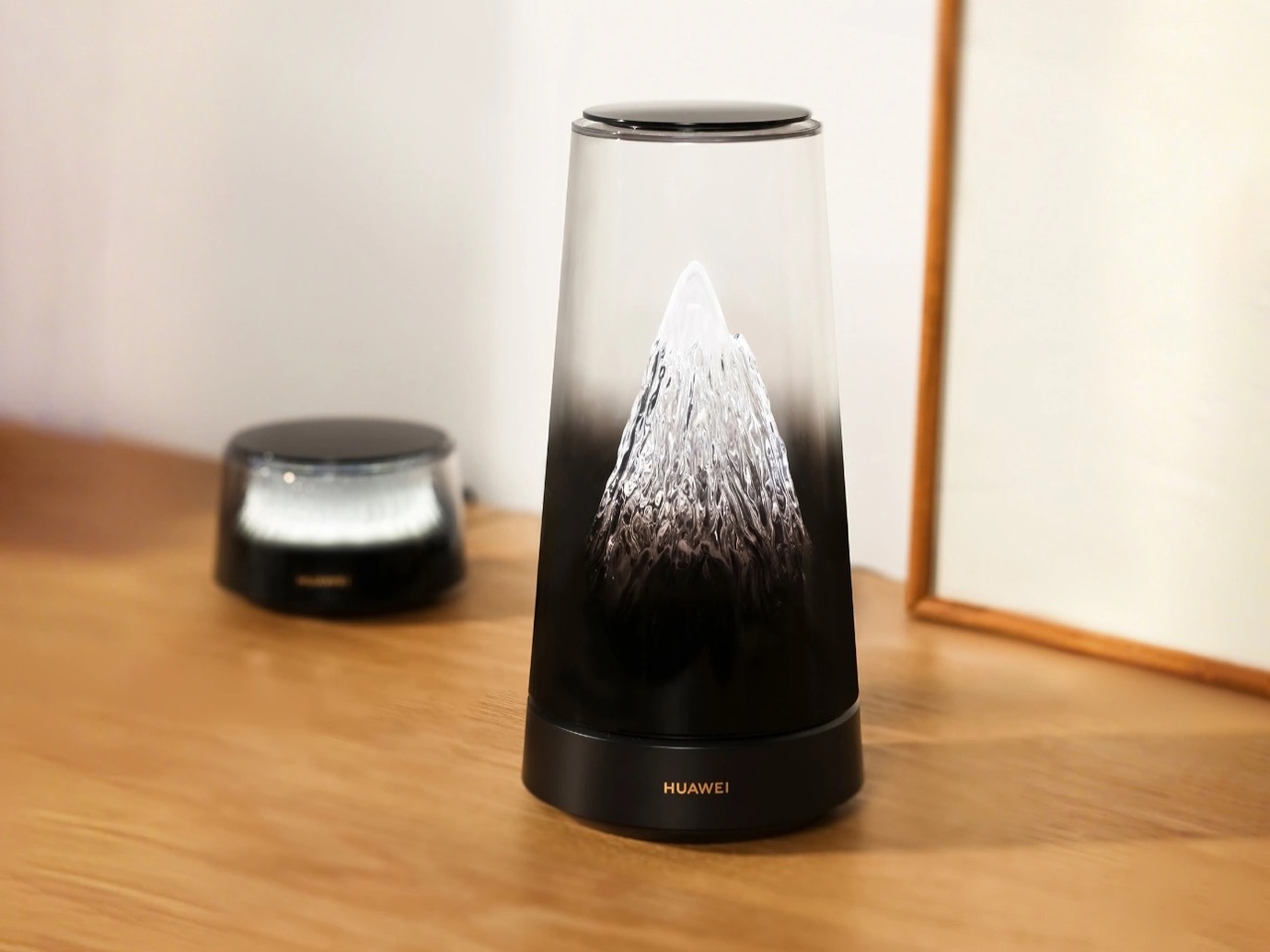
Beneath that serene exterior, the X3 Pro is a thoroughly modern piece of networking equipment. It is a Wi-Fi 7 system, offering combined theoretical speeds of up to 3570 Mbps across its 2.4 GHz and 5 GHz bands. The main unit is equipped with two 2.5 Gbps Ethernet ports and one 1 Gbps port, providing enough bandwidth for multi-gig internet plans or a high-speed connection to a network-attached storage (NAS) drive.
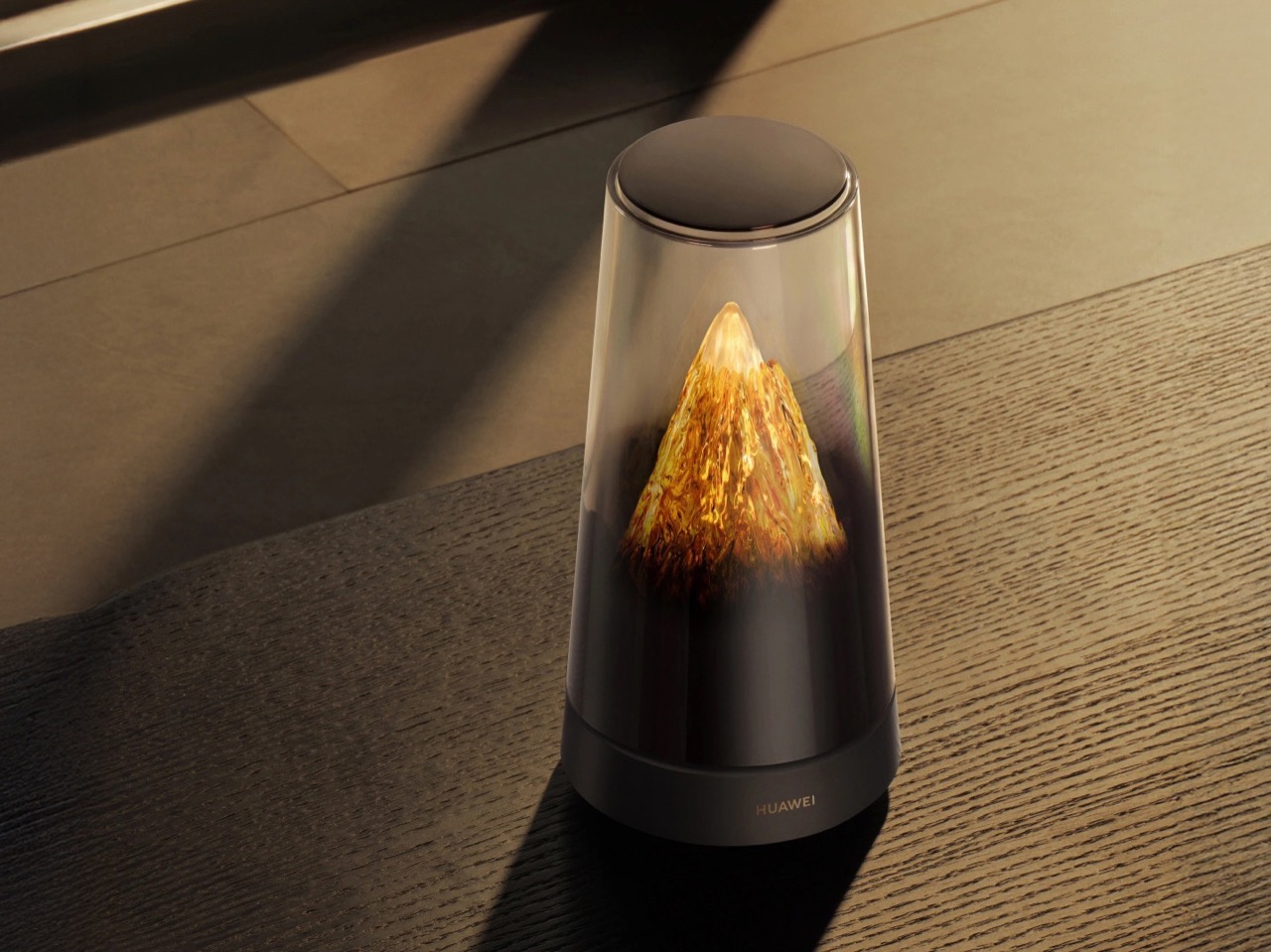
Perhaps its most practical feature for challenging homes is its hybrid mesh technology. The system comes with a smaller, equally elegant satellite node. In addition to using Wi-Fi to create a mesh network, the X3 Pro supports PLC 3.0, or Power Line Communication. This allows the router and its nodes to use your home’s existing electrical wiring as a stable, wired backhaul. For anyone living in a home with thick concrete or brick walls that kill Wi-Fi signals, this is a game-changer, offering a more reliable connection between nodes than Wi-Fi alone can provide.

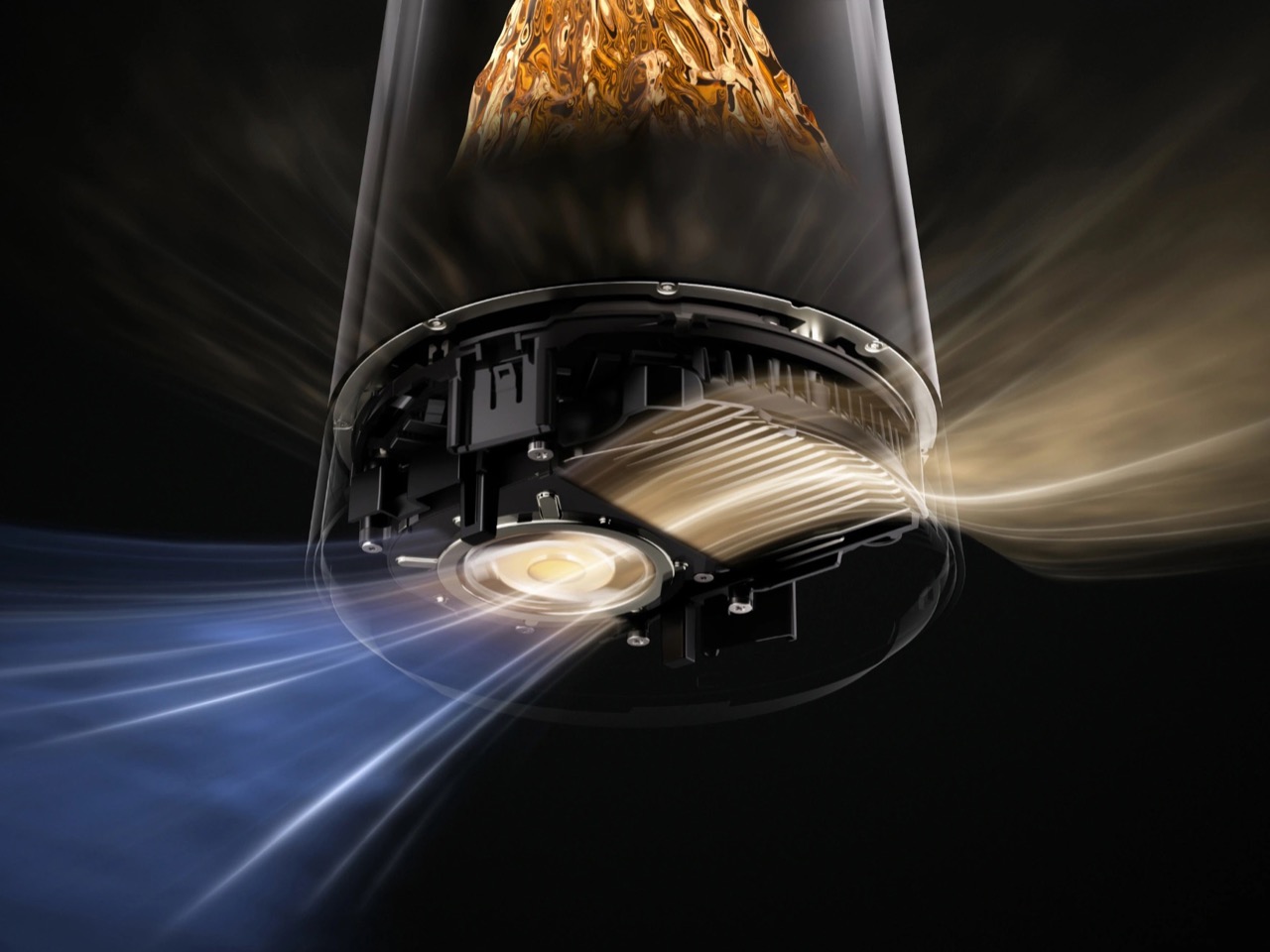
Everything is managed through Huawei’s Smart Life app, which handles setup, security features like WPA3, and specialized modes like Game Turbo for reducing latency. It is a complete package that marries high-end performance with a design that finally respects the aesthetics of a modern home. The X3 Pro makes a compelling argument that the most important devices in our lives do not have to be ugly. Just like those lava lamps in San Francisco, it proves that sometimes the best technology is the kind you actually want to look at.
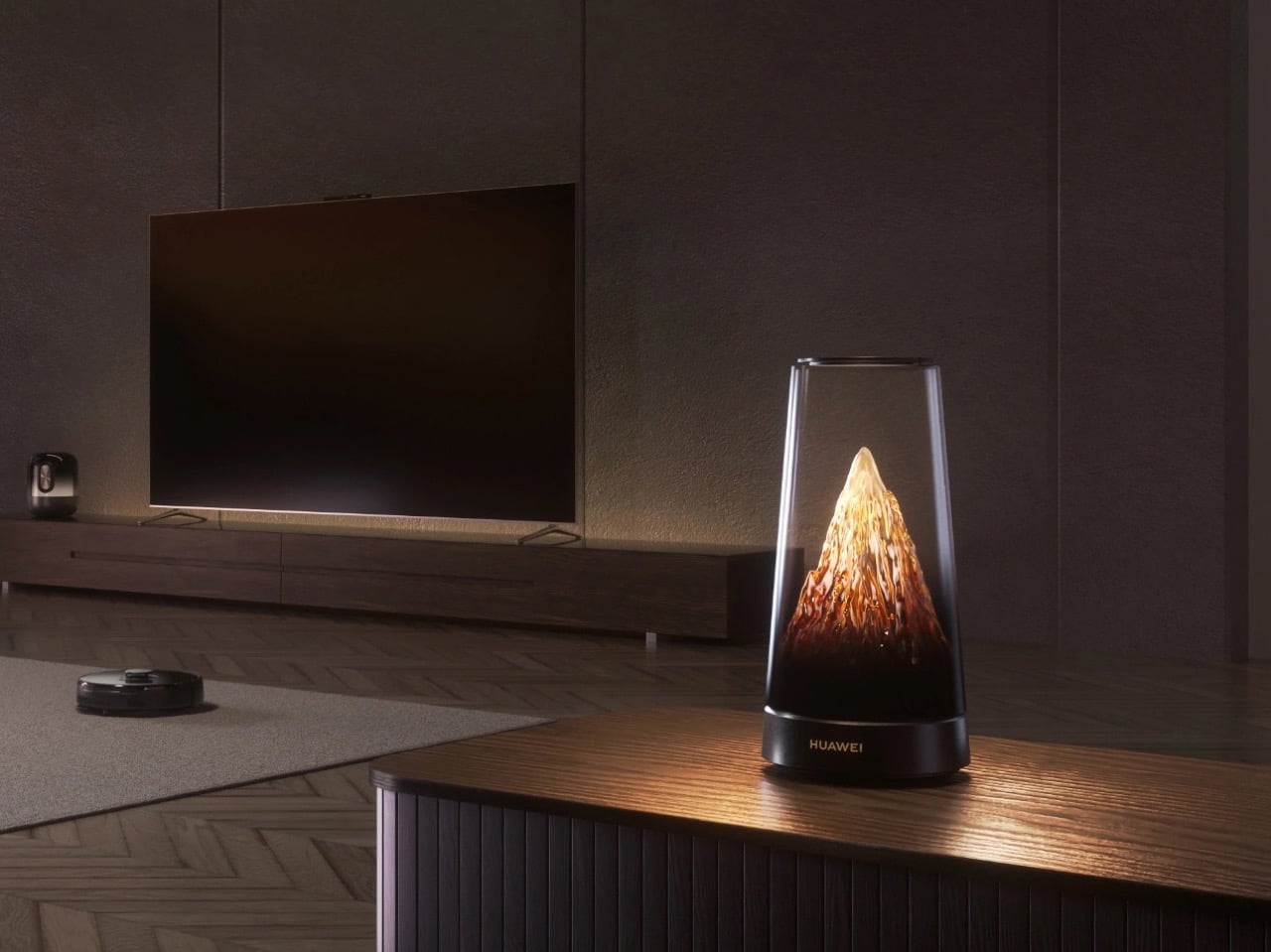
The post The Huawei X3 Pro Wi-Fi Router Is What Happens When a Mesh Router Meets a Lava Lamp first appeared on Yanko Design.
Huawei’s 8,000-Nit Display Is a Design Statement Disguised as a Spec Sheet
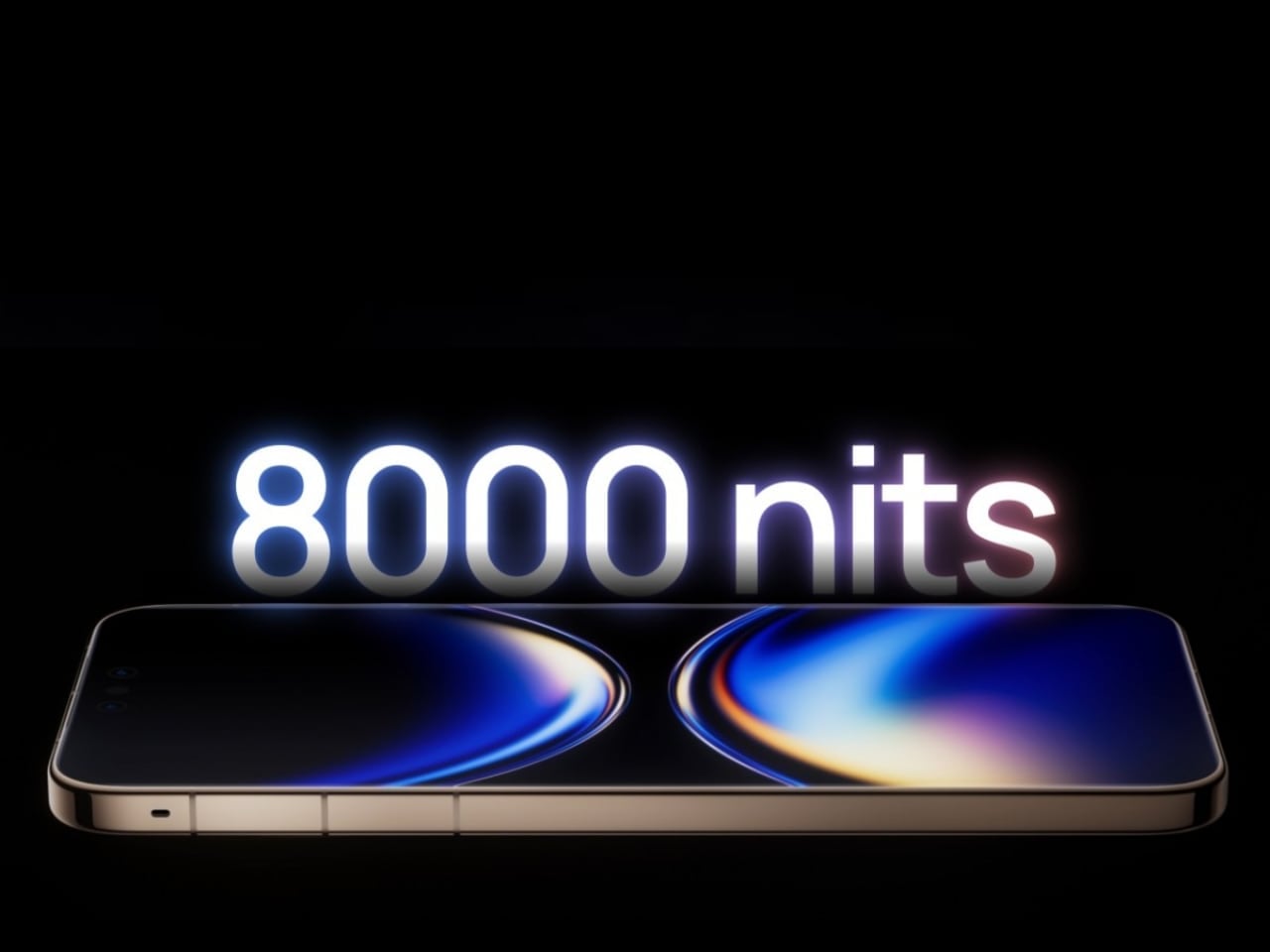
Smartphones have become spec sheet battlegrounds. Bigger megapixels. Faster charging. Higher refresh rates. The numbers climb while the actual user experience often stays flat.
Designer: Huawei
Huawei’s Mate 80 Pro Max arrives with an 8,000-nit peak brightness claim that obliterates every competitor on paper. But peel back the marketing headline and something more interesting emerges: a deliberate design philosophy that treats the display as the phone’s defining character trait, not just another specification to maximize.
When Engineering Becomes Industrial Design
The dual-layer OLED panel represents Huawei’s answer to a fundamental physics problem. Traditional OLED displays push a single emissive layer harder to achieve brightness, generating excess heat and potentially shortening panel lifespan. Huawei’s solution stacks two OLED layers, distributing thermal and electrical load across twice the surface area while hitting brightness numbers that single-layer panels cannot match. The engineering choice has profound visual consequences that extend far beyond the headline specification.
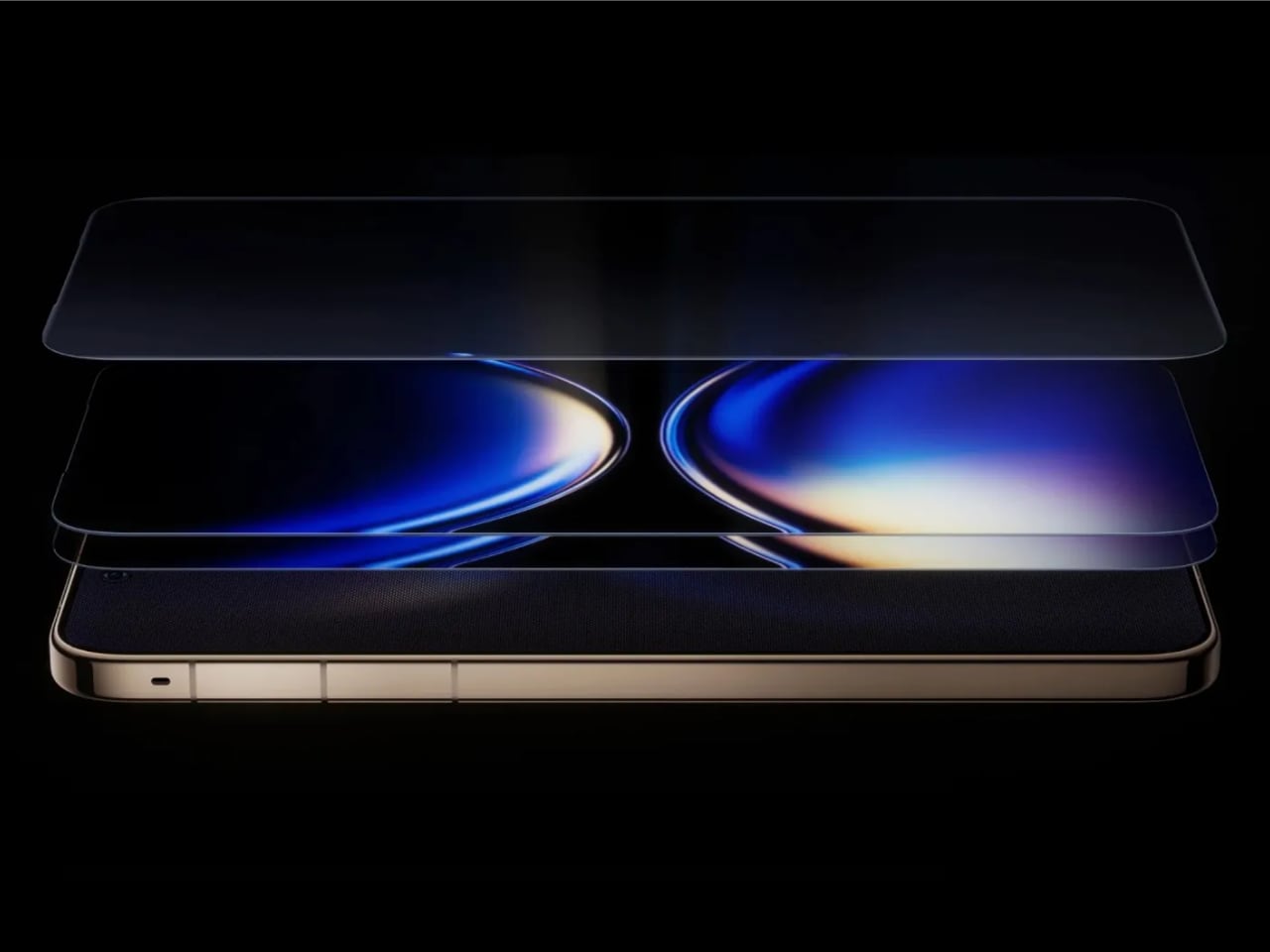
HDR content transforms on a dual-layer panel. Highlights carry genuine intensity while shadows retain depth rather than washing out, creating an almost three-dimensional quality to images that photographers and videographers will immediately recognize. The smartphone has become our primary camera, editor, and viewing screen, and Huawei designed this display to serve all three roles simultaneously.
Eye comfort gets attention too. The 1440Hz PWM dimming rate eliminates the invisible flicker that causes strain during extended low-brightness use, addressing one of OLED technology’s persistent criticisms that cheaper panels still struggle with.
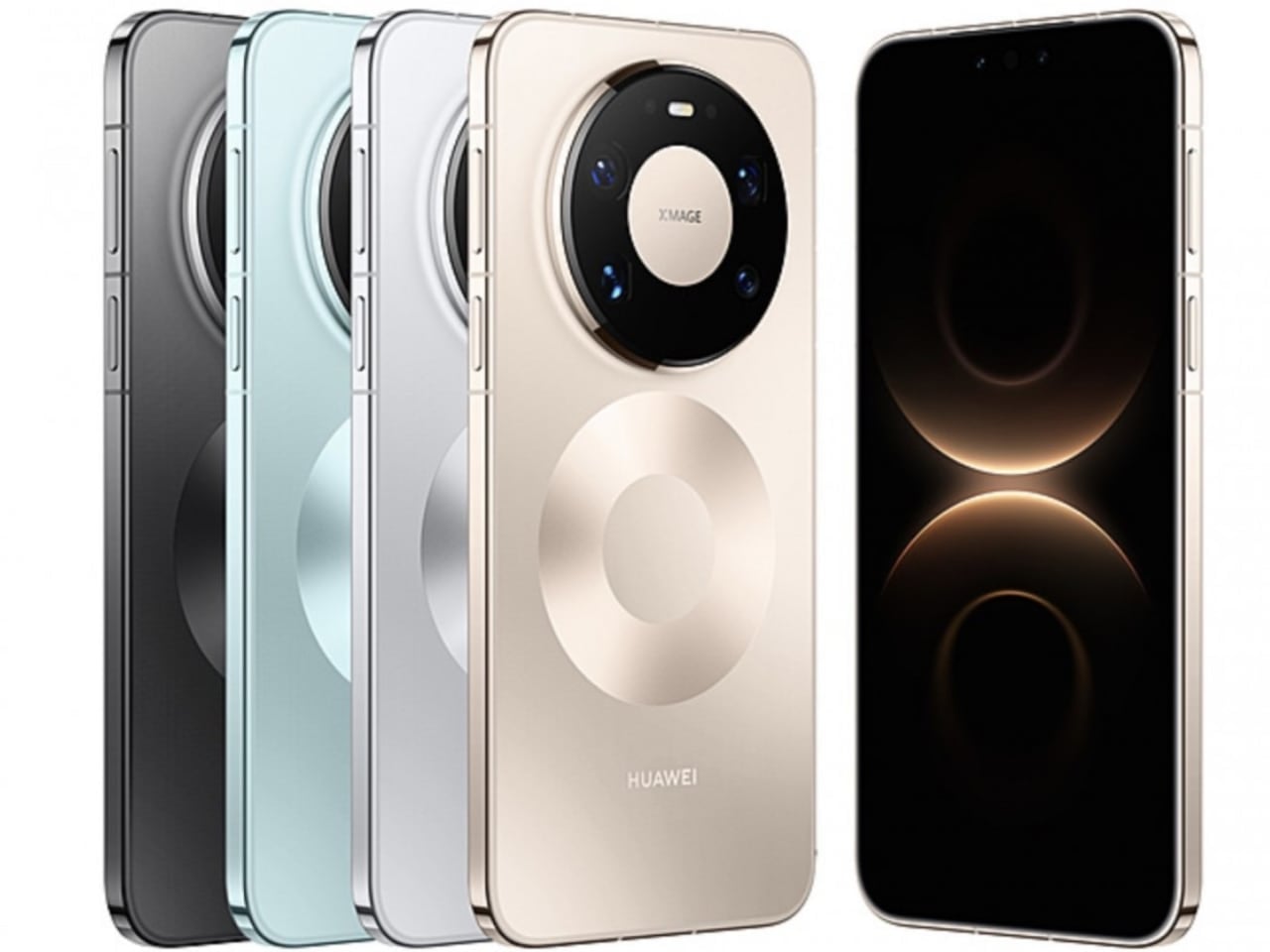
Most users will never consciously notice this detail. Their eyes will thank them anyway.
The “8” That Defines Everything
Huawei’s design team turned the model number into a visual identity, and the boldness of that choice deserves recognition in an industry addicted to safe rectangles and generic camera bumps.
The rear panel features a prominent circle highlighting the wireless charging coils, positioned directly above the circular camera module. Together, these two circles stack vertically to form a figure eight that reads as both functional diagram and brand statement. The phone announces itself at twenty feet. Most manufacturers treat rear panel design as an afterthought, a surface to slap logos onto after engineering finishes the real work. Huawei flipped that relationship entirely, making the wireless charging coils a design feature rather than hiding them under featureless glass.
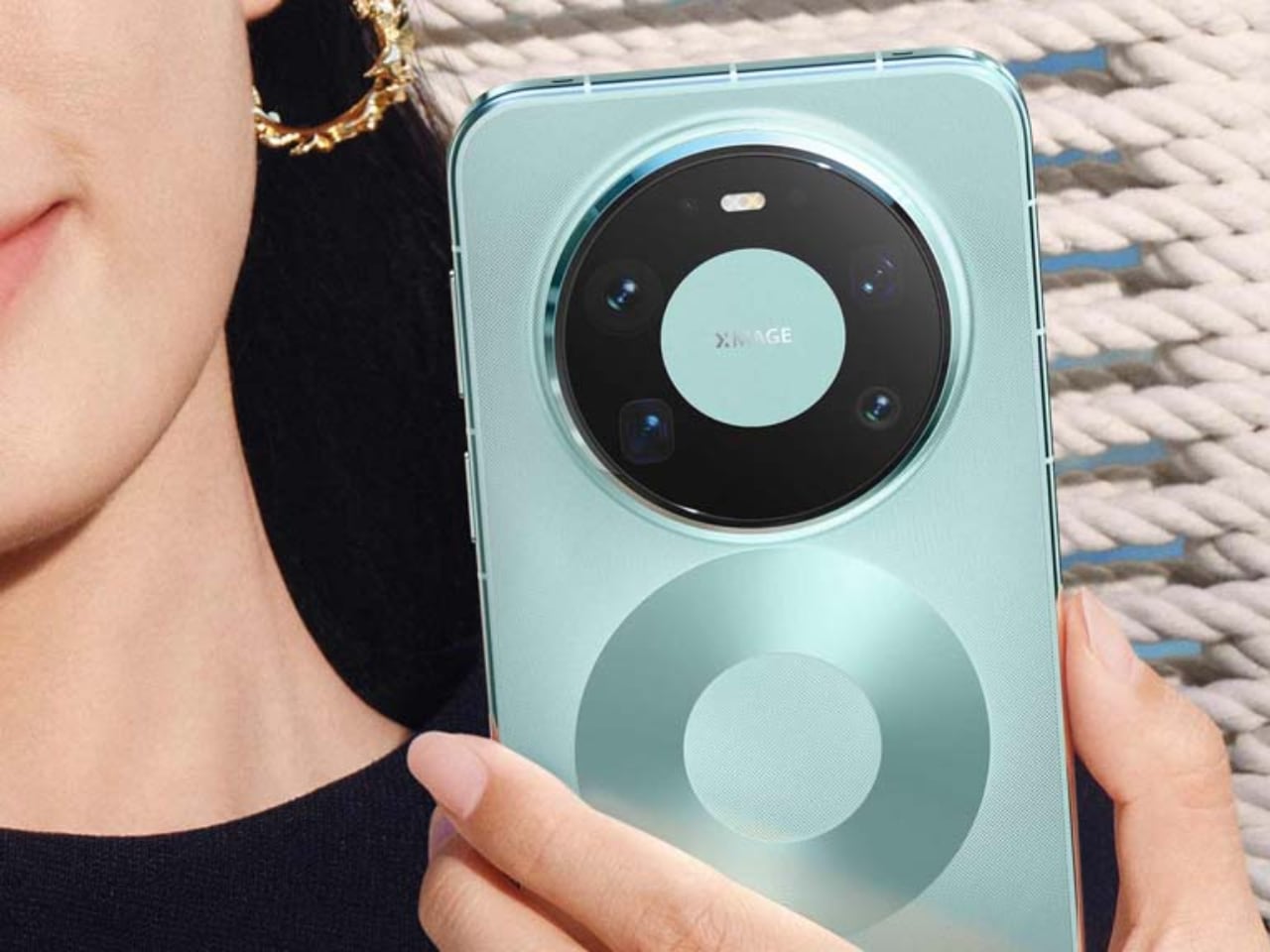
The flat display edges and squared-off sides follow a broader industry shift away from curved screens. Curves looked elegant but created durability problems and made edge interactions imprecise, and Huawei clearly listened to actual user complaints rather than chasing visual trends. The Mate 80 Pro Max prioritizes function over flowing aesthetics, which reads as mature design confidence rather than trend abandonment.
Materials as Message
Kunlun Glass 2 protects the display. Basalt-infused elements reinforce the frame. Polyamide fiber adds structural rigidity. These materials come from aerospace and automotive applications where failure means more than a cracked screen, and Huawei wants you to know it.
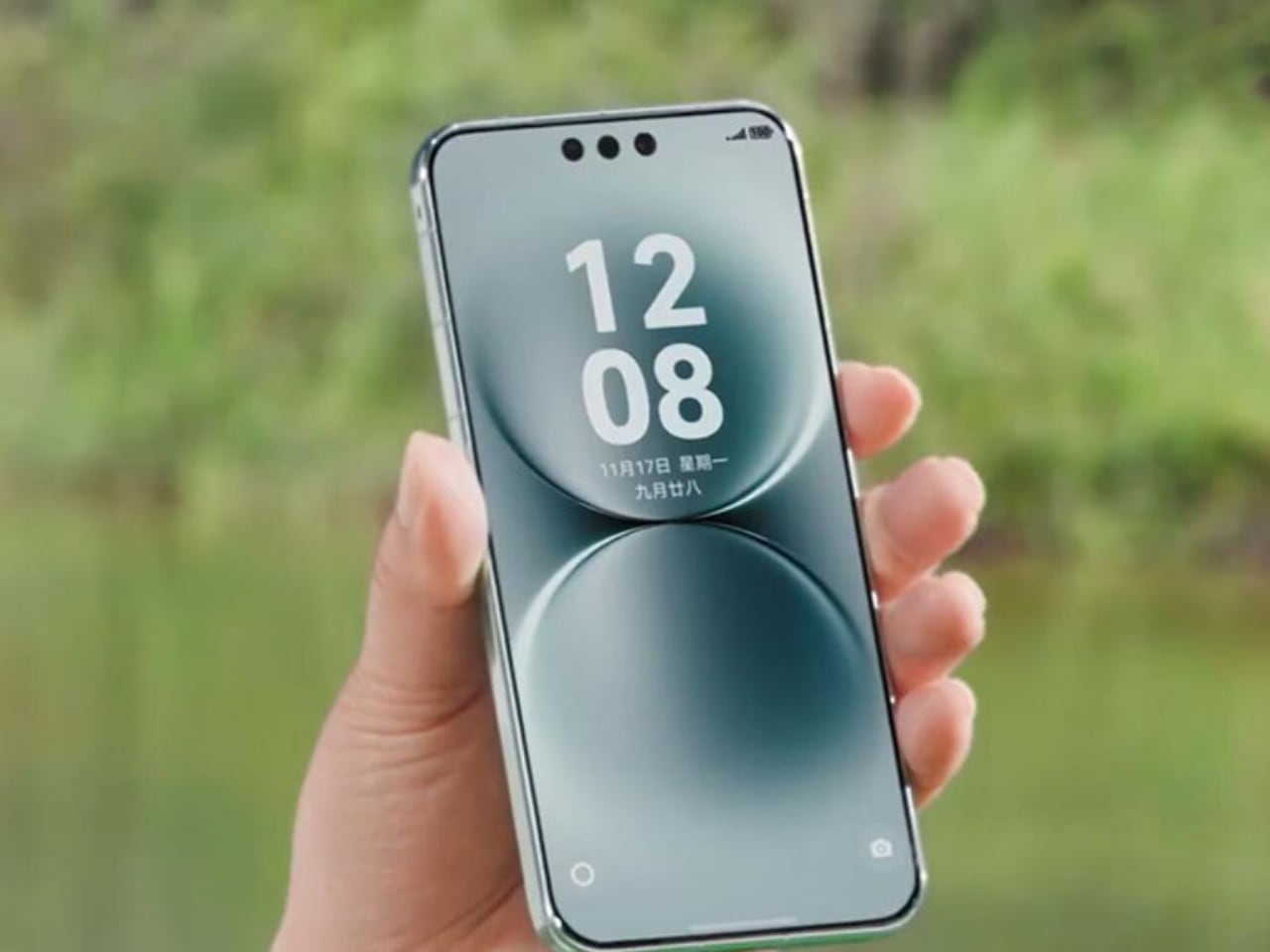
The material palette communicates something specific: this phone is built to survive. Whether the exotic composition actually outperforms conventional aluminum and Gorilla Glass remains unproven through real-world abuse testing, but the conceptual intent lands clearly. Huawei wants buyers to feel they’re holding something more substantial than another fragile glass sandwich that shatters on the first drop.
Competitor Philosophies Compared
Apple’s iPhone 17 Pro Max peaks at 3,000 nits outdoors, emphasizing color accuracy, response time, and ProMotion integration instead. Samsung’s Galaxy S25 Ultra settles at 2,600 nits peak, focusing on S Pen ecosystem integration where stylus latency matters more than brightness records.
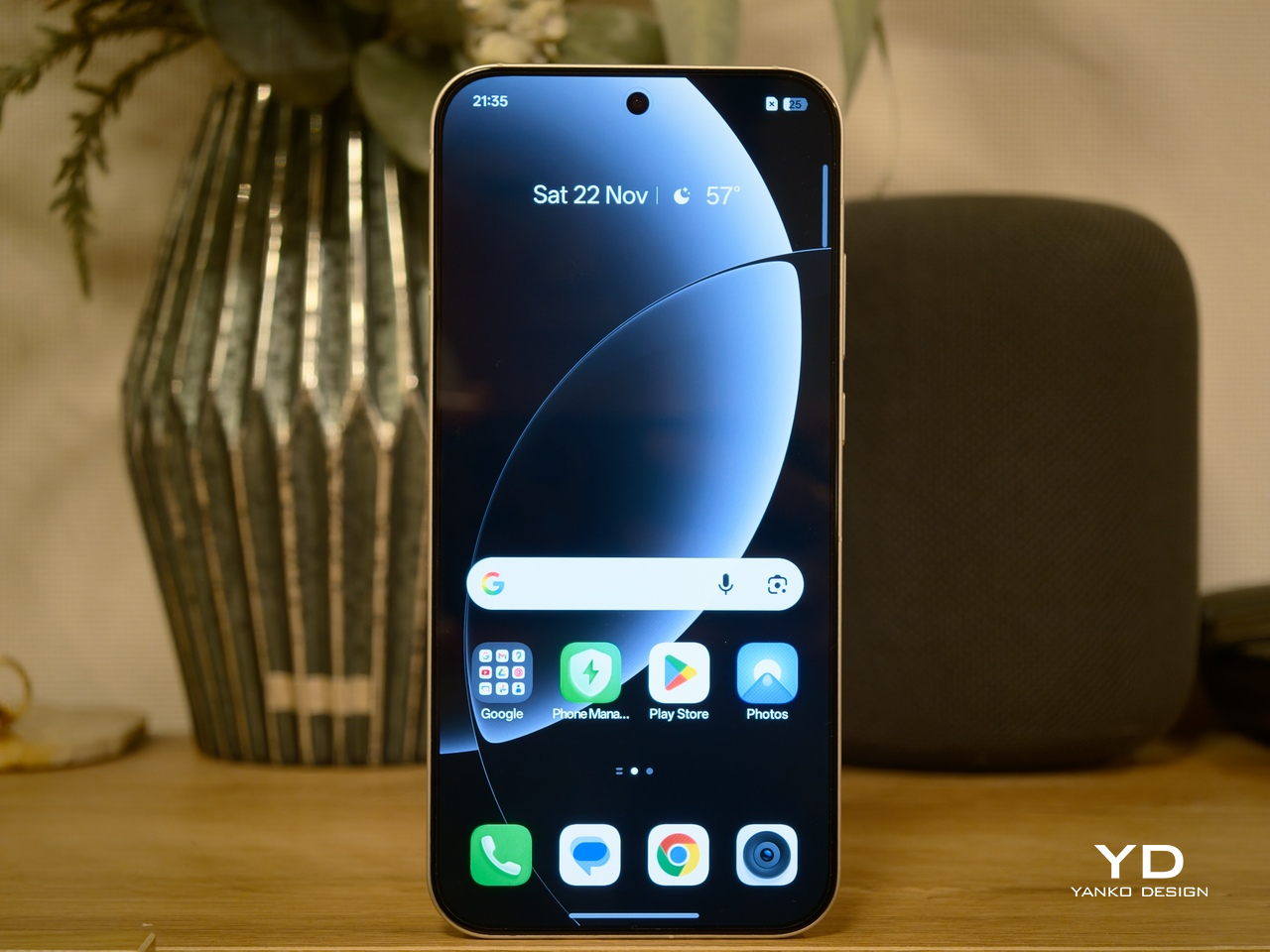
Realme’s GT 8 Pro pushed to 7,000 nits before Huawei arrived, representing the aggressive spec-chasing that defines much of the Chinese smartphone market where headline numbers drive purchasing decisions more directly than in Western markets. Different priorities produce different design choices, and Huawei one-upped everyone on brightness while wrapping the achievement in more considered industrial design than the pure spec-chasers typically deliver.
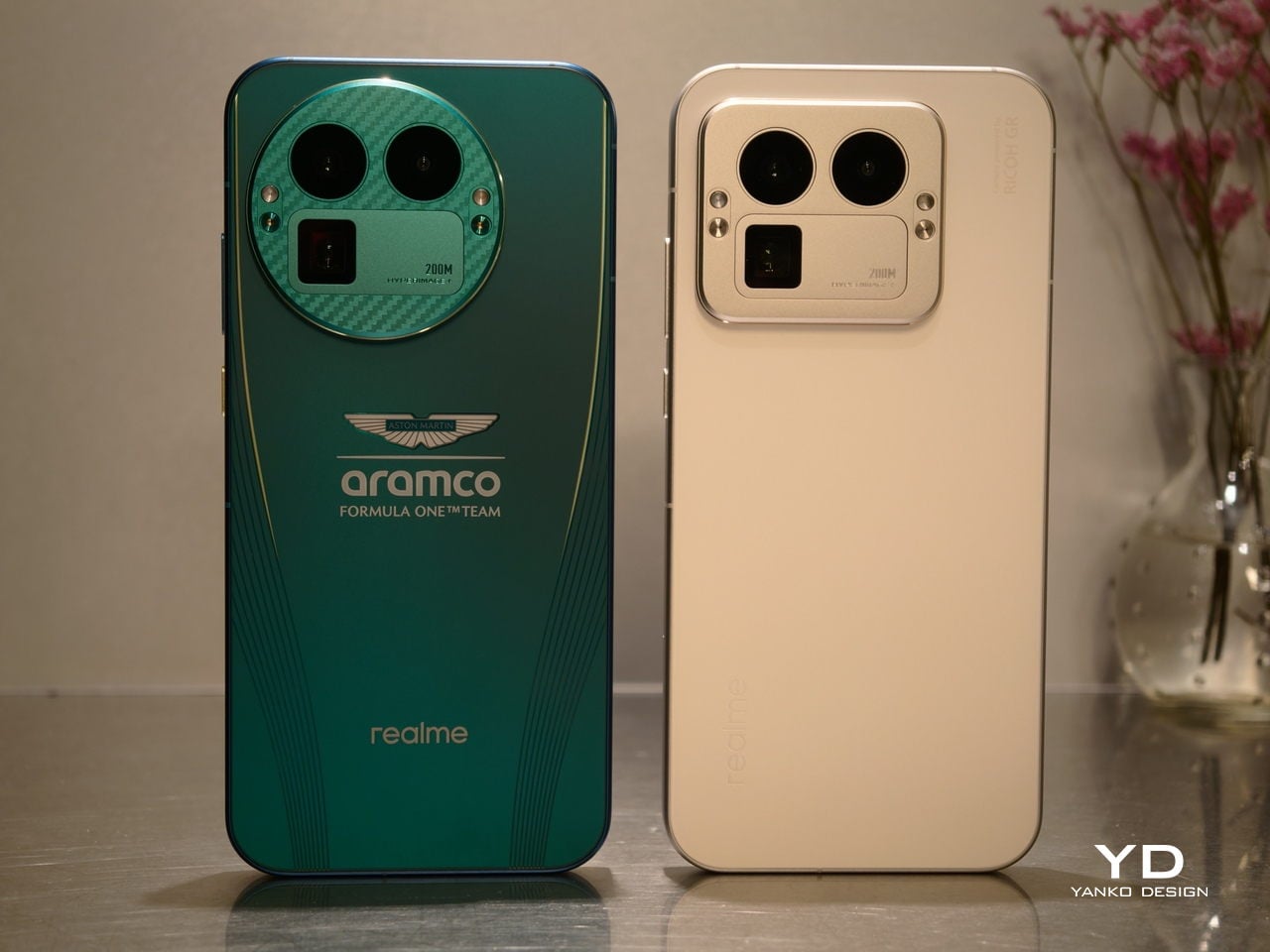
Trade-Offs Hidden in Marketing: 8,000 nits requires power.
More power means bigger batteries, shorter runtime, or aggressive throttling when capacity drops. Huawei’s 6,000mAh battery seems modest against Chinese competitors pushing past 7,000mAh, which suggests either extreme confidence in dual-layer efficiency or accepted runtime compromises that won’t appear until real-world testing begins.
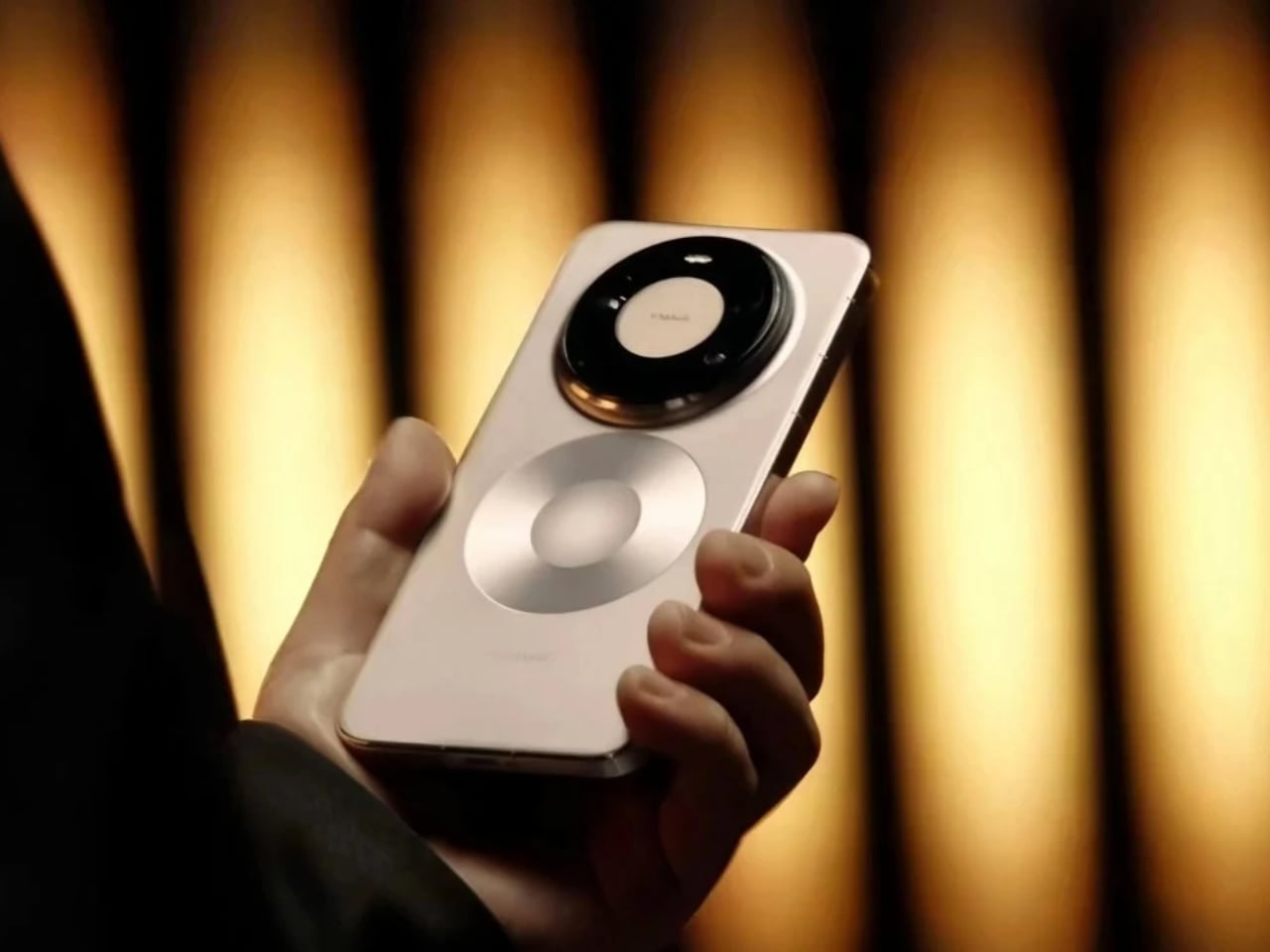
Thermal management creates even thornier long-term concerns that no launch event mentions. Excessive heat degrades organic compounds in OLED panels over time, potentially causing permanent brightness loss and color shift in heavily-used screen areas. The dual-layer architecture should help by spreading thermal load across more surface area, but durability implications won’t become clear for years of actual use. And then there’s the practical question: who actually needs 8,000 nits? Screens above 2,000 nits handle direct sunlight adequately for most tasks, and the extreme peak brightness matters primarily for tiny HDR highlights representing blinding light sources like the sun or reflections.
Real value or marketing trophy? Probably both, depending entirely on how you use the device.
What the Brightness Obsession Reveals
The Mate 80 Pro Max embodies a specific philosophy: the display IS the device, and everything else exists to support the viewing experience. The logic tracks, since smartphones evolved into portable screens that occasionally make calls, and optimizing the primary interaction surface makes intuitive sense. But brightness as the defining metric risks missing what actually makes displays pleasant to use: color accuracy, viewing angle consistency, touch response precision, eye comfort across hours of use. A 2,000-nit panel with superior color science might deliver better daily experience than an 8,000-nit screen with mediocre calibration. Huawei historically nails calibration alongside technical specs, so there’s reason for optimism, but the proof requires hands-on time that marketing materials cannot provide.
For Design-Conscious Buyers
The Mate 80 Pro Max succeeds as a design object beyond its brightness claims. The “8” motif creates genuine visual identity. The material choices communicate premium durability. The dual-layer OLED architecture represents meaningful innovation rather than incremental improvement. HarmonyOS remains the elephant in the room for international users, with no Google Play Services meaning no Gmail, no Maps, no YouTube without workarounds, and limited global availability makes the device theoretical for many potential buyers regardless of how compelling the hardware appears.
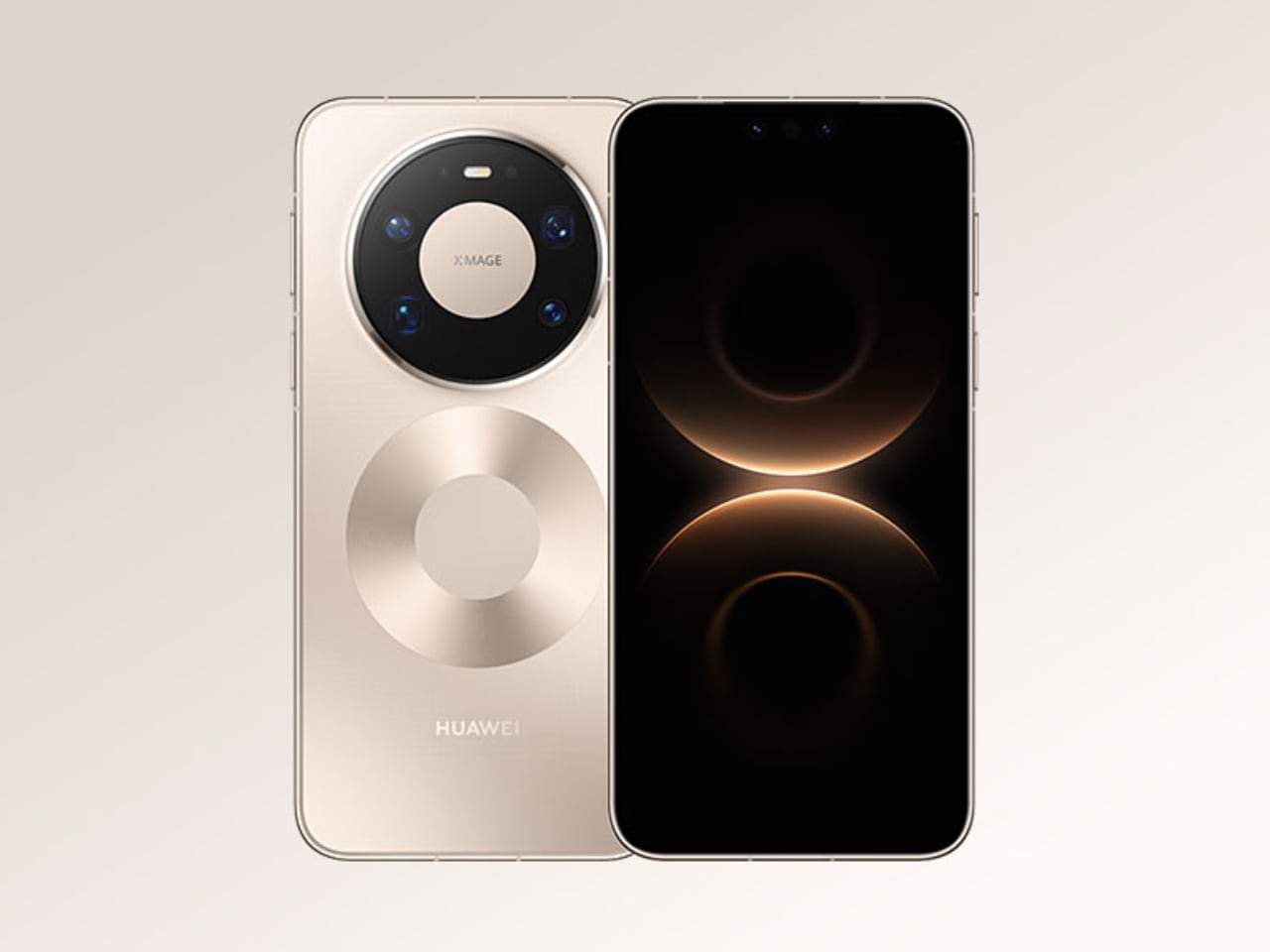
For those who can access and actually use the Mate 80 Pro Max within its intended market, the display technology offers real advantages for outdoor use, HDR content, and photography demanding accurate highlight reproduction. The design language makes a statement that Apple and Samsung’s safer approaches simply don’t attempt. The brightness arms race continues, and competitors will push toward and beyond Huawei’s record within months.
What matters more than any single number is whether manufacturers use these capabilities to create genuinely better experiences, or simply chase specifications for their own sake. The Mate 80 Pro Max suggests Huawei understands the distinction, even if the marketing still leads with the biggest number.
Display Technology Comparison
| Specification | Huawei Mate 80 Pro Max | iPhone 17 Pro Max | Samsung Galaxy S25 Ultra | Realme GT 8 Pro |
|---|---|---|---|---|
| Peak Brightness | 8,000 nits | 3,000 nits | 2,600 nits | 7,000 nits |
| Display Technology | Dual-layer OLED | Single-layer OLED | Single-layer OLED | Single-layer AMOLED |
| PWM Dimming | 1440Hz | 480Hz | Variable | 2160Hz |
| Refresh Rate | 1-120Hz LTPO | 1-120Hz ProMotion | 1-120Hz LTPO | 1-120Hz LTPO |
| Resolution | 1320 x 2848 | 1320 x 2868 | 1440 x 3120 | 1264 x 2780 |
| Glass Protection | Kunlun Glass 2 | Ceramic Shield | Gorilla Armor 2 | Gorilla Glass Victus 2 |
| Design Philosophy | Brightness as identity | Color accuracy first | Stylus integration | Spec leadership |
The post Huawei’s 8,000-Nit Display Is a Design Statement Disguised as a Spec Sheet first appeared on Yanko Design.
Huawei Mate 80 Series: Design Language Evolution and the 20GB RAM Flagship
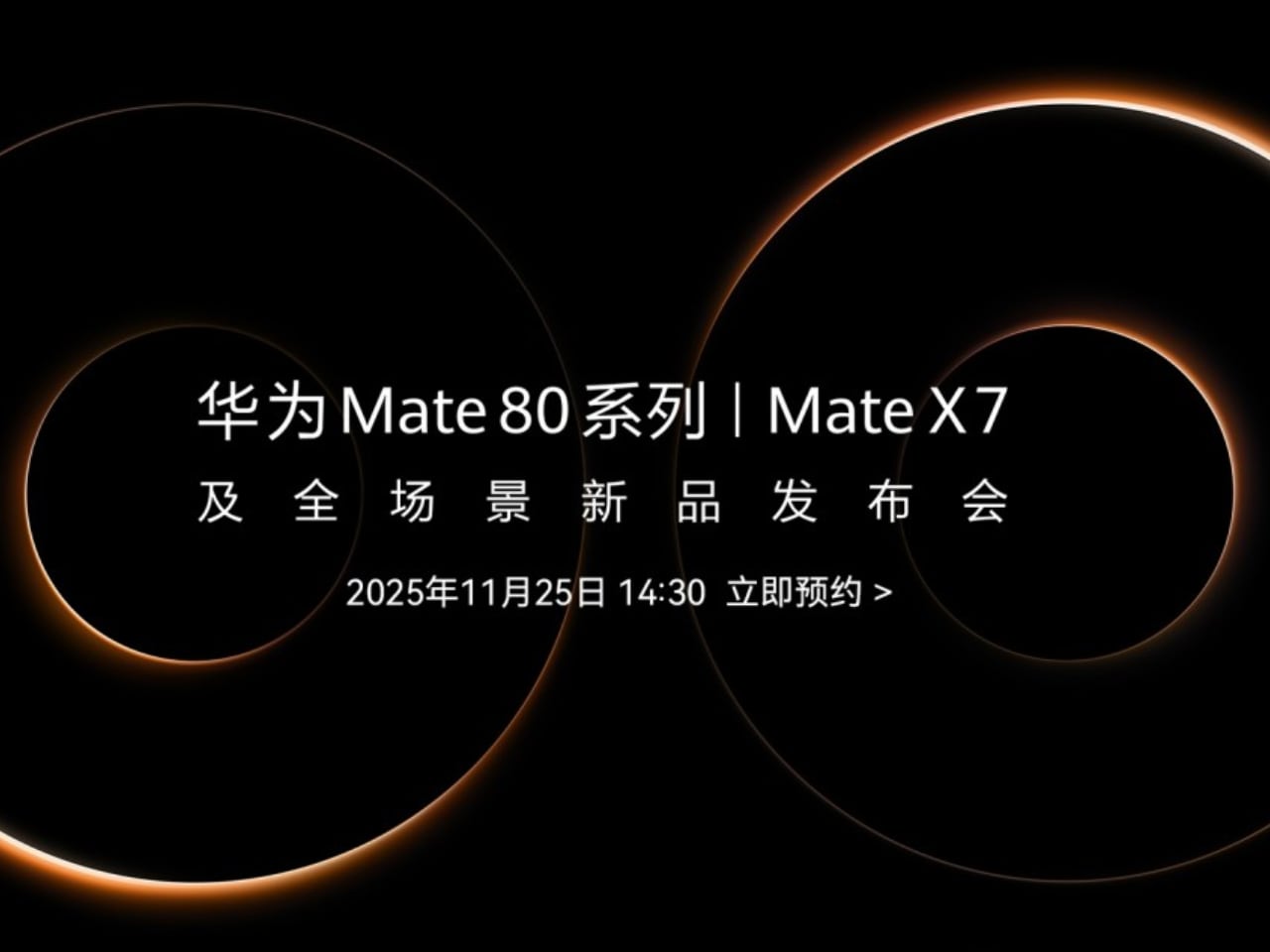
Huawei just confirmed November 25 as the official launch date for its Mate 80 series, and the company isn’t holding back. Four distinct models, each with its own camera architecture and design identity. The standout? A flagship variant packing 20GB of RAM and an octagon-shaped camera module that breaks from the circular designs dominating the smartphone industry.
Designer: Huawei
This is Huawei’s play for design differentiation in a market where most flagship phones look nearly identical from the back. The Mate 80 lineup spans from the accessible base model through to the RS Ultimate Design, a halo product that signals where Huawei sees premium smartphone design heading.
Four Models, Four Design Approaches
The Mate 80 and Mate 80 Pro share a circular rear camera module housing three sensors, including a periscope telephoto lens. Both phones feature dual front cameras with 3D face unlock technology. It’s a refined, approachable design that builds on Huawei’s established camera bump aesthetic.
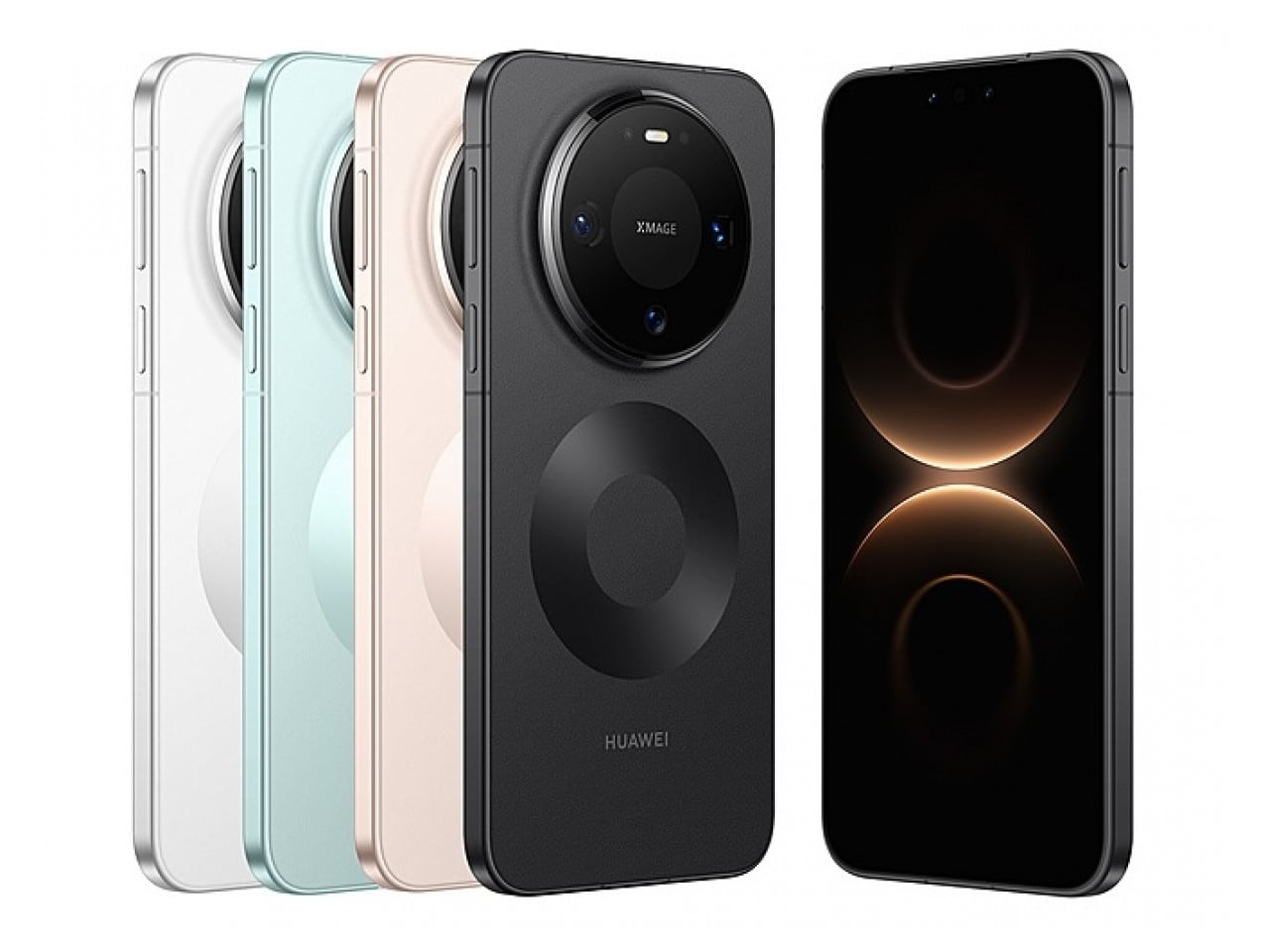
The Mate 80 Pro Max steps up with a quad-camera system that includes dual periscope telephoto lenses. That’s two dedicated telephoto sensors for optical zoom flexibility, a configuration that gives photographers multiple focal length options without digital cropping. Dual front cameras maintain consistency across the upper-tier models.
Then there’s the Mate 80 RS Ultimate Design. The octagon-shaped camera module is the immediate visual differentiator, a geometric departure that catches attention without feeling gimmicky. It houses four rear sensors and pairs with dual front cameras, but the design statement is what matters here. Huawei is using the RS Ultimate to establish a distinct visual identity for its most premium offering.
Color Palettes Reflect Market Positioning
Huawei assigned different color families to each tier, reinforcing the hierarchy through material and finish choices.
The Mate 80 and Mate 80 Pro come in Dawn Gold, Obsidian Black, Snowy White, and Spruce Green. These are accessible, versatile colorways that work across different user preferences without pushing too far into statement territory.
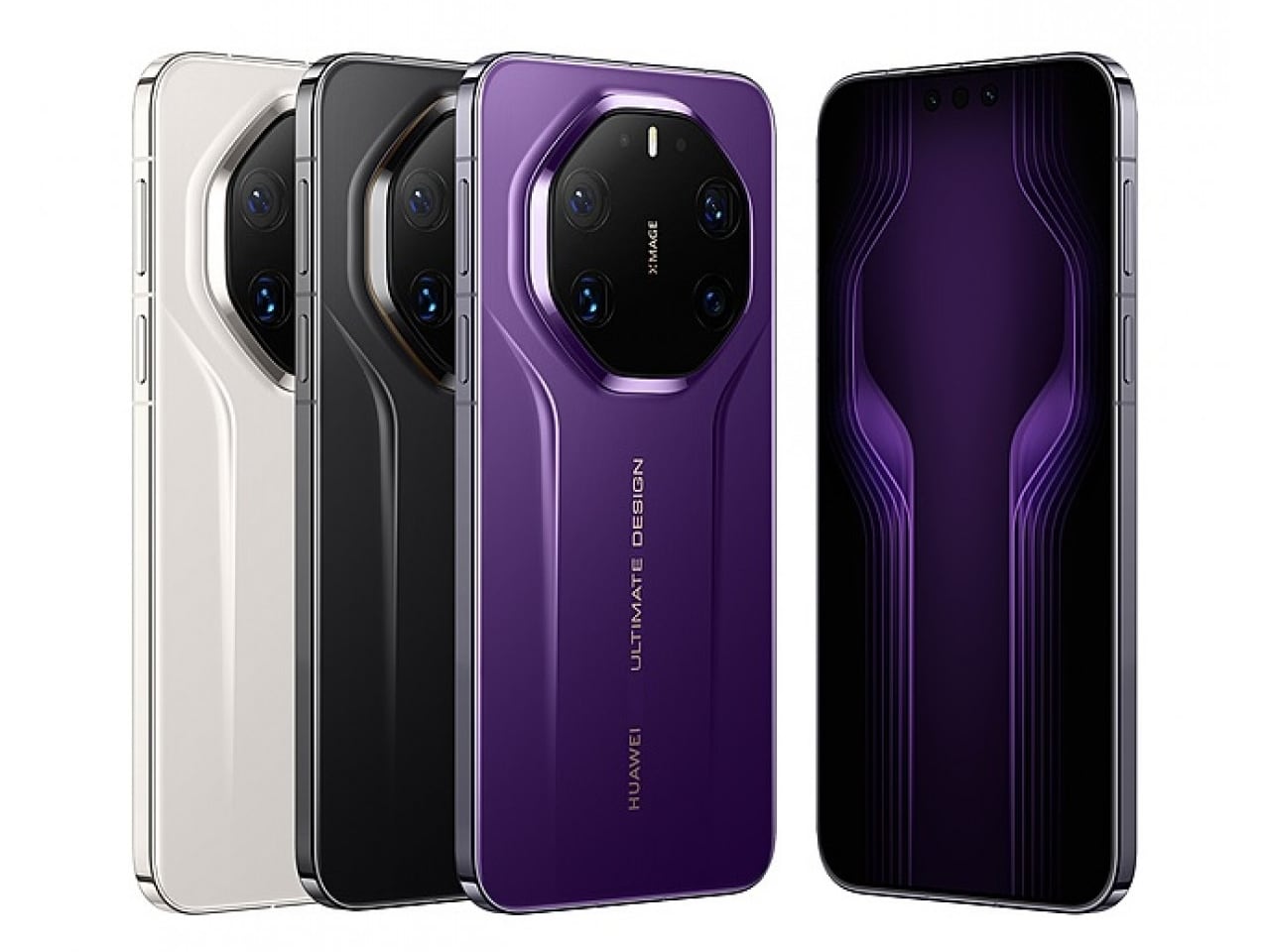
The Mate 80 Pro Max gets Polar Night Black, Polar Silver, Polar Day Gold, and Aurora Blue. The naming convention evokes extreme environments and natural phenomena, positioning this model as the performance flagship with colors that suggest technical capability.
The RS Ultimate Design narrows to three options: Dark Black, Pure White, and Hibiscus. That last color, Hibiscus, has generated notable attention in early discussions. It’s a bold, design-forward choice that signals this phone is as much about aesthetic expression as technical specifications.
RAM Leadership: 20GB in the RS Ultimate Design
The Mate 80 RS Ultimate Design ships with 20GB of RAM paired with either 512GB or 1TB of storage. That’s the highest RAM configuration in the entire lineup, positioning this model for users running multiple resource-intensive applications simultaneously or future-proofing for increasingly demanding mobile workflows.
The base Mate 80 and Mate 80 Pro offer 12GB/256GB, 12GB/512GB, and 16GB/512GB configurations, with the Pro adding a 16GB/1TB option. The Mate 80 Pro Max comes in 16GB/512GB and 16GB/1TB variants. Huawei structured the RAM progression to create clear performance tiers across the lineup.
Launch Strategy: Pre-Orders and Dual Flagship Debut
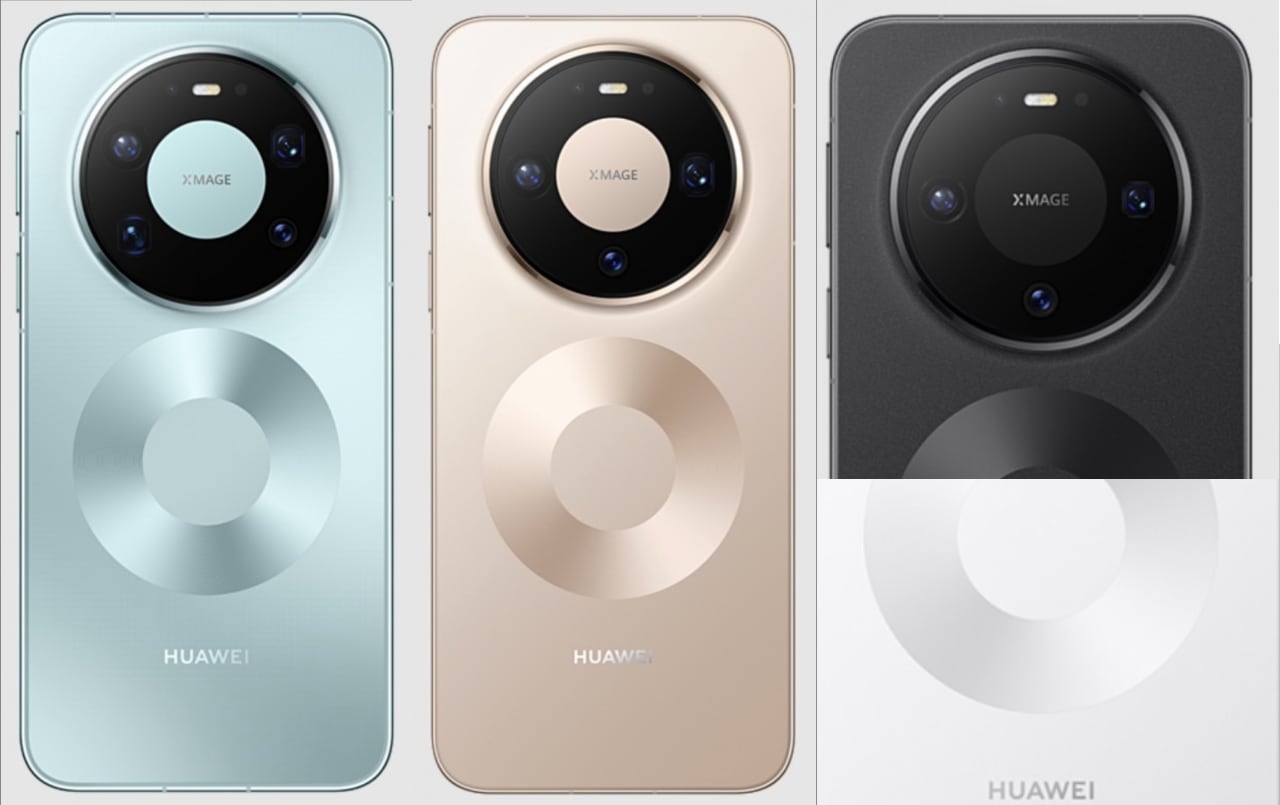
Huawei opened pre-orders through its Vmall online store ahead of the November 25 launch event. The company is simultaneously unveiling the Mate X7 foldable, positioning the launch as a comprehensive showcase of its flagship smartphone strategy rather than focusing solely on the traditional slab phone format.
The dual launch suggests Huawei sees both form factors as equally important to its premium positioning. The Mate 80 series represents refinement and camera innovation within the established smartphone template, while the Mate X7 addresses users prioritizing screen real estate and multitasking flexibility.
What This Means for the Flagship Race
The Mate 80 lineup shows Huawei using design variation to create meaningful differentiation within a single product family. Most manufacturers rely primarily on camera count and technical specifications to separate models. Huawei added visual language shifts, particularly with the RS Ultimate’s octagon module, to make the hierarchy immediately apparent.
The dual periscope telephoto system in the Pro Max addresses a real pain point for mobile photographers: the gap between primary wide and telephoto focal lengths. Two periscope lenses allow for more granular zoom options and better image quality across the telephoto range.
Whether these design choices translate into market success remains to be seen when the phones launch November 25. But Huawei is clearly betting that distinctive design, aggressive RAM configurations, and advanced camera architectures can carve out space in the competitive flagship smartphone market.
The post Huawei Mate 80 Series: Design Language Evolution and the 20GB RAM Flagship first appeared on Yanko Design.
HUAWEI WATCH GT 6 Series Unveils Exclusive Art-Inspired Watch Faces at Venice Biennale
Huawei Watch GT5 Pro Hands-On Review – Where Luxury Meets Functionality
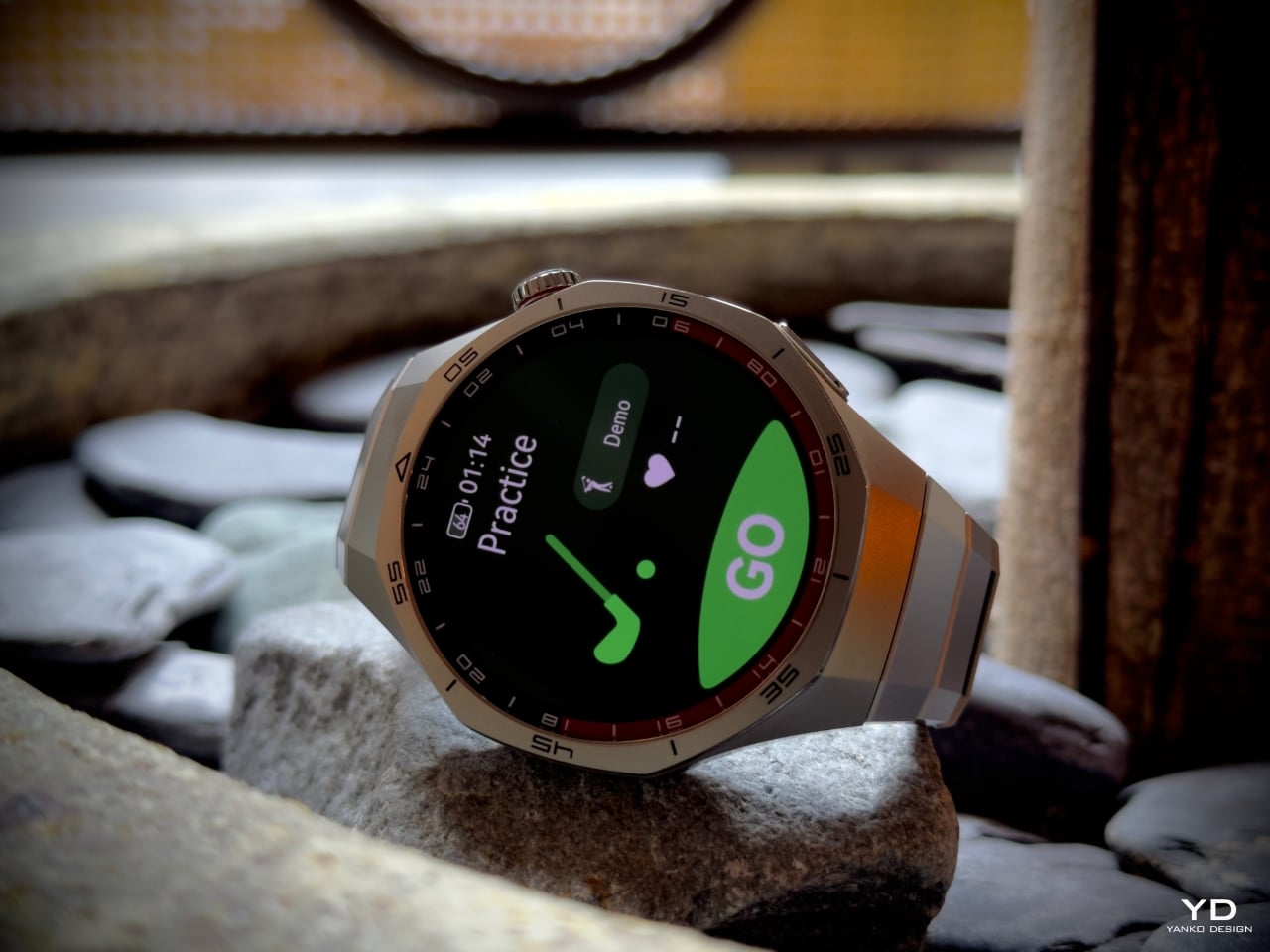
PROS:
- Huawei TruSense System: Advanced health tracking, including blood pressure monitoring and ECG
- Long battery life of up to 14 days
- Premium materials like titanium and ceramic for durability
- Compatible with Android and iOS devices
CONS:
- Higher price tag, especially for premium models
- Limited third-party app support compared to competitors
Huawei continues to redefine what we expect from smartwatches with the Watch GT5 Pro. Building on the successes of the GT4 and GT3 Pro, this latest iteration seamlessly blends premium materials with advanced health tracking features. Whether you choose the titanium or ceramic model, the GT5 Pro caters to users who value fitness and aesthetics without compromise.
Designer: Huawei
First Impressions: High-End Design with Purpose
From the moment I strapped the Huawei Watch GT5 Pro onto my wrist, it was clear this wasn’t your average smartwatch. The sleek design focused squarely on the timepiece, exudes luxury and sophistication. I had the pleasure of testing the 46mm titanium model and the 42mm ceramic version—each leaving a distinct and lasting impression.
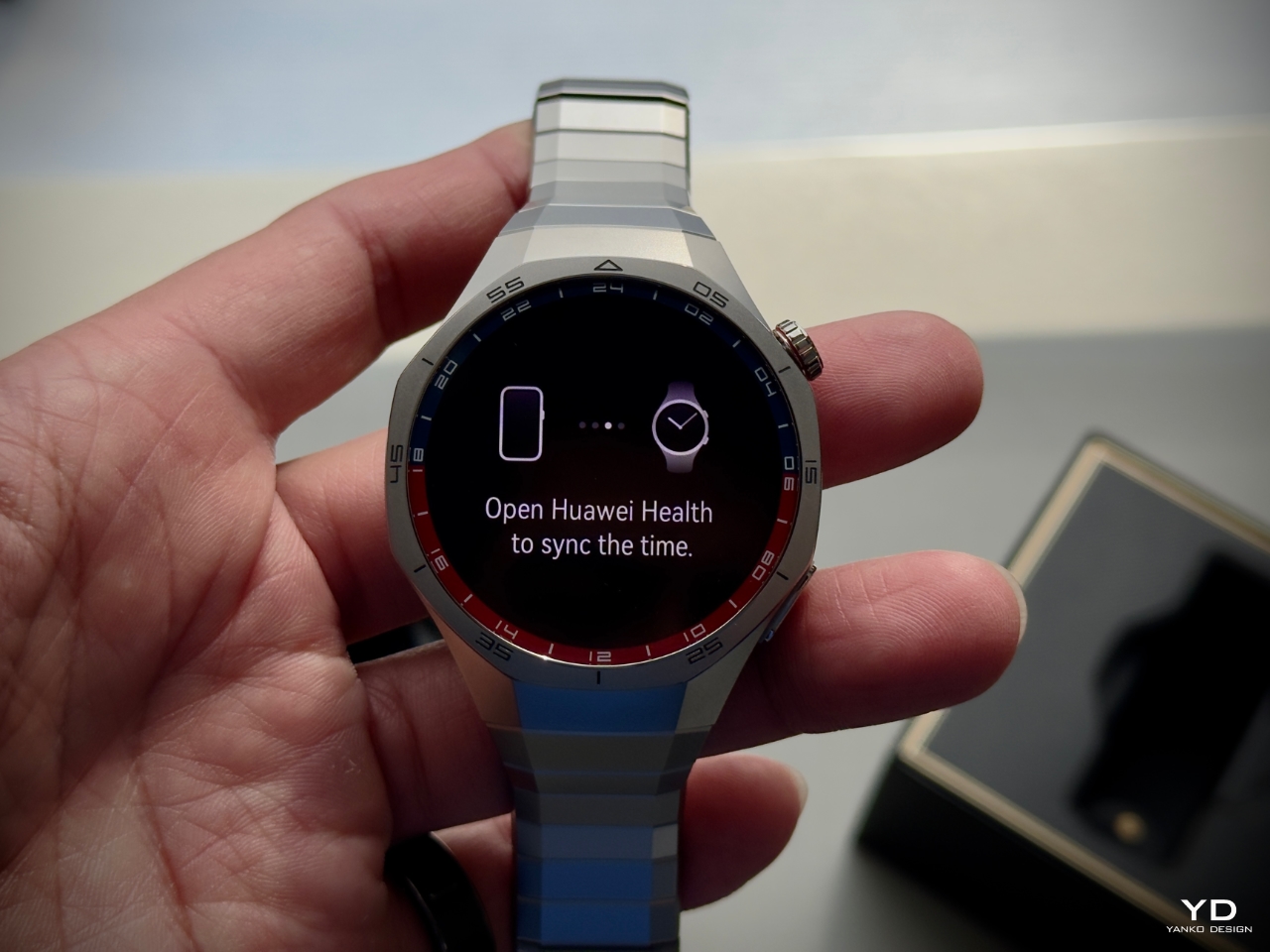
Huawei Watch GT5 Pro Titanium Alloy
The titanium alloy version feels robust and is tailored for those who lead active lifestyles. At the same time, the ceramic model is lighter and more polished, designed to complement any outfit—be it formal or casual. Both models showcase Huawei’s meticulous attention to detail, from the intricately designed watch faces to the seamless integration of premium materials.
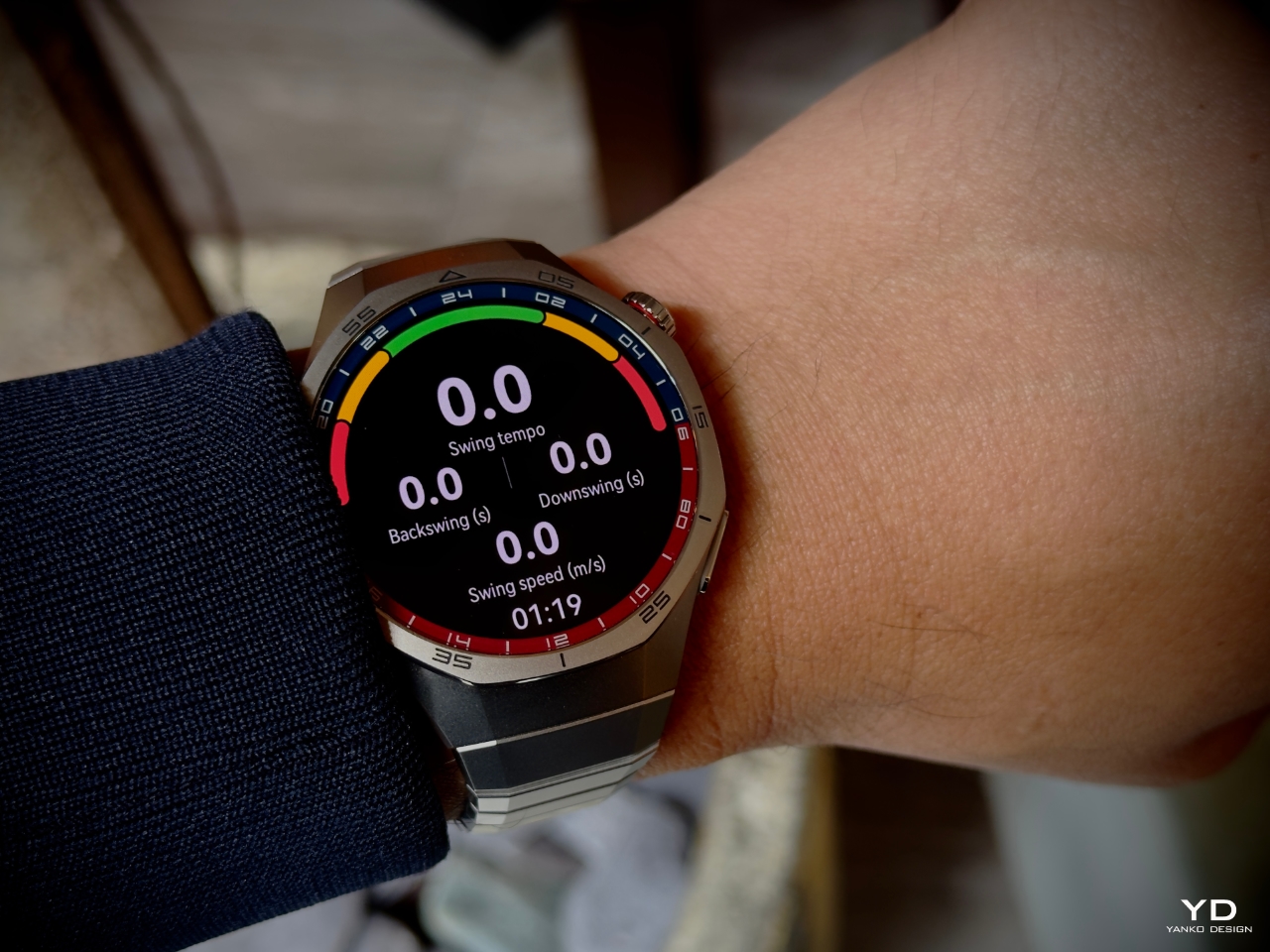
Design and Build Quality: Refined Craftsmanship with Bold Details
Huawei’s design philosophy shines through in the GT5 Pro, combining cutting-edge technology with exquisite craftsmanship. The titanium alloy and ceramic models feature sapphire glass, offering excellent scratch resistance while enhancing clarity and durability.
Titanium Model: Rugged Yet Sophisticated
The 46mm titanium version strikes a perfect balance between ruggedness and elegance. Ideal for those who want a watch that can handle outdoor adventures and formal settings, the titanium case is crafted from aerospace-grade material, providing exceptional strength without excessive weight. Its brushed finish adds a touch of class, while the titanium link bracelet feels smooth against the skin and is easily adjustable for a perfect fit.
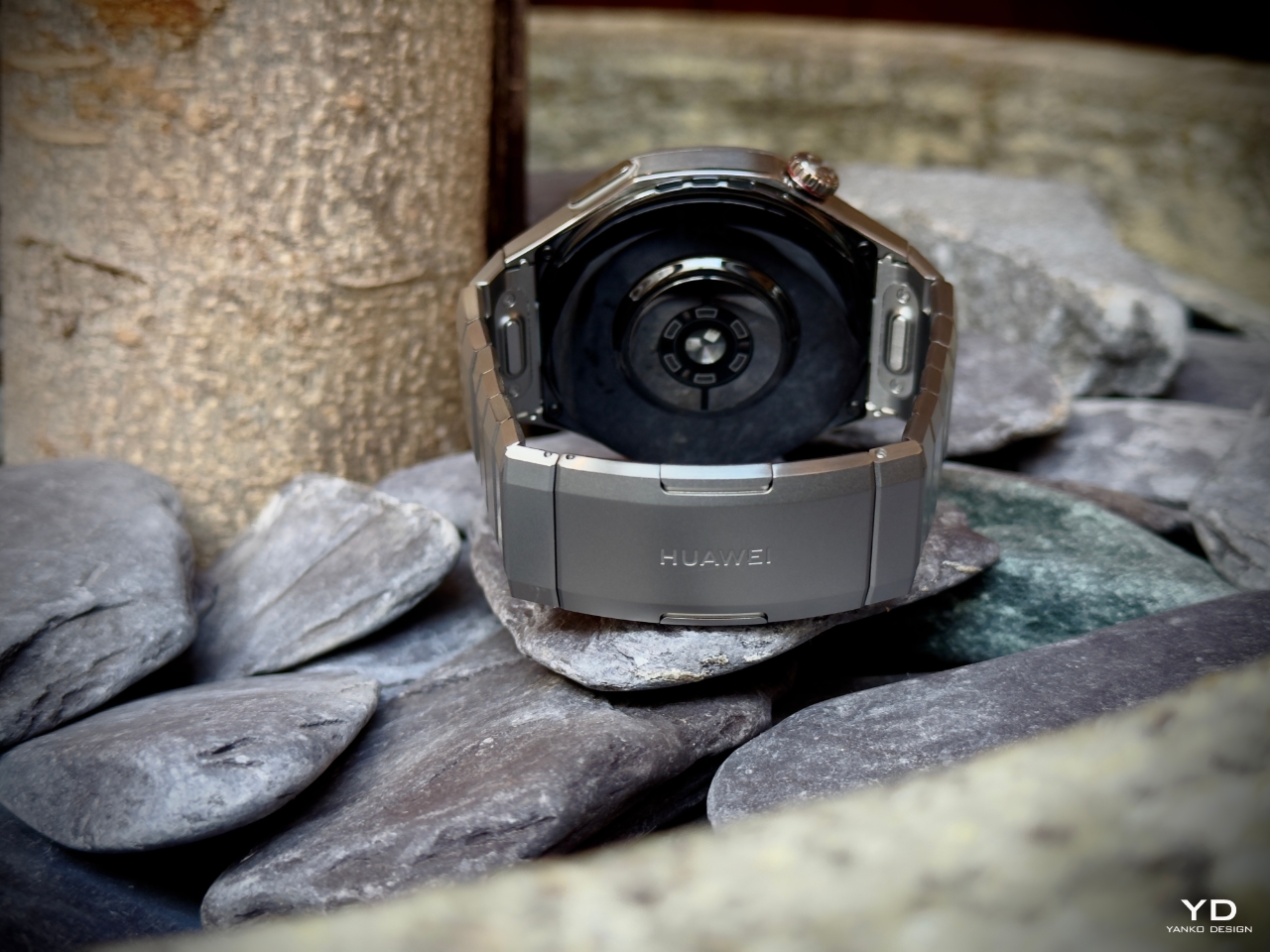
Despite its larger size, the titanium model feels light enough. Thoughtful weight distribution ensures comfort during all-day wear. The bold, masculine design transitions seamlessly from professional meetings to outdoor pursuits, offering style and durability.
Ceramic Model: Subtle Sophistication
The 42mm ceramic model is all about refinement. Building on the design language of the GT3 Pro Ceramic Edition, Huawei has perfected its nanocrystal ceramic manufacturing process. This meticulous seven-day process results in a flawless, mirror-like, durable, and eye-catching finish.

The ceramic model feels noticeably lighter than its titanium counterpart. The ceramic bezel and sapphire glass blend seamlessly, creating an uninterrupted surface that enhances the watch’s minimalist aesthetic. The white ceramic strap enhances the watch’s elegance and provides all-day comfort, making it ideal for any occasion.
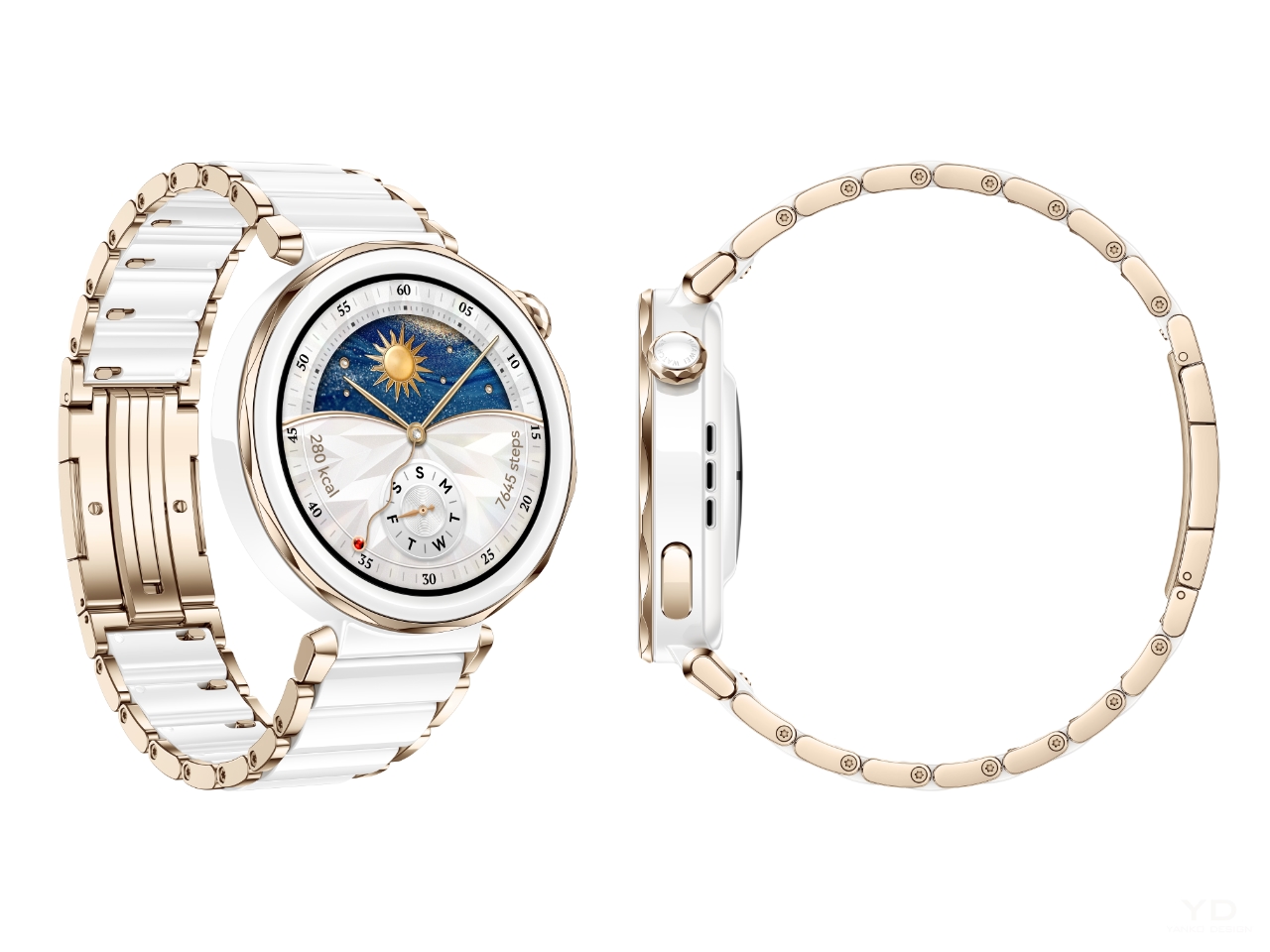
Dynamic Visual Experience: Light and Shadow Effects
One of the GT5 Pro’s most striking design features is its use of geometric shapes to create a captivating light and shadow effect. Light dances across its surfaces as the watch moves under different lighting conditions, adding depth and dimension to the design. This effect is particularly pronounced on the titanium version, where the brushed finish accentuates the watch’s premium look.
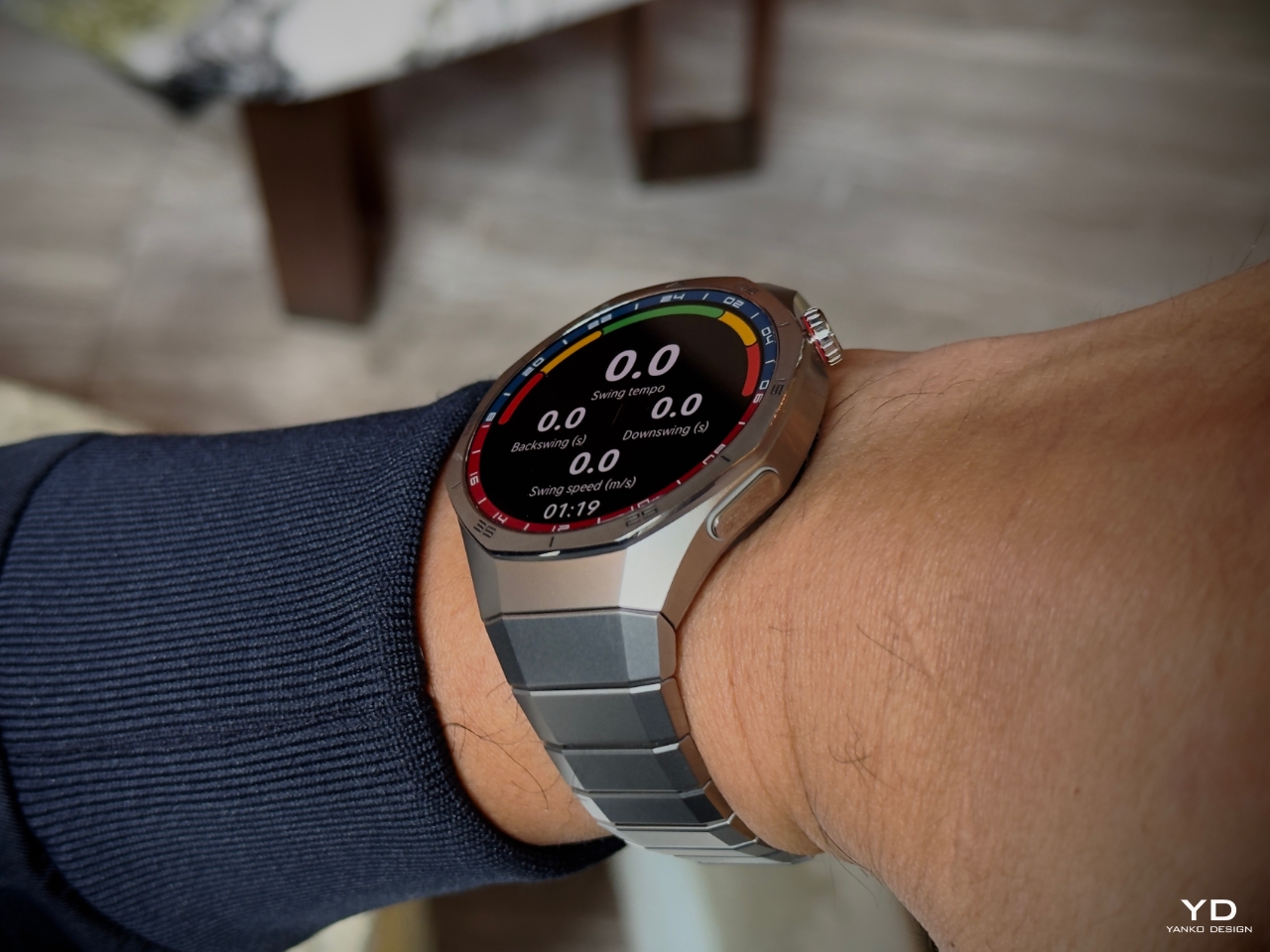
The crown on both models is intricately designed with a knurled texture, providing a tactile and responsive experience when adjusting settings. These details and the nanocrystal ceramic rear case reflect Huawei’s commitment to balancing aesthetic appeal with functional durability.
Comfort and Fit: Ergonomics Perfected
Both the titanium and ceramic models are designed with ergonomics in mind. The curved cases and flexible straps ensure a snug fit without discomfort, even during extended wear. The titanium model offers a reassuring weight that balances comfort and presence, while the ceramic model is lighter and stays cool against the skin.

Strap Variety: Tailored to Your Style
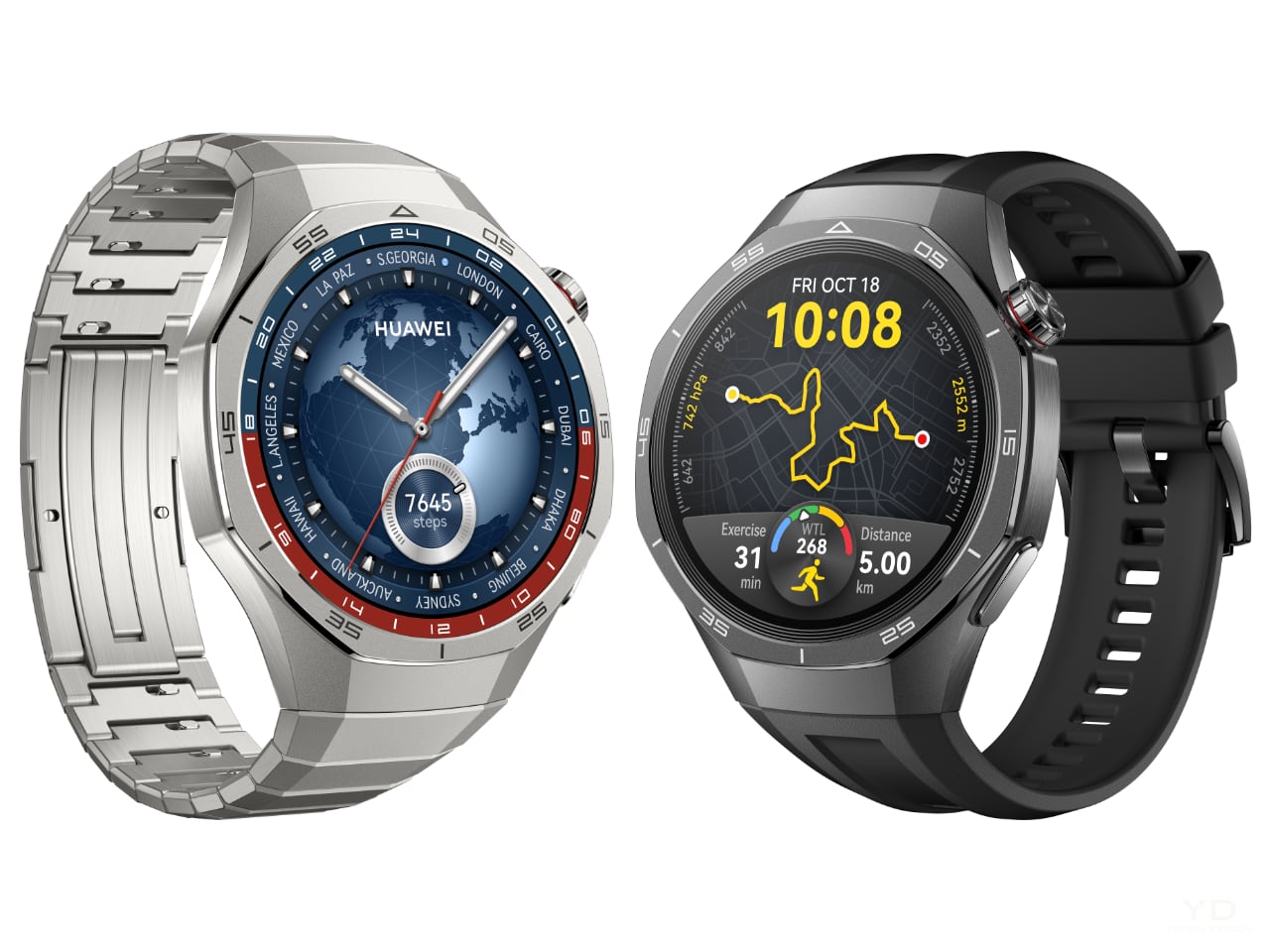
Huawei has introduced a variety of strap options for the GT5 Pro, allowing users to customize the watch to match their style and occasion:
- Fluoroelastomer straps for a sporty, durable feel.
- Ocean-recycled nylon straps highlight sustainability with colors inspired by ocean waves.
- Composite leather straps and Milanese straps for those seeking a more formal and fashionable look.
These options enhance the GT5 Pro’s versatility, enabling it to adapt from a casual day out to a formal evening event effortlessly.
Display and Usability: Crisp, Clear, and Responsive
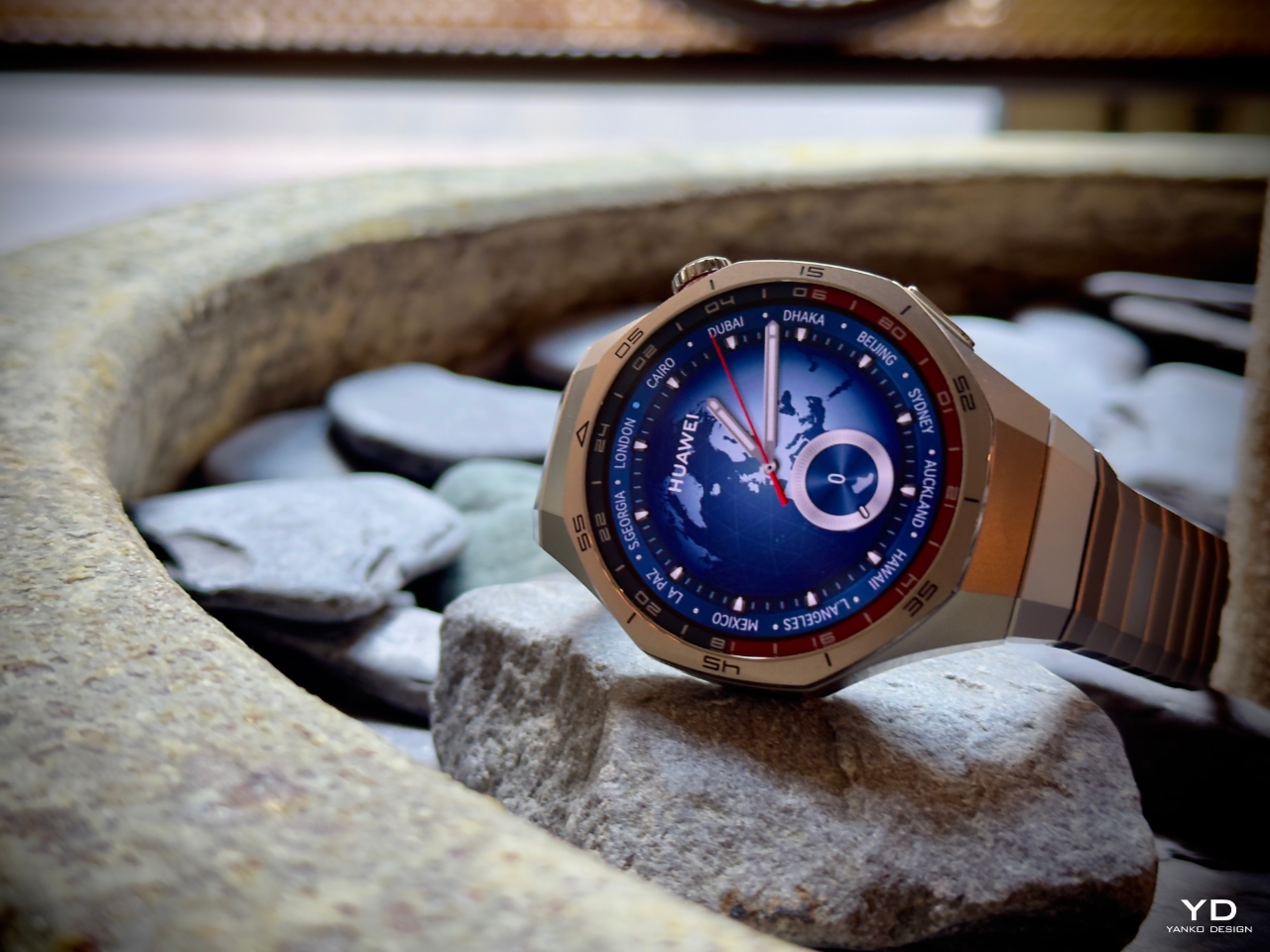
Huawei Watch GT5 Pro
The AMOLED display—measuring 1.43 inches on the titanium model and 1.32 inches on the ceramic—offers a sharp 466 x 466 pixel resolution. Everything from fitness data to notifications appears vibrant and clear, even in direct sunlight. The touchscreen responsiveness is smooth, ensuring seamless navigation through the watch’s features.
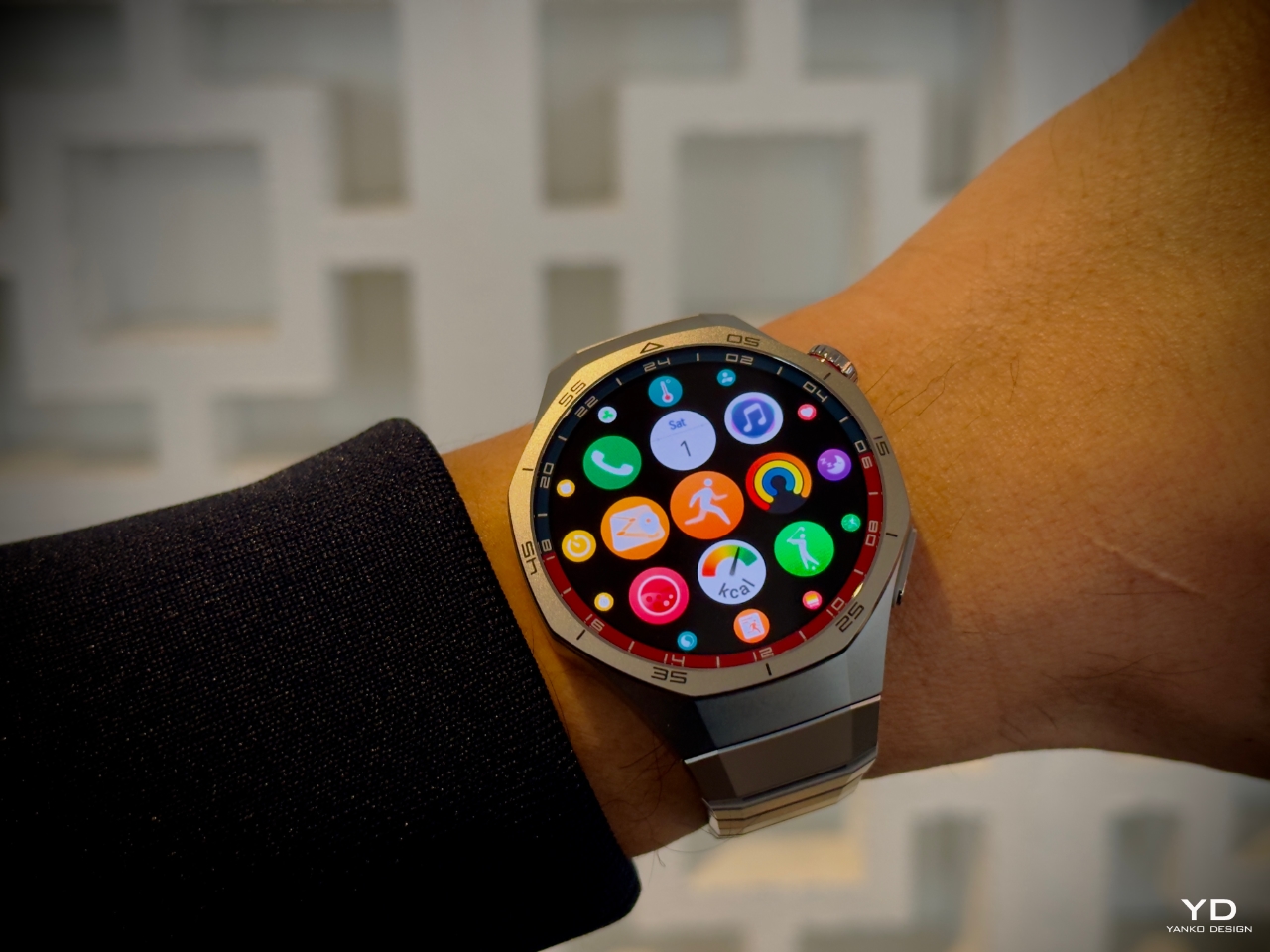
The always-on display is especially useful during workouts or when quick access to time and notifications is needed. It reduces the need to wake the screen manually, making interactions more fluid and saving time.
Huawei TruSense System: Comprehensive Health Monitoring and Insights
Huawei’s TruSense System represents a breakthrough in health and wellness tracking, offering users a sophisticated approach to monitoring physical and emotional wellbeing. Built on a multi-channel optical architecture, the system significantly enhances the accuracy of core health metrics such as heart rate, blood oxygen (SpO2), and respiratory rate. Substantial investments in optical, electrical, and material sciences make this possible, allowing the sensors to overcome traditional challenges related to skin tone variations, wrist sizes, and environmental factors like temperature and humidity.
Leveraging this advanced architecture, the TruSense System monitors over 60 health and fitness indicators, giving users a holistic view of their wellbeing. A standout feature is its sophisticated sleep tracking, which offers detailed insights into light, deep, and REM sleep cycles. This in-depth analysis enables users to understand their sleep quality better and identify improvement areas. These combined features contribute to a comprehensive understanding of personal wellness, positioning TruSense as one of the most advanced systems in wearable health technology today.
By integrating physical and emotional health tracking, Huawei’s TruSense offers an unmatched combination of functionality and precision, helping users stay in tune with their bodies and minds daily.
Advanced Optical Sensing
The TruSense System integrates advanced sensors with state-of-the-art algorithms, delivering consistent and reliable readings. This precision is vital for users who depend on real-time data to fine-tune their performance and recovery. SpO2 monitoring provides swift feedback on oxygen saturation—a crucial cardiovascular and respiratory health indicator. Meanwhile, the often-neglected respiratory rate tracking offers valuable insights into how efficiently your body regulates breathing patterns across various activities.

Huawei Watch GT5 Pro
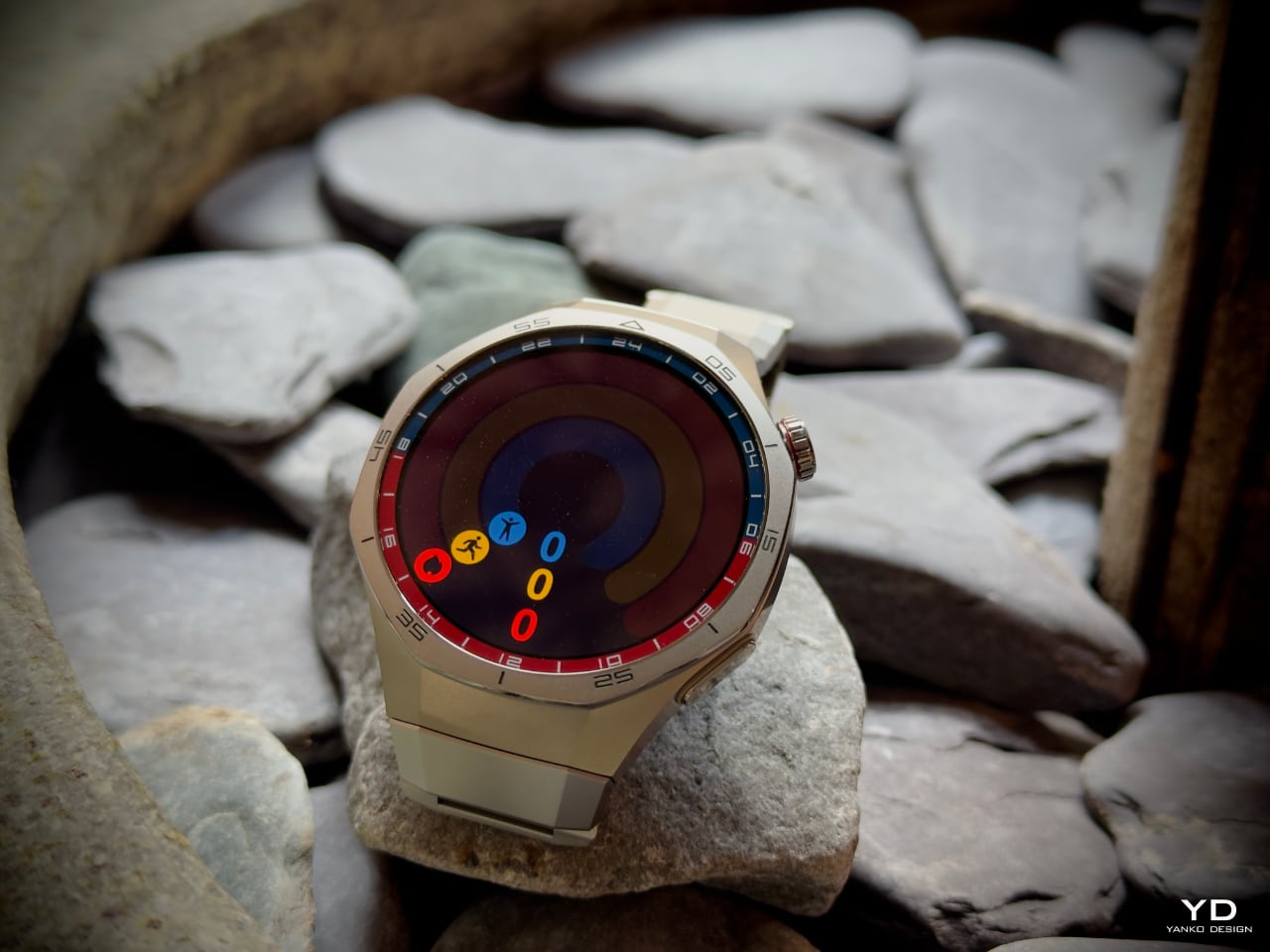
Emotional WellBeing and Management
Beyond physical health, the Huawei Watch GT 5 Series incorporates a unique emotional wellbeing assistant. This feature leverages heart rate variability (HRV) and autonomic nervous system data to assess and track stress levels. During periods of high stress, such as intense workdays or emotional challenges, the watch detects physiological changes and provides actionable insights. Whether you’re feeling happy, sad, or at peace, it records your emotional state, helping you better understand and manage your wellbeing. The built-in breathing exercises help manage stress in real time, guiding users through calming practices that restore balance.
The emotional wellbeing assistant goes beyond simple stress tracking, offering a holistic view of your mental state. By integrating daily stress fluctuations with physical indicators, the system provides a comprehensive picture of your overall wellbeing. Over time, it identifies patterns, helping you recognize triggers and develop healthier emotional habits. However, this feature is currently only available in China and isn’t offered in the European market.
Sleep Monitoring and Advanced Sleep Cycle Insights
The sleep tracking feature in the TruSense System has undergone significant enhancements. Like many competitors offering sleep data, Huawei’s system provides detailed analyses of sleep stages, including light sleep, deep sleep, and REM cycles. However, it goes beyond merely reporting sleep duration, offering valuable feedback on the quality of each phase. Whether battling insomnia or aiming to optimize your rest for better recovery, this feature delivers personalized insights and recommendations based on your unique sleep patterns.
Future-Proof Flexibility and Accuracy
Huawei has future-proofed the TruSense System by designing it to be flexible and open to iterative updates. Users can expect continued software and hardware performance improvements as the technology progresses, ensuring their devices stay at the cutting edge of health monitoring. Additionally, the TruSense System has been certified by several authoritative health bodies, offering peace of mind regarding the reliability and safety of the data provided.
Sports and Activity Tracking: Tailored for Adventure
The GT5 Pro shines in outdoor activity tracking with its dual-band GPS and support for multiple satellite systems like GPS, GLONASS, Galileo, Beidou, and QZSS. This setup enhances location accuracy and speed, making it great for hiking, running, or cycling. Huawei has taken things further with the new HUAWEI Sunflower Positioning System, which uses an adaptive algorithm to improve accuracy. The watch’s antenna adjusts itself based on your movement, ensuring it points in the right direction, whether cycling or running. This upgraded system reduces issues like distance or pace inaccuracies seen in earlier models, boosting route accuracy by 40%, distance by 30%, and pace by 20%, offering a more reliable tracking experience overall.
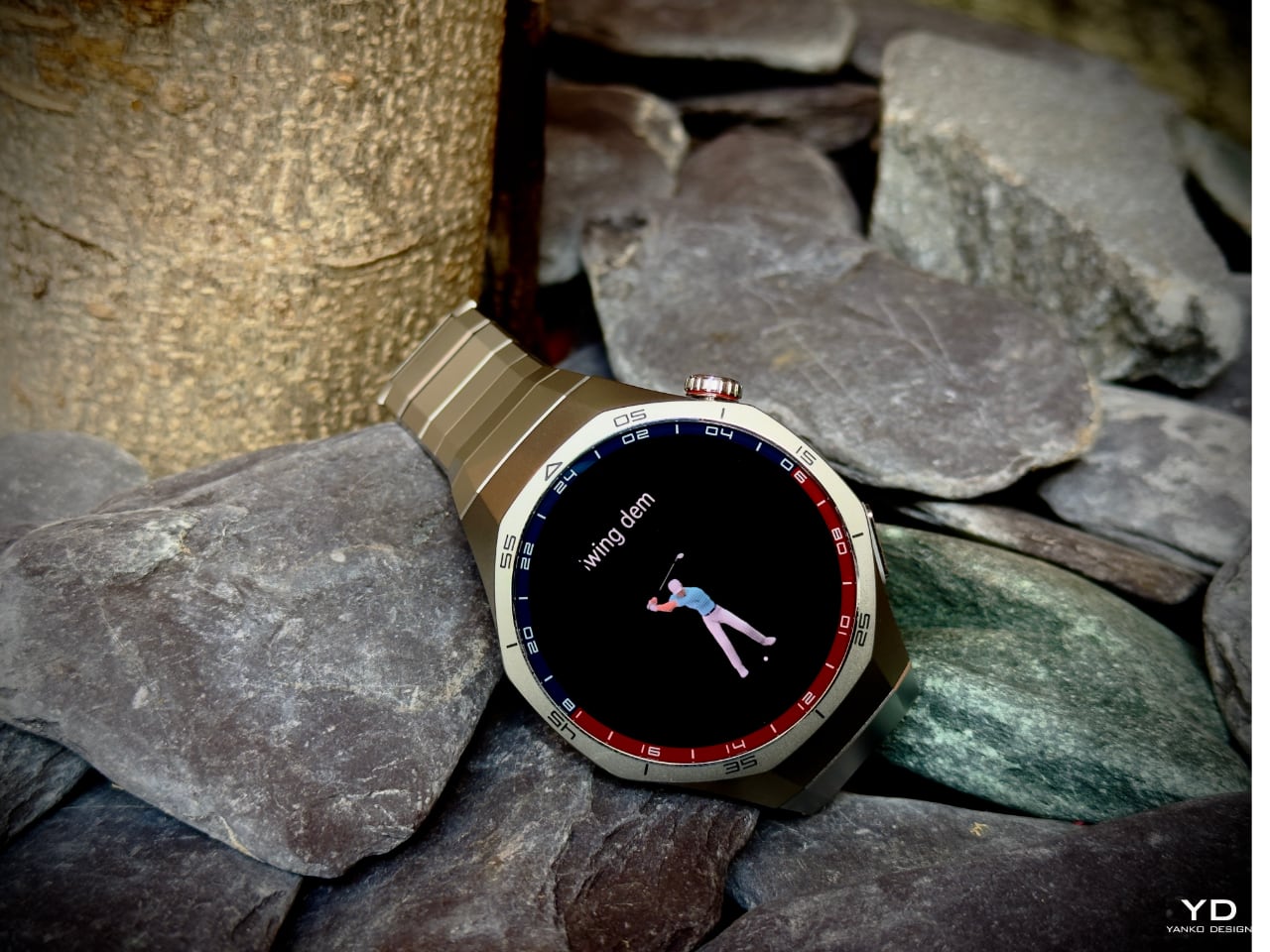
The running form analysis feature is particularly noteworthy. It provides detailed insights into metrics like vertical oscillation, foot contact time, and stride length. These insights help improve performance and reduce the risk of injury.
For outdoor enthusiasts, the offline maps and route back feature offer great value. Whether you’re hiking or exploring new trails, the watch provides accurate mapping and assists with navigation, helping you find your way if you lose track of your path.
Water Resistance and Freediving Mode: Dive In with Confidence
With a 5 ATM water resistance rating, the GT5 Pro is ideal for swimming and water sports. Its freediving mode supports dives of up to 40 meters, tracking depth and dive duration. I took the ceramic model snorkeling, and it performed flawlessly with no issues, even after prolonged exposure to saltwater.
Battery Life: Long-Lasting Performance
Huawei is renowned for the impressive battery life of its smartwatches, and the GT5 Pro doesn’t disappoint. The 46mm titanium model offers up to 14 days of battery life, while the 42mm ceramic model provides up to 7 days. Even with GNSS tracking, continuous health monitoring, and the always-on display active, I comfortably went several days without recharging.
When it’s time to recharge, the Watch GT5 Pro 46mm exclusively supports fast wireless charging. A quick 10-minute charge gives enough power for an entire day, making it especially convenient for those with busy schedules.
Smartwatch Features and Connectivity: Beyond Fitness
The GT5 Pro goes beyond fitness tracking by offering features that enhance daily connectivity. One standout is the keyboard input, allowing you to respond to messages directly from the watch. Though currently limited to specific apps, it adds convenience when accessing your phone isn’t an option. Music control is also intuitive, whether you’re streaming from your smartphone or playing stored songs directly from the watch. With compatibility across Android, iOS, and Huawei devices, the GT5 Pro ensures a seamless experience no matter which platform you use.
Should You Upgrade? A Worthwhile Investment
For GT4 Users:
The GT5 Pro offers significant upgrades in both materials and functionality. The introduction of premium materials like titanium and ceramic, the advanced TruSense system, and enhanced health tracking make it a worthwhile upgrade.
For GT3 Pro Users:
The GT5 Pro builds on its predecessor’s strengths. With improved GNSS accuracy, expanded health monitoring—including emotional wellbeing tracking—and refined aesthetics, it represents a solid step forward for those seeking the latest wearable technology.
Final Thoughts: A Premium Watch for the Modern User
The Huawei Watch GT5 Pro seamlessly merges style and functionality. Its premium materials, cutting-edge health features, and impressive battery life make it a standout choice for anyone looking for a smartwatch that doesn’t compromise design or performance.
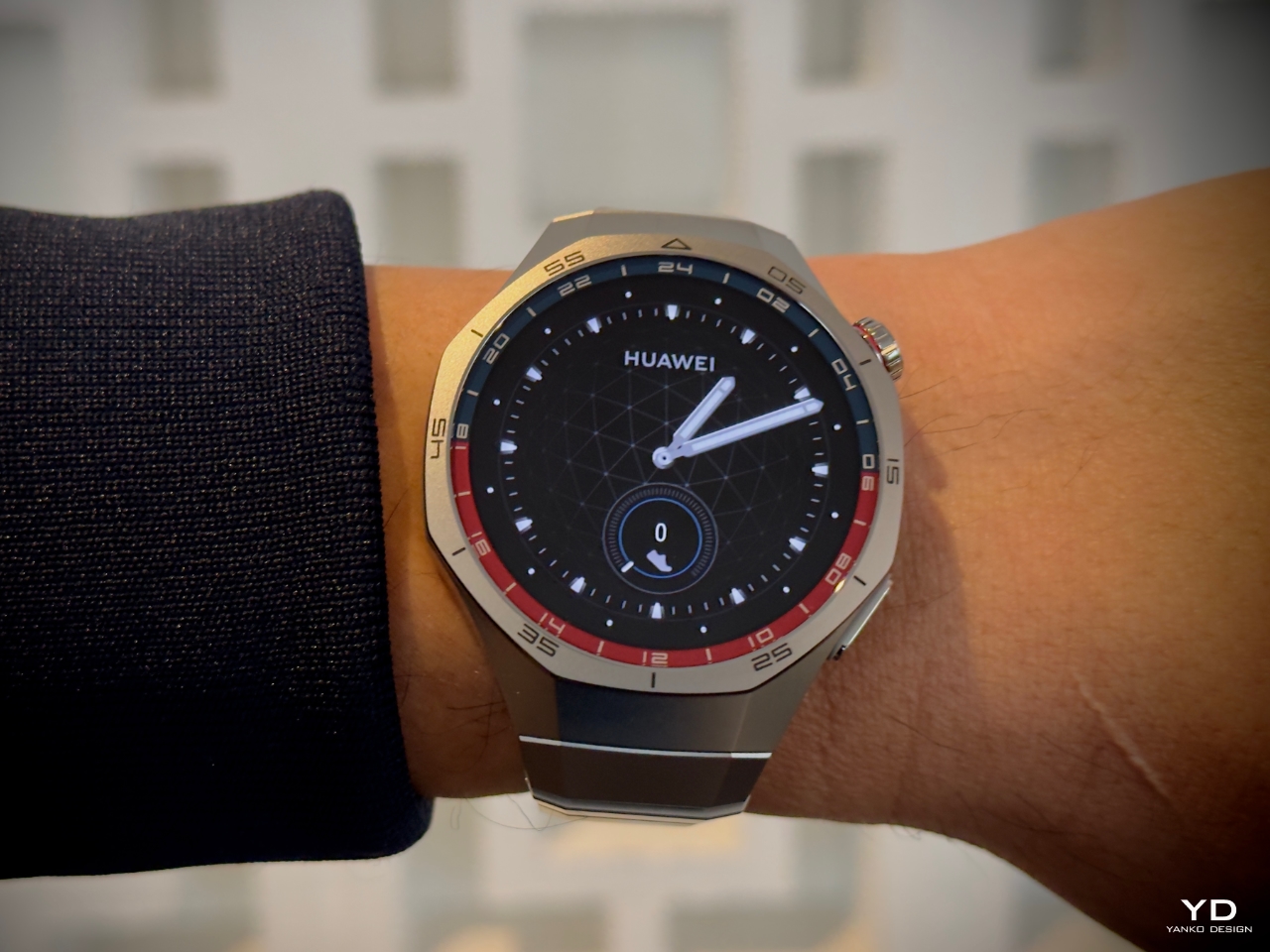
Whether focused on fitness, managing stress, or simply seeking a stylish smartwatch to complement your daily attire, the GT5 Pro is an exceptional choice. It embodies Huawei’s commitment to delivering products that enhance our lives through innovation and quality, making it a worthy addition to any tech-savvy individual’s collection.
The post Huawei Watch GT5 Pro Hands-On Review – Where Luxury Meets Functionality first appeared on Yanko Design.
Here’s Everything Huawei Announced at the Next-Gen Wearables and Tablets Event
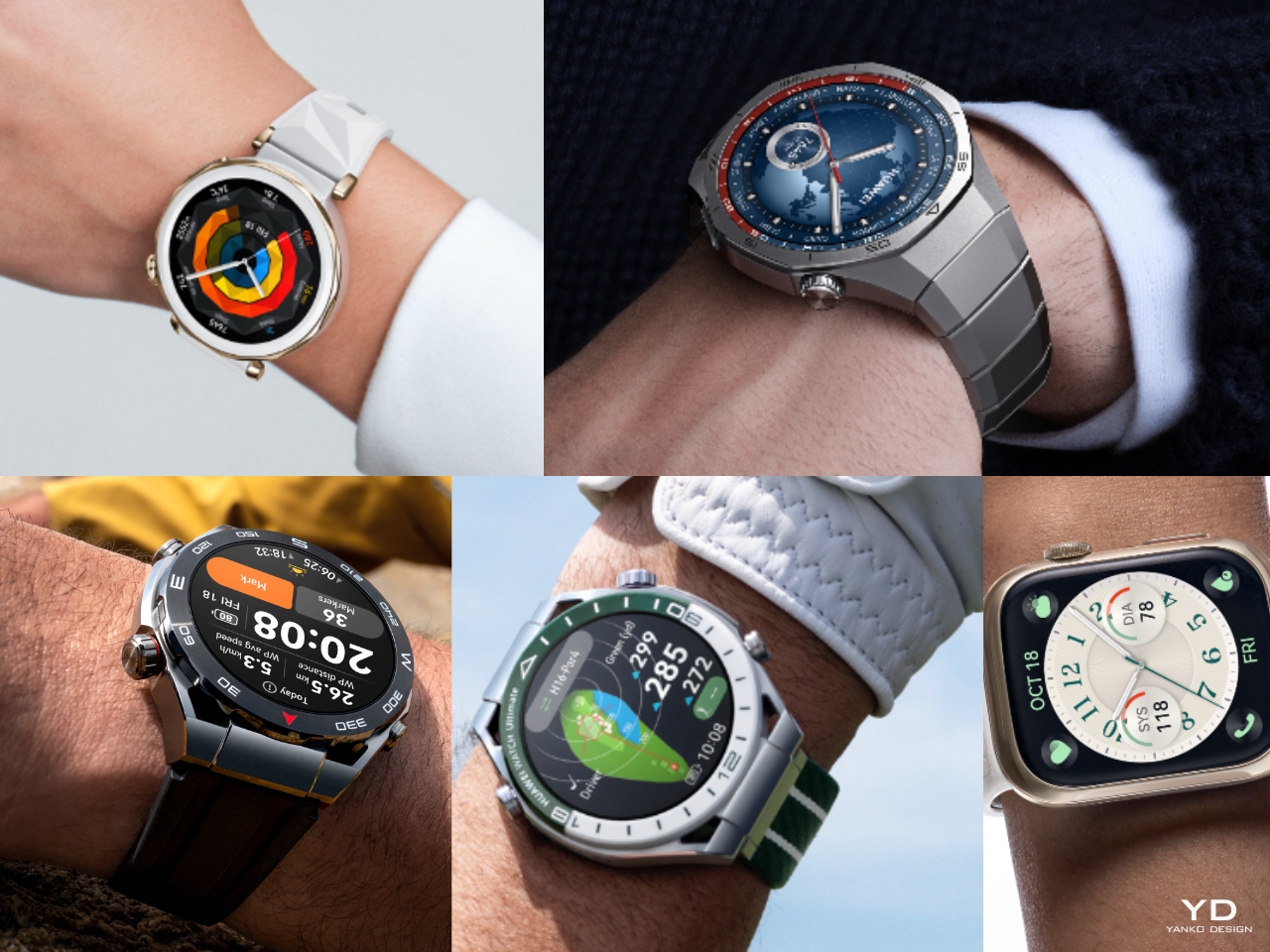
At its big launch event in Barcelona, Huawei unveiled an exciting lineup of products. From stylish wearables like the HUAWEI WATCH GT 5 Series, WATCH D2, and the impressive WATCH Ultimate Green Edition to powerful tablets such as the HUAWEI MatePad Pro 12.2-inch and MatePad 12 X, the company introduced fresh designs and features aimed at boosting both productivity and connectivity.
Designer: Huawei
HUAWEI WATCH GT 5 Series: Fashion Edge Meets Functionality
Huawei unveiled the HUAWEI WATCH GT 5 Series, comprising the GT 5 and GT 5 Pro models, emphasizing a “Fashion Edge” approach that blends style with advanced features. The watches are designed for users seeking a balance between aesthetics and performance.

The GT 5 Pro is crafted from premium materials, including aerospace-grade titanium alloy for enhanced durability and a nanocrystal ceramic bezel for a luxurious touch. Its sleek, sharp-edged design makes the watch suitable for fitness activities and formal occasions.
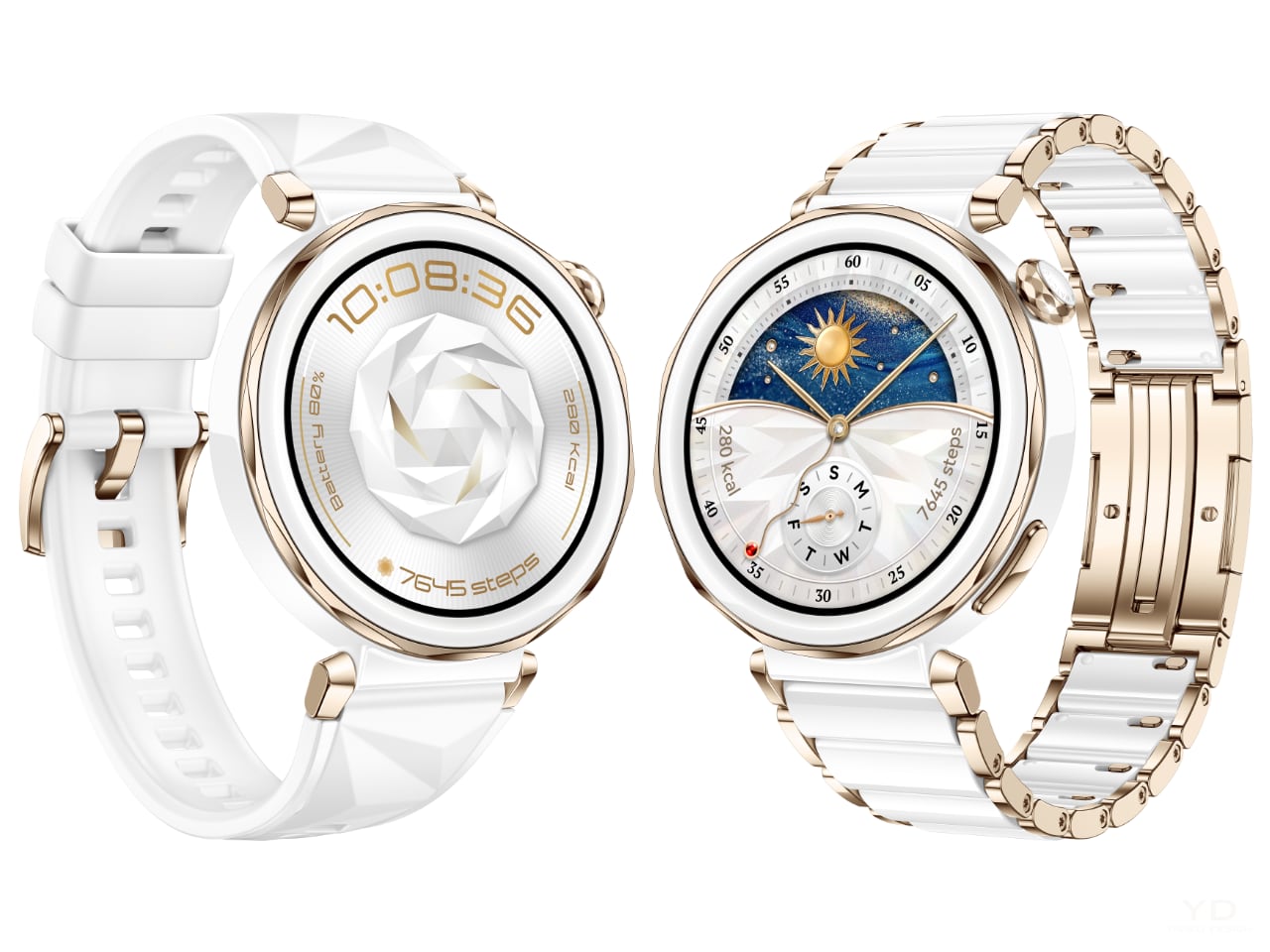
The event featured appearances by HUAWEI Wearable Product Ambassadors Pamela Reif and Sir Mo Farah. Pamela Reif focused on the design aspects of the watches and discussed the app fitness courses, showcasing the “Light Up Your Rings” experience. She expressed her admiration for the new watch, stating: “The HUAWEI Watch GT 5 Pro is more than a smartwatch; it’s a style icon that really gives me a Fashion Edge. In addition, Huawei has made some really impressive enhancements to the activity tracking. Join me and Light Up Your Rings every day!”
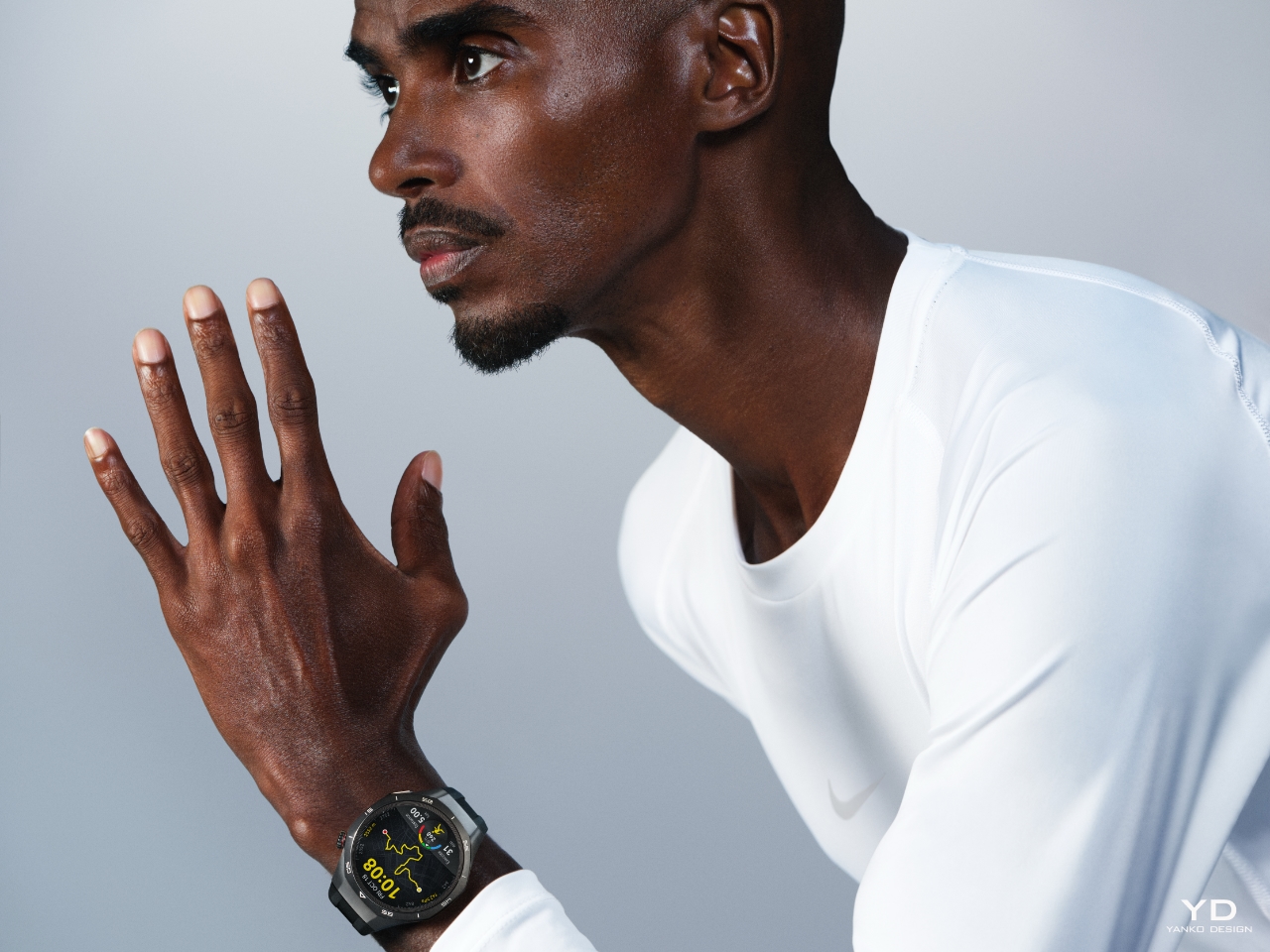
Sir Mo Farah shared his expertise on running and advanced sports techniques, highlighting features that could benefit athletes. He noted: “As a runner, I care about small details to give me a competitive edge. The enhanced Sunflower GPS is an absolute game-changer, while the all-new Running Form analysis feature can give any runner insights into how to shave seconds off their personal best.”
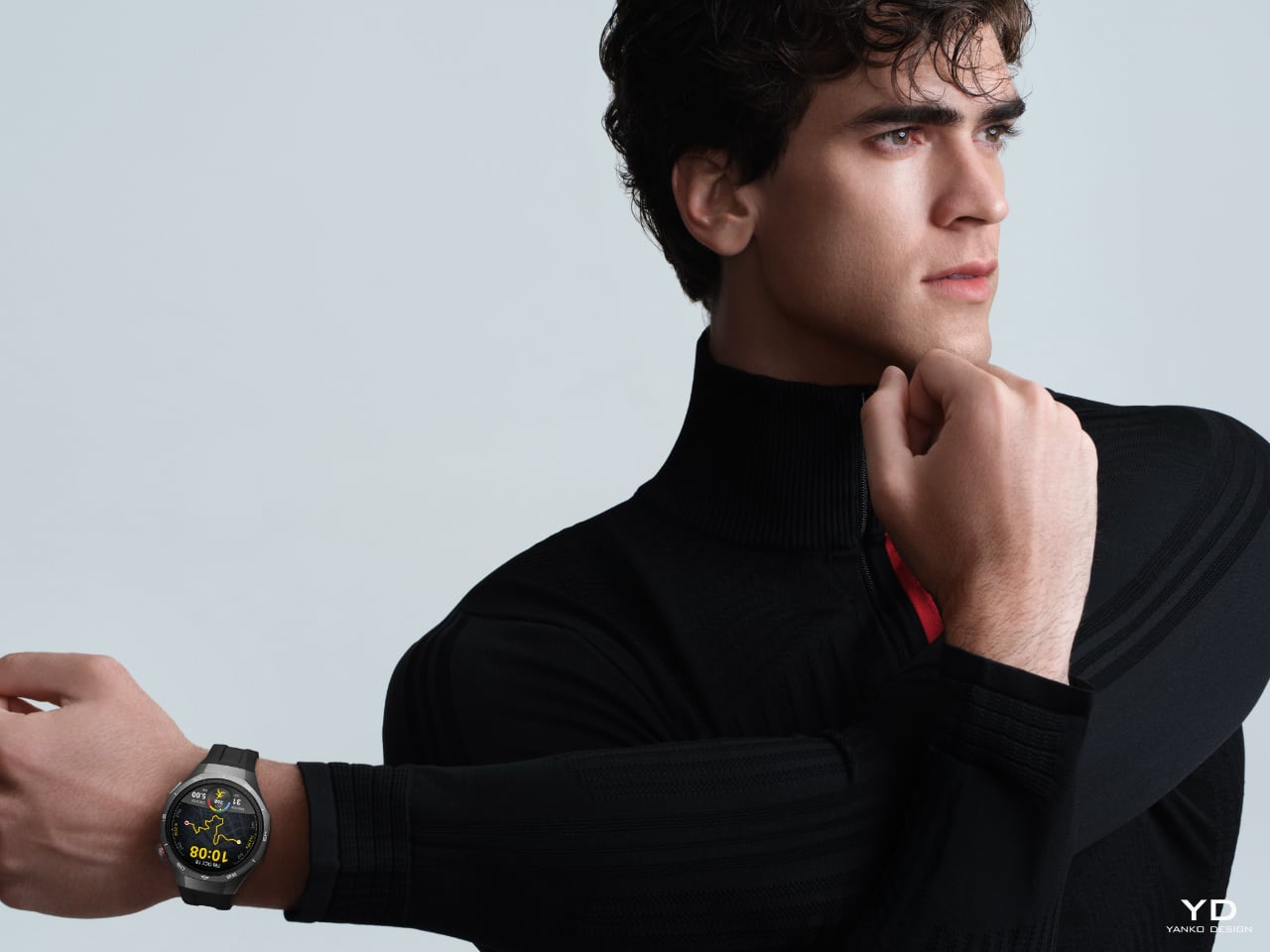
Both models are equipped with the HUAWEI TruSense System, featuring advanced sensors for tracking health metrics such as heart rate, blood oxygen levels, and sleep patterns. The enhanced Sunflower GPS provides accurate positioning, which benefits runners and outdoor enthusiasts. The new Running Form analysis feature offers insights to improve performance by analyzing metrics like stride length and ground contact time.
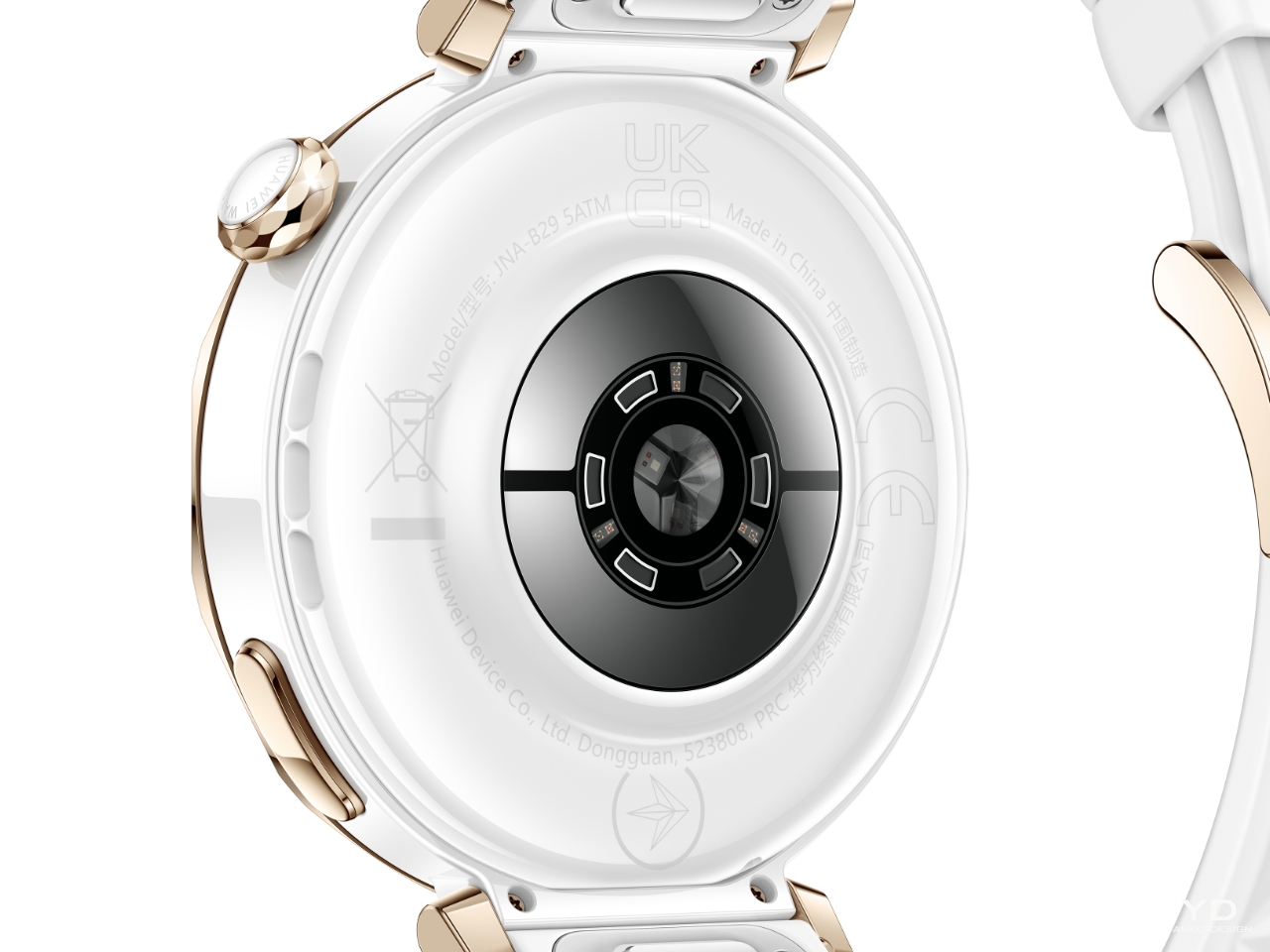
HUAWEI TruSense System
Battery life is a key feature, with the 46mm models offering up to 14 days on a single charge under typical use and the 41mm models providing up to 7 days. The watches are compatible with Android and iOS smartphones, broadening their accessibility.
The HUAWEI WATCH GT 5 Series is available internationally, including the UK and Europe, from September 19, 2024. Pricing starts from £229.99 (RRP) for the GT 5 and £329.99 (RRP) for the GT 5 Pro. Customers ordering from the UK Huawei Store and Amazon between September 19 and October 22 will receive a free pair of HUAWEI FreeBuds 5i earbuds. Additionally, GT 5 Series users are eligible for a free 3-month membership to HUAWEI Health+, offering exclusive workouts, guided meditations, the Stay Fit Plan, and breathing exercises.
HUAWEI WATCH D2: Advancing Health Monitoring
Huawei introduced the HUAWEI WATCH D2 as the world’s first wrist-based, ambulatory blood pressure monitoring (ABPM) device to be certified by China’s National Medical Products Administration (NMPA) and the European Union’s Medical Device Regulation (MDR). This represents a significant advancement in wearable technology, embodying Huawei’s commitment to health-focused innovation.
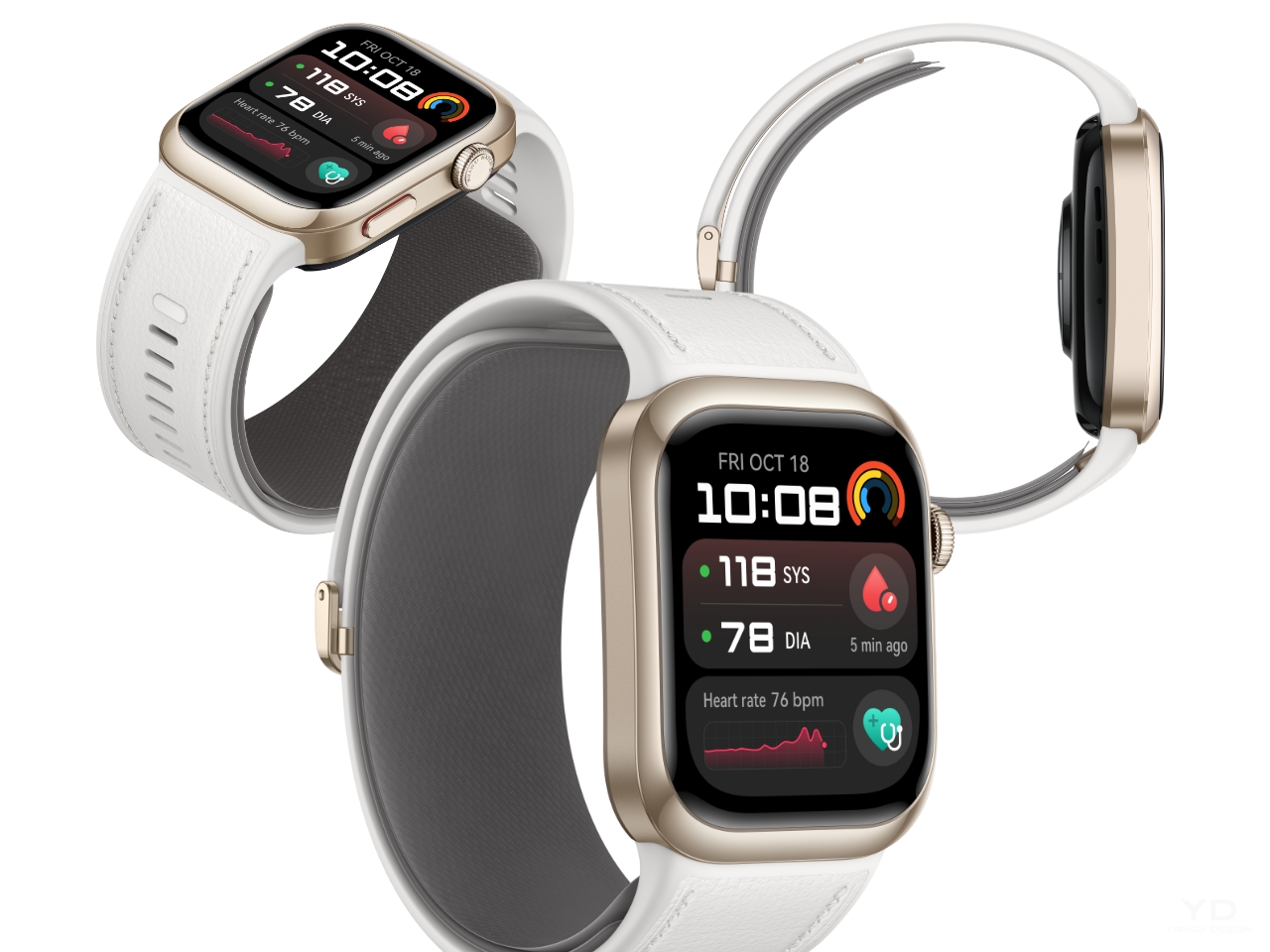
Huawei Watch D2
The watch delivers 24-hour accurate blood pressure measurements and features the HUAWEI TruSense System for faster and more precise results. Huawei has invested over nine years in developing this blood pressure technology, collaborating with global hypertension experts like Professor Gregory Stergiou and Professor Wang Jiguang.
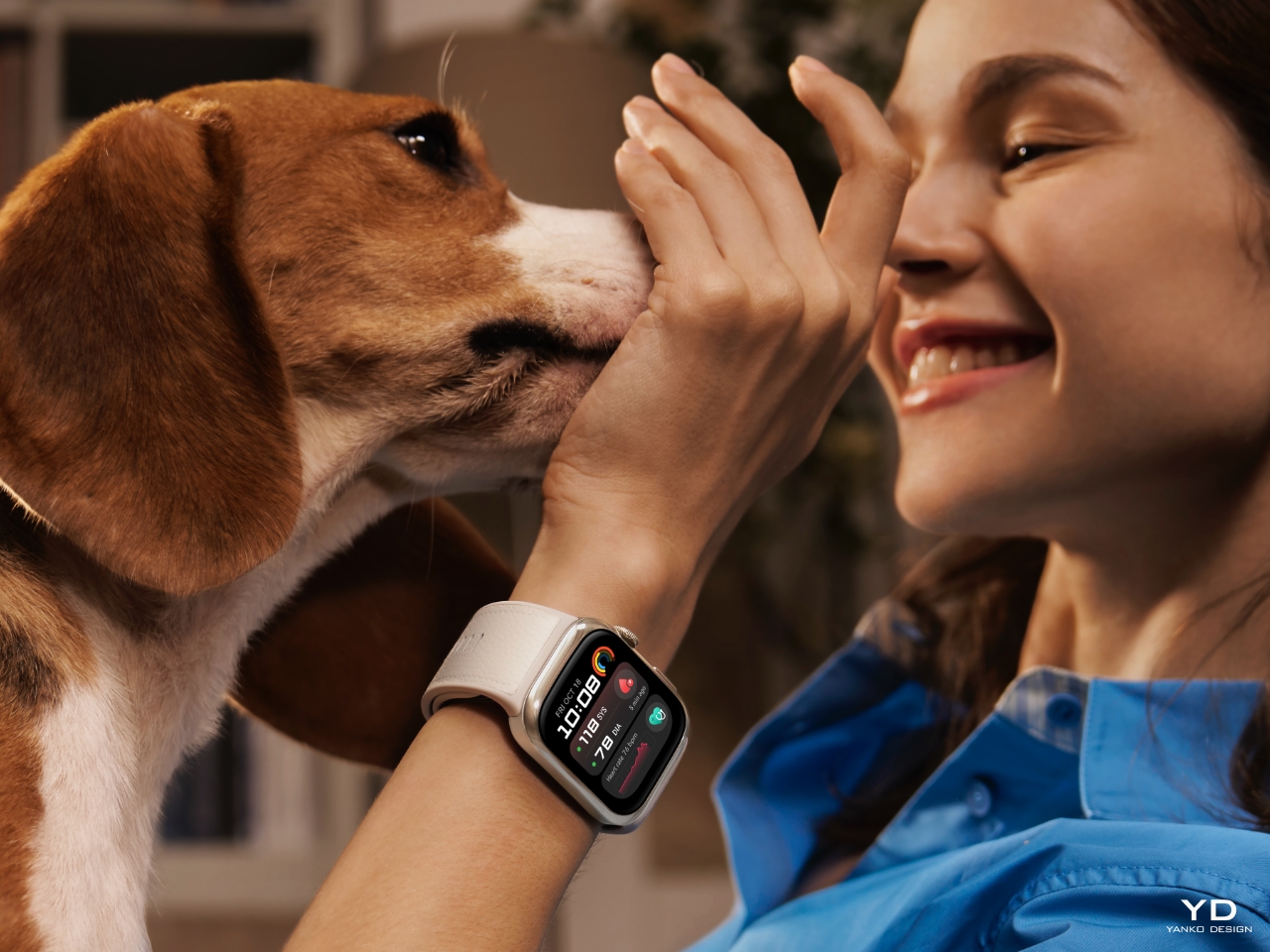
The HUAWEI WATCH D2 sports a light and slim design, incorporating an ultra-narrow mechanical airbag and a 1.82-inch large screen. It is about one-fifth the width and one-twenty-fifth the volume of traditional upper-arm electronic blood pressure monitors, making it convenient for on-the-go measurements.
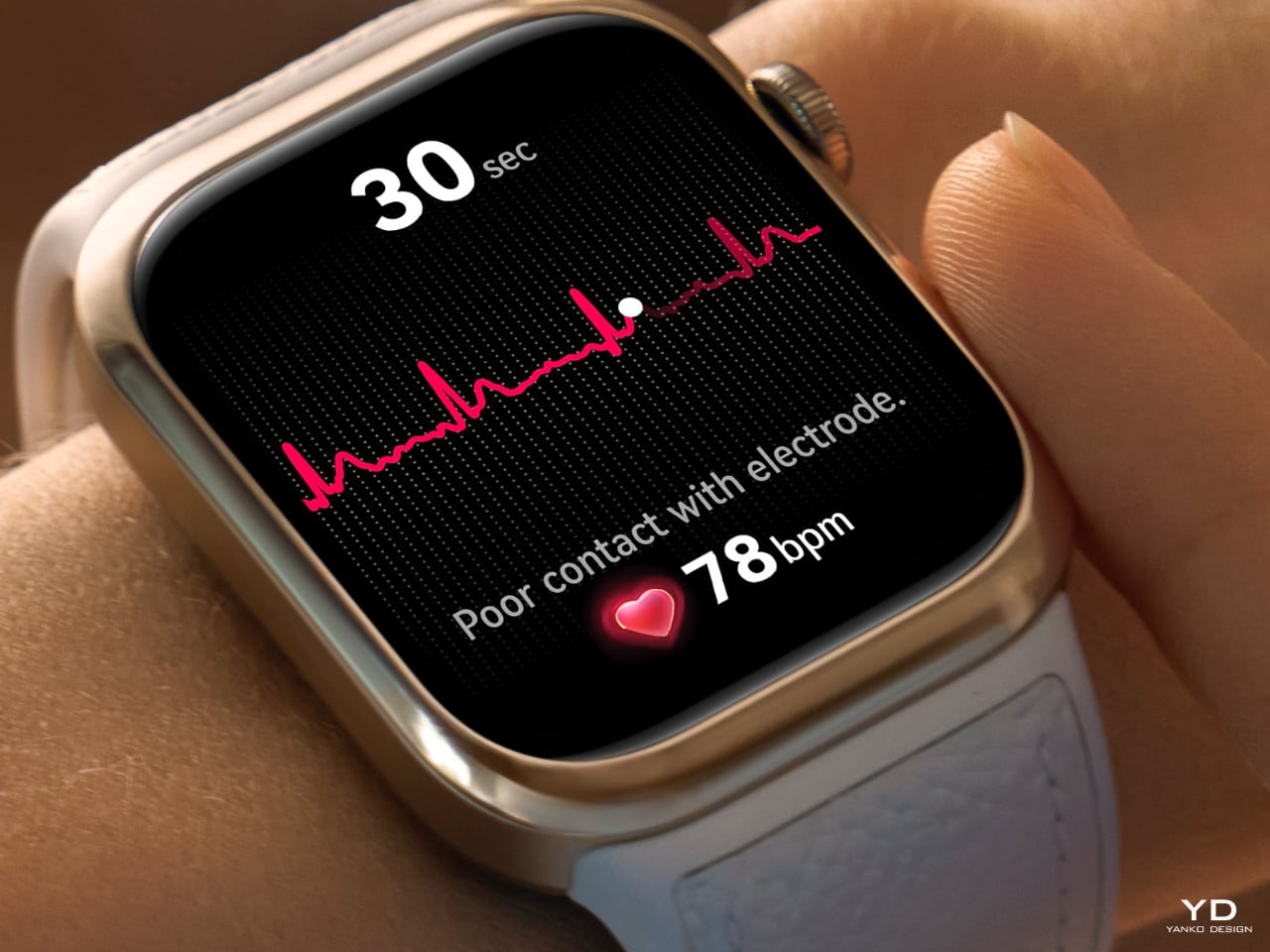
With a single tap, users can measure up to nine body indicators and generate a Health Overview report, providing a comprehensive snapshot of their well-being. In addition to blood pressure monitoring, the watch includes features like ECG analysis, sleep tracking, and stress monitoring.
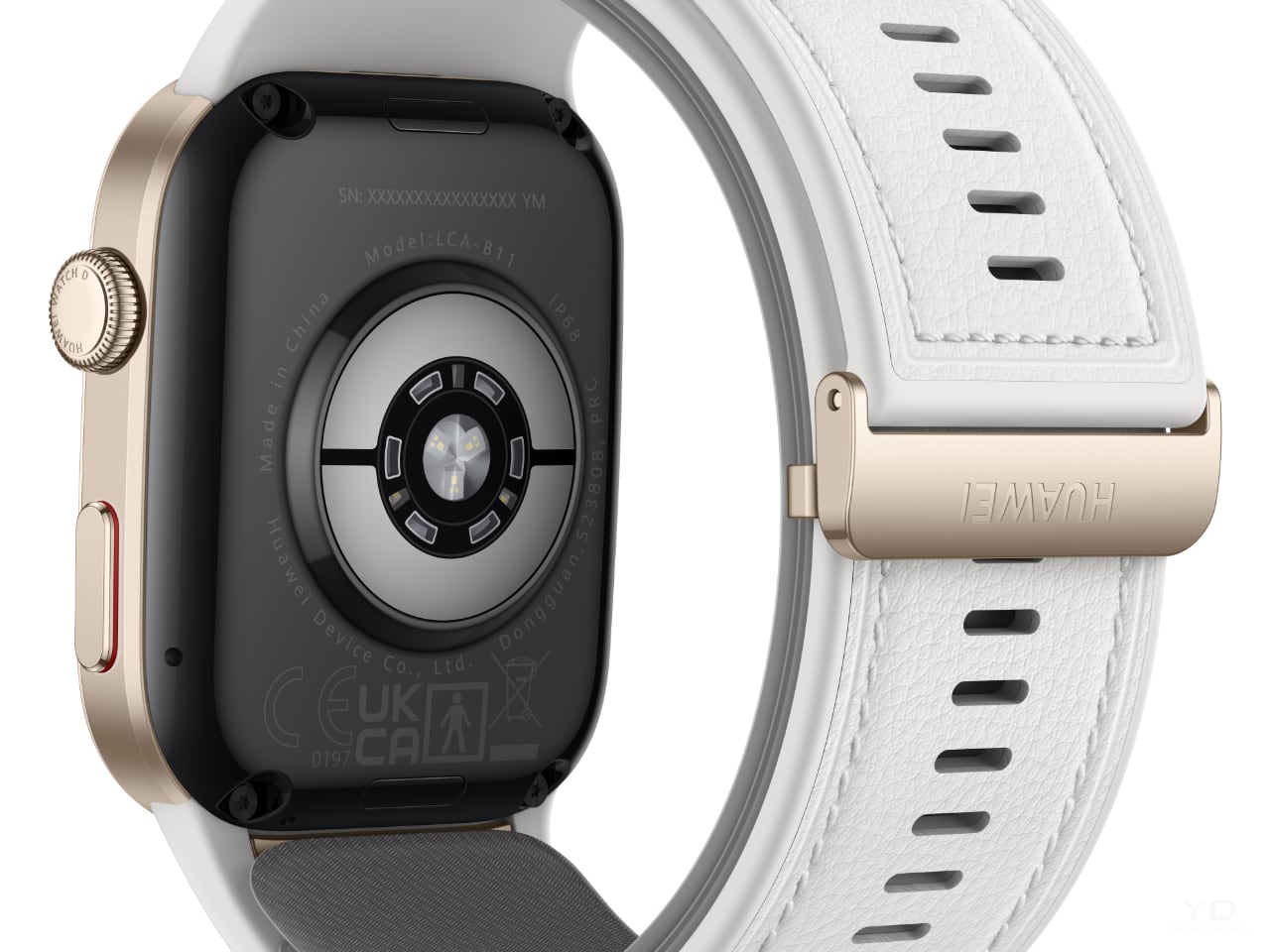
The HUAWEI WATCH D2 is available internationally from September 19, 2024, priced at £349.99 (RRP). Customers ordering from the UK Huawei Store and Amazon between September 19 and October 22 will receive a free pair of HUAWEI FreeBuds 5i earbuds.
HUAWEI WATCH Ultimate Green Edition: Explore Without Limits
Building on last year’s release, the HUAWEI WATCH Ultimate introduces new Advanced Golf Course features, an enhanced Expedition Mode, and a new green colorway combining cutting-edge technology with craftsmanship. This aligns with the “Adventure Forward” spirit, catering to adventurous users at heart.
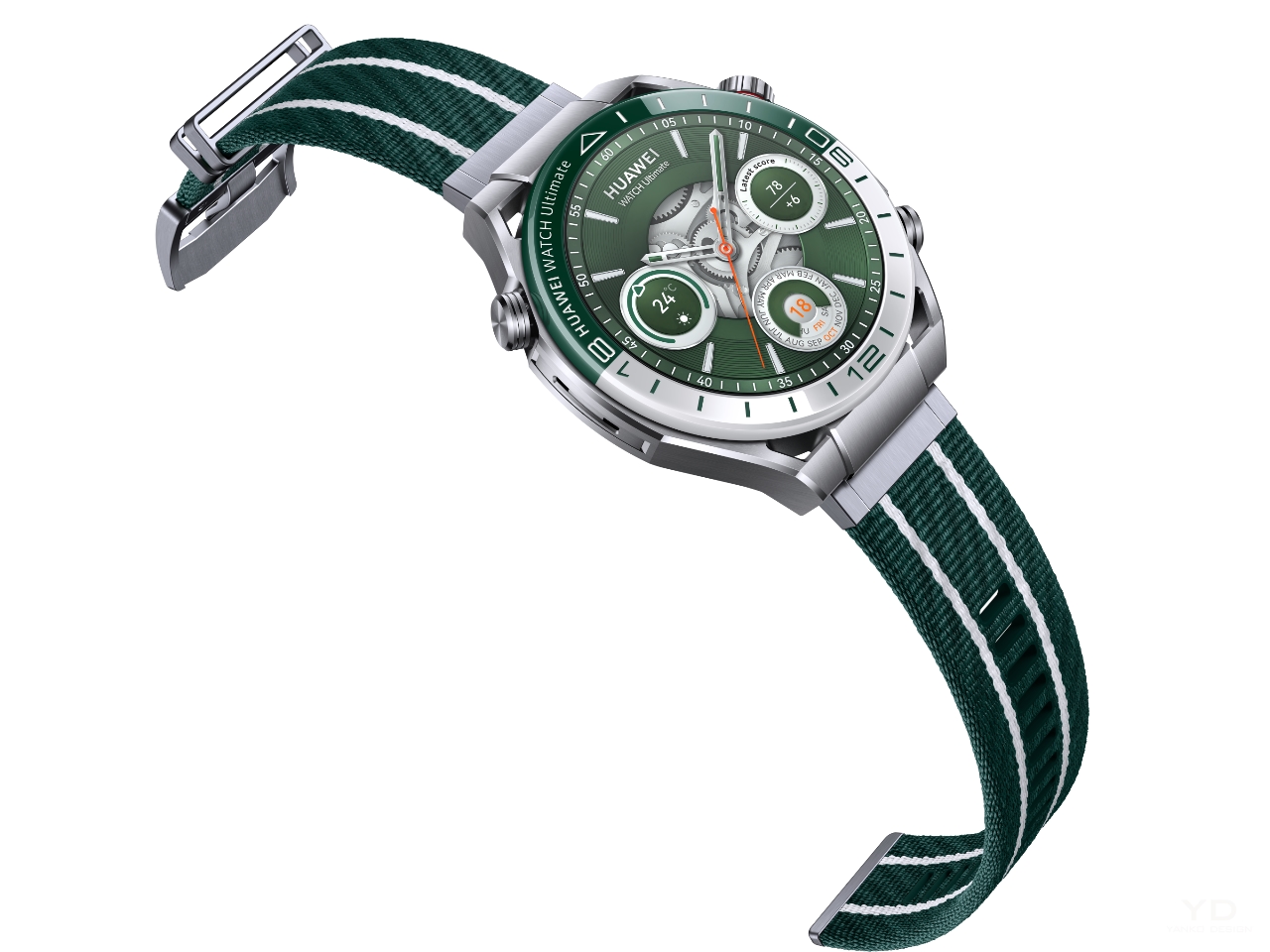
The new Green Edition features an exclusive dual-color nano-tech ceramic bezel, achieved through a complex manufacturing process resulting in a striking white-green duo. The watch continues to use premium materials such as zirconium-based liquid metal for the case and sapphire crystal glass for the display, ensuring durability and luxury.
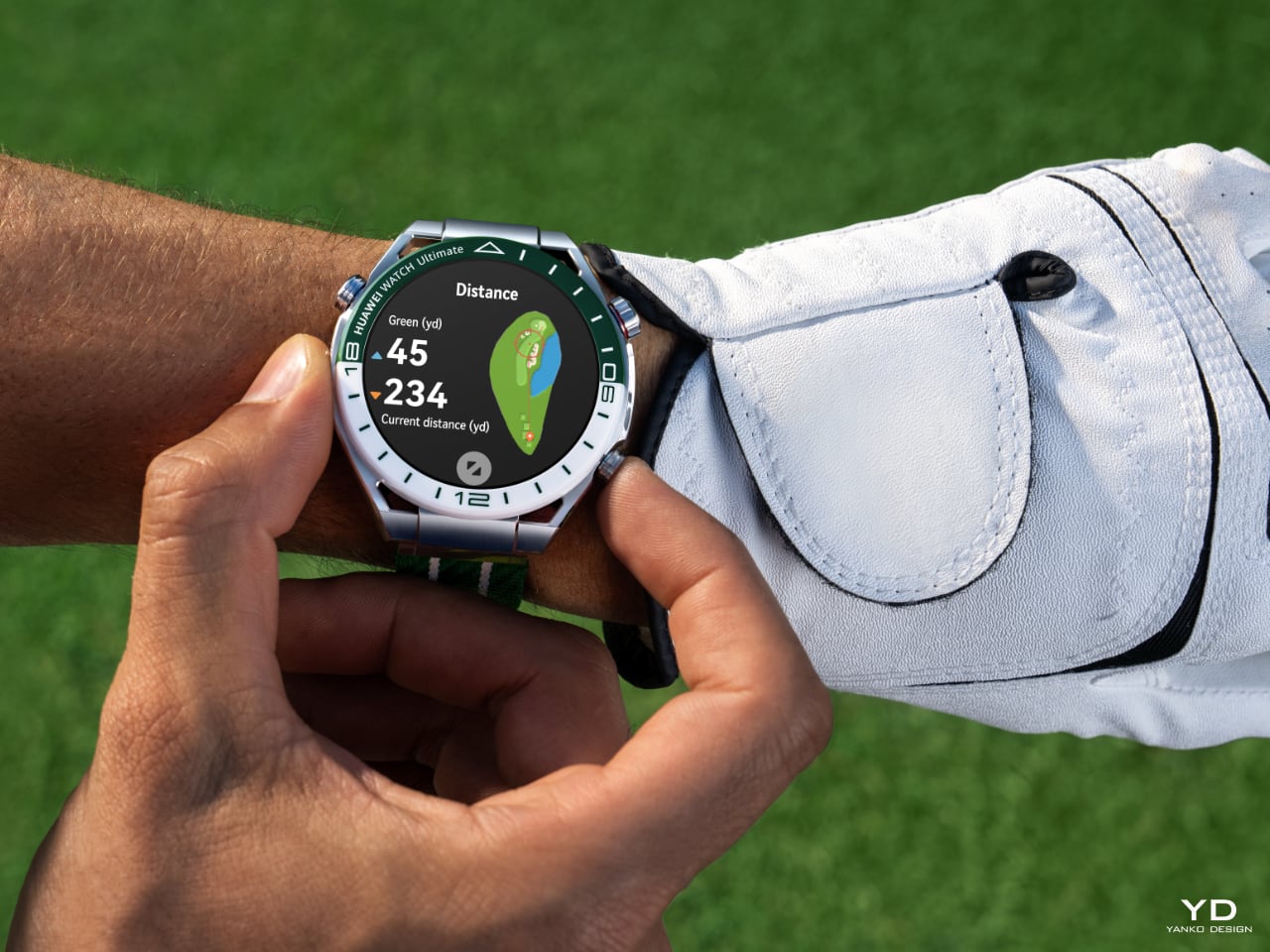
The Advanced Golf Course Mode offers precise analytics and insights for golf enthusiasts, including play distance, shot distance, AI Caddie recommendations, and more. With access to over 15,000 global golf course maps, golfers can strategize their shots and navigate courses effectively. The “Plays-Like” distance functionality considers the slope of the fairway to display adjusted distances, and the dual-frequency five-system GNSS enhances positioning accuracy.
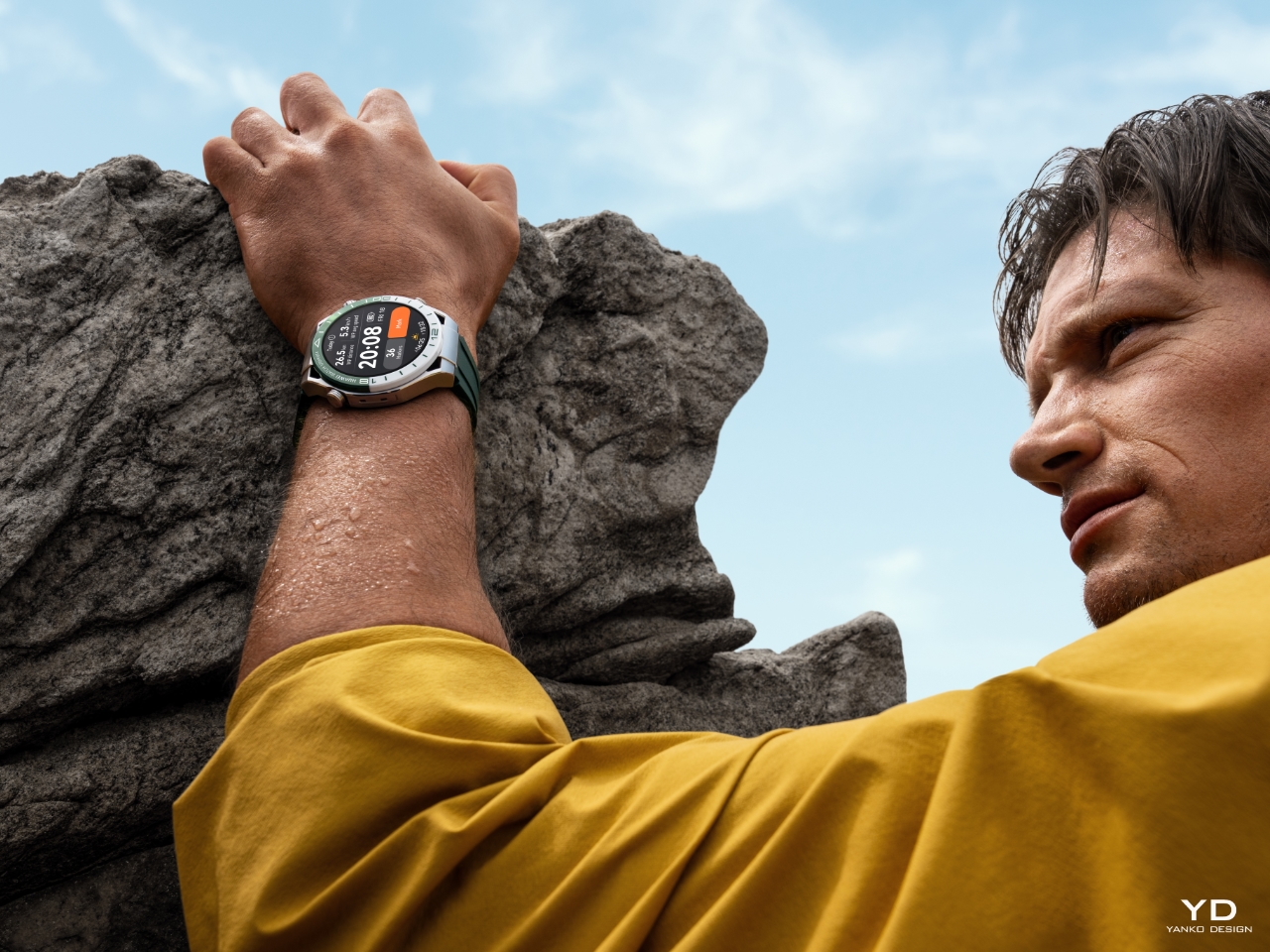
For explorers, the enhanced Expedition Mode now supports downloading all-color contour maps for offline use, aiding navigation even without connectivity. The Route Import feature allows users to import routes directly from the HUAWEI Health app, making planning and tracking expeditions easier.
The watch supports ECG analysis using high-performance PPG and ECG sensors, providing comprehensive health monitoring. With water resistance up to 100 meters and EN13319 certification for diving accessories, it supports free dives at depths of up to 100 meters. The HUAWEI WATCH Ultimate Green Edition offers up to 14 days of battery life under typical use.
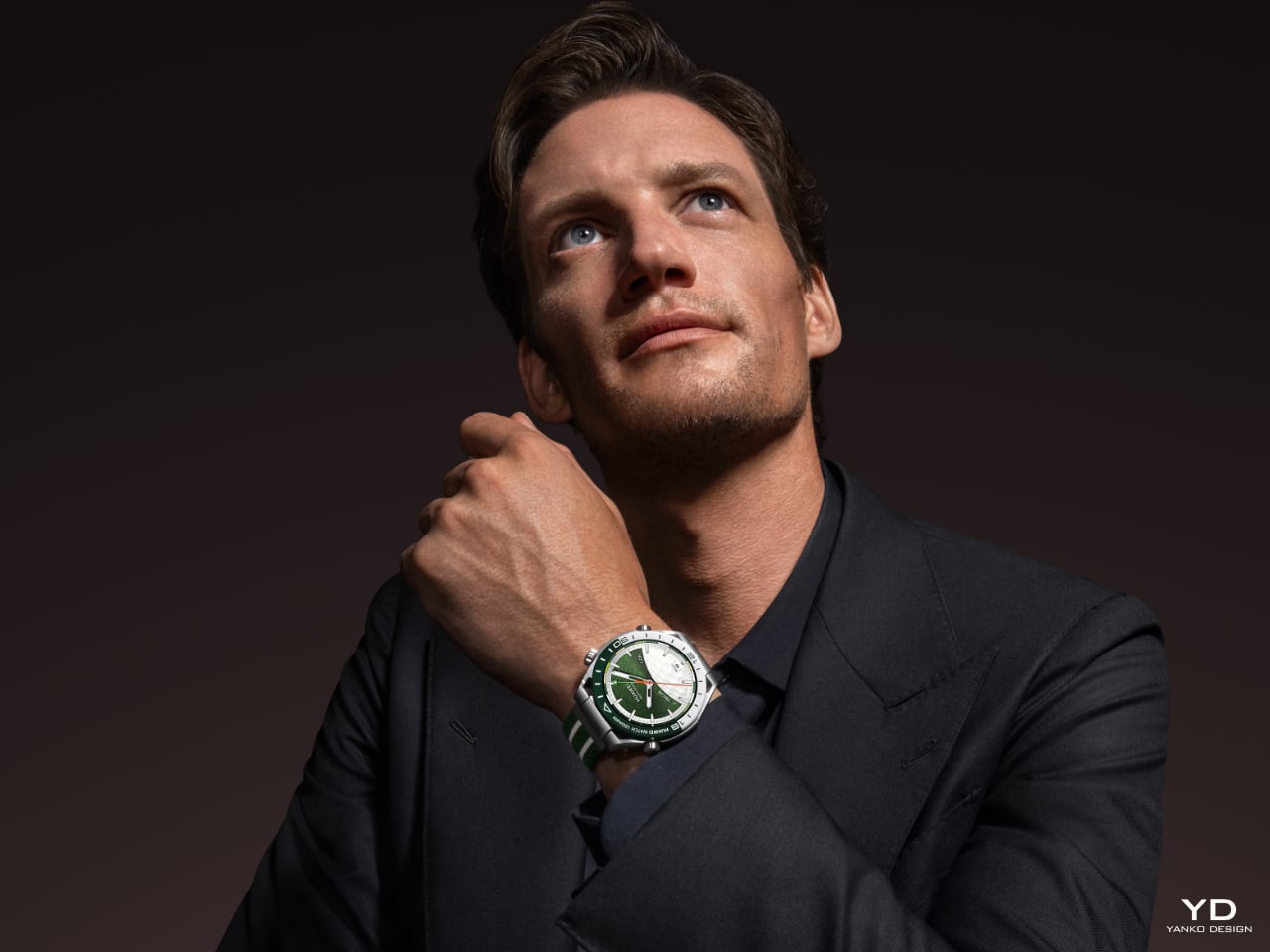
Available internationally from September 19, 2024, the HUAWEI WATCH Ultimate Green Edition is priced at £749.99 (RRP). Customers ordering from the UK Huawei Store and Amazon between September 19 and October 22 will receive a free pair of HUAWEI FreeBuds Pro 3 earbuds.
HUAWEI MatePad Pro 12.2-inch: A Canvas for Creativity
The HUAWEI MatePad Pro 12.2-inch is the newest flagship tablet designed to deliver an ultimate user experience focused on creativity and productivity.
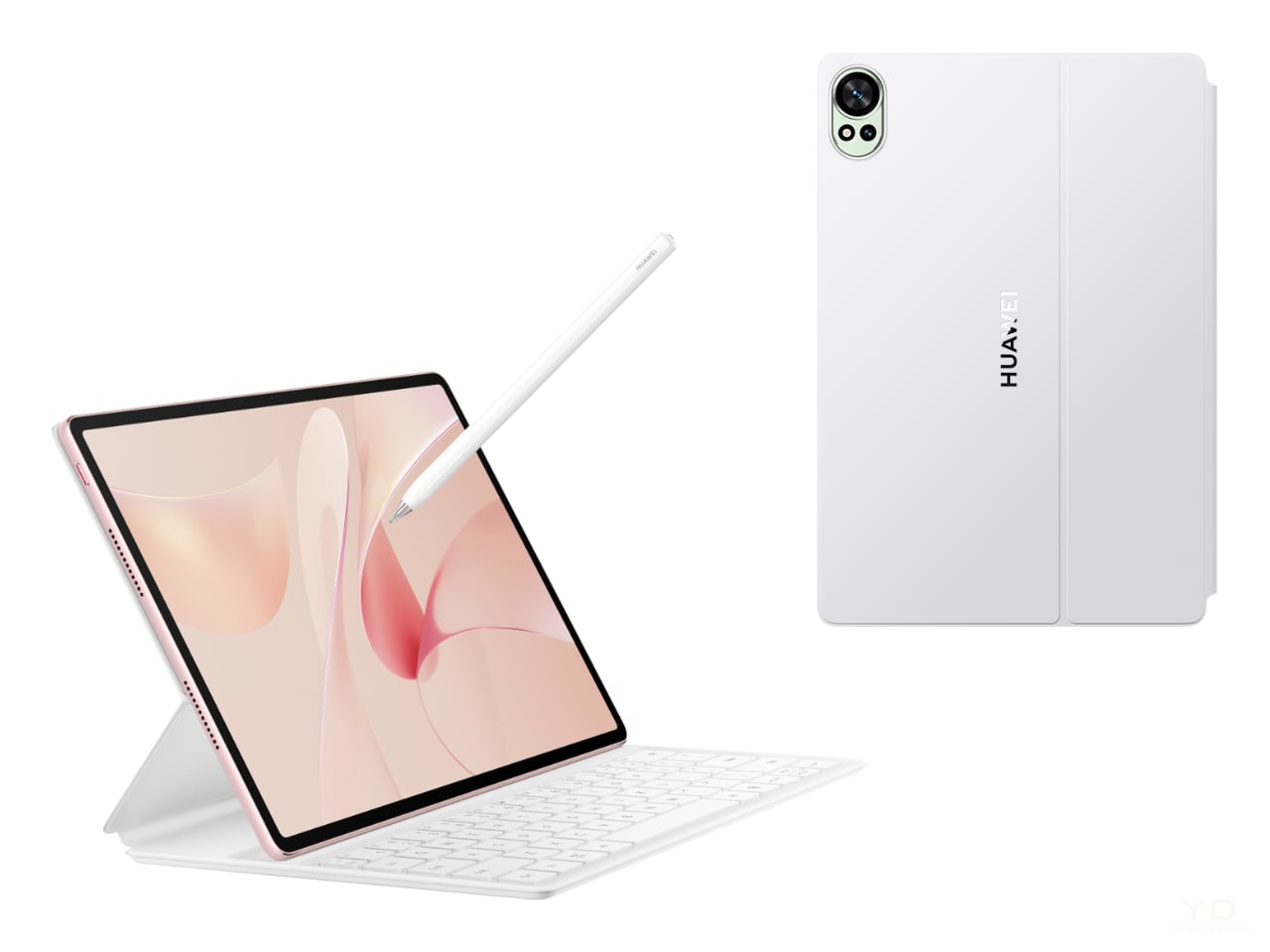
It features an innovative Tandem OLED PaperMatte Display, delivering an impressive maximum brightness of 2000 nits for an authentic viewing experience. Advanced anti-sparkle and nanoscale anti-glare etching technologies ensure a premium, paper-like visual experience that’s easy on the eyes, making it suitable for various lighting conditions.
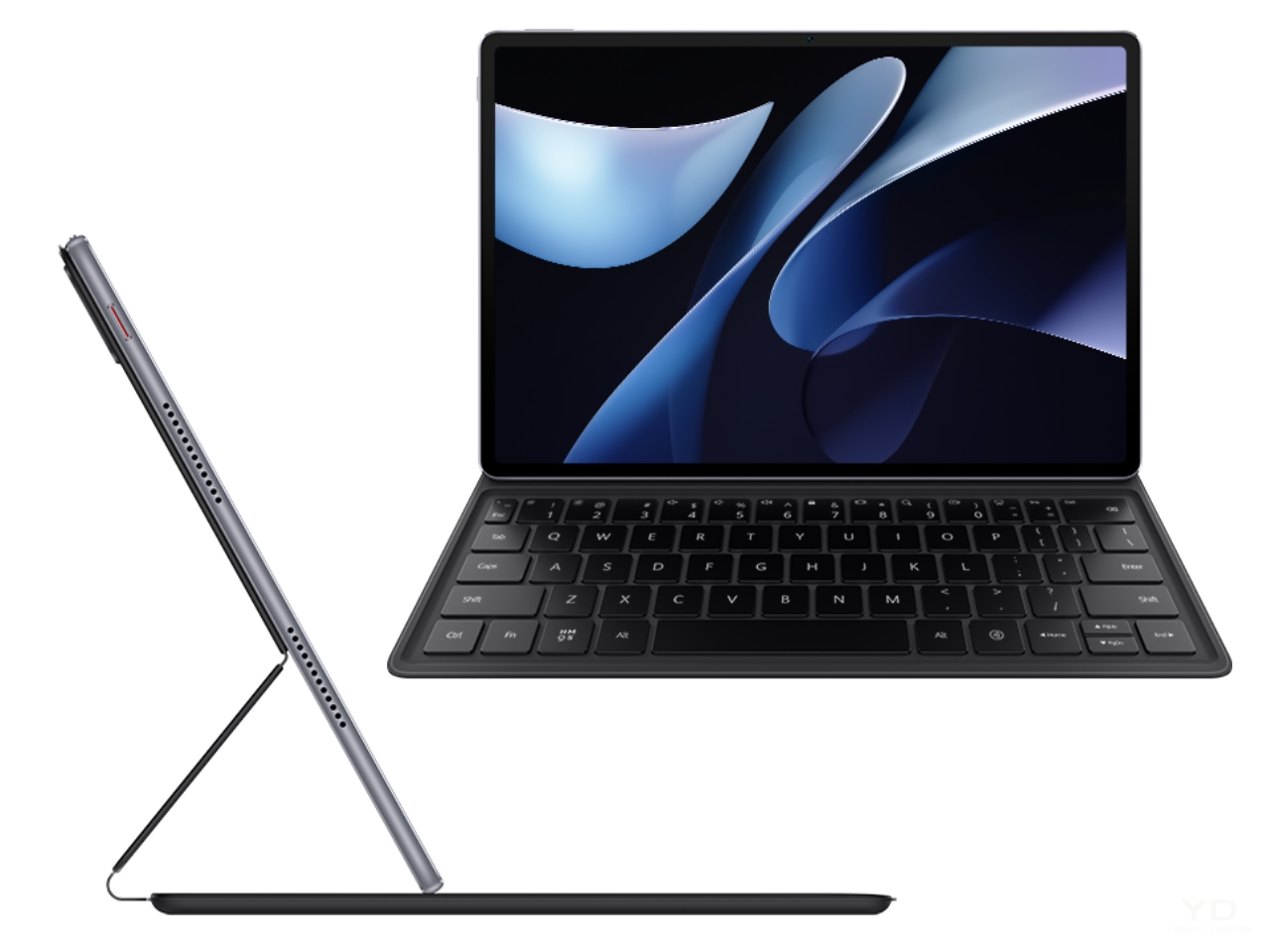
Equipped with the HUAWEI Glide Keyboard, featuring a 2-in-1 stylus and keyboard storage and charging design, the tablet facilitates seamless transitions between drawing, note-taking, and typing. The GoPaint App offers a wide range of digital creation tools, including groundbreaking Splatter brushes and Fluid brushes. The FangTian Painting Engine 2.0 supports 8K ultra-large canvases, providing professional-grade tools for artistic expression.
The HUAWEI MatePad Pro 12.2-inch PaperMatte Edition is available internationally from September 19, 2024. The 256GB storage model in Black with the keyboard included is priced at £699.99 (RRP), while the 512GB storage model in Gold with the keyboard included is priced at £799.99 (RRP). Customers ordering from the UK Huawei Store between September 19 and October 22 will receive a £100 off coupon and a free Huawei M-Pencil 3rd Generation.
HUAWEI MatePad 12 X: Style Meets Productivity
Aimed at a younger demographic, the HUAWEI MatePad 12 X is a lightweight flagship model that boosts productivity while delivering an enjoyable experience.
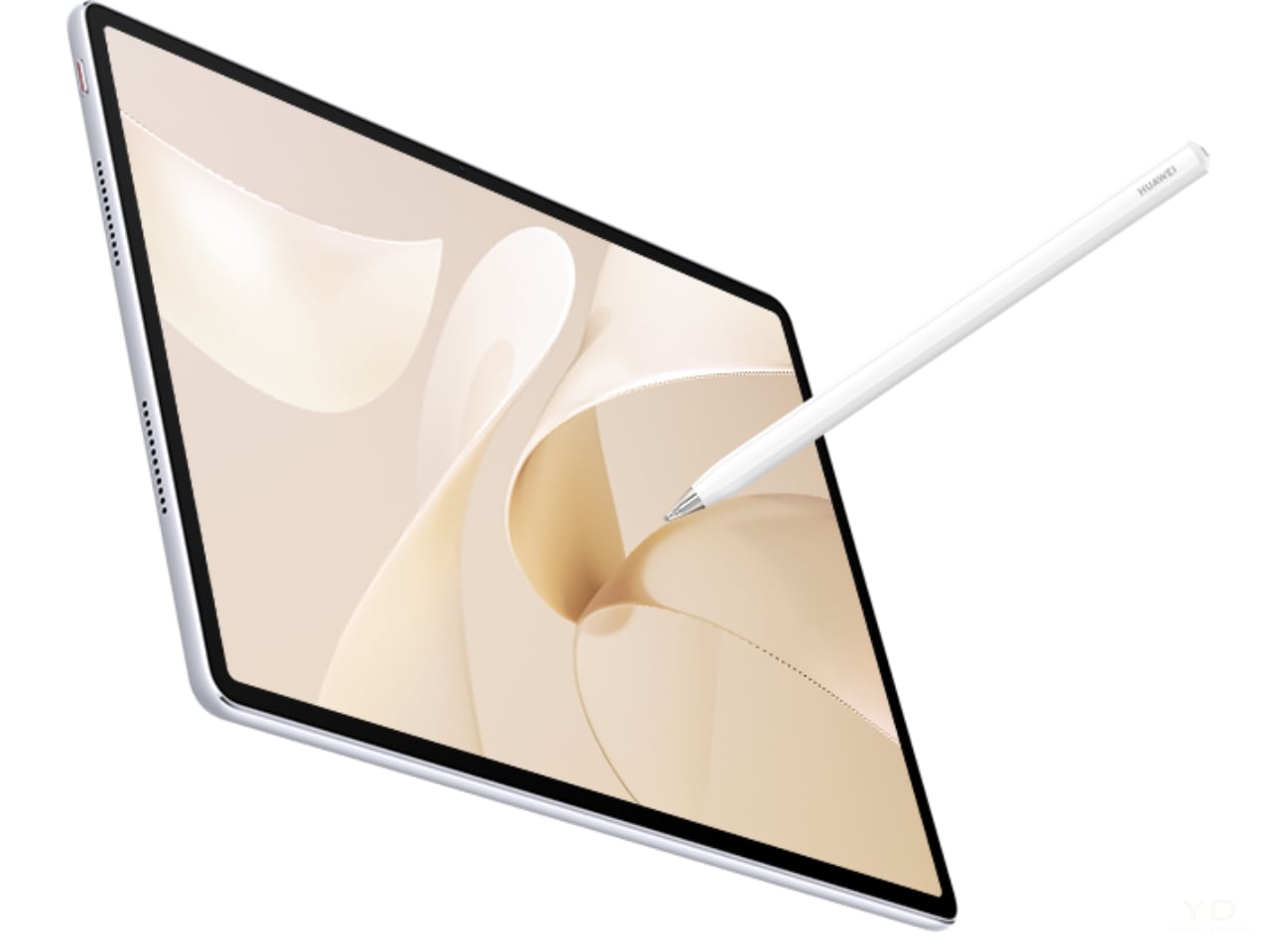
It features the innovative Shimmery Pearlescent Sheen, resulting in a metallic white color that changes based on lighting conditions. The all-metal body with an integrated, seamless design makes it both stylish and durable. The MatePad 12 X PaperMatte Edition features an ultra-bright PaperMatte Display, offering superior quality in viewing, writing, and touch. The display reduces glare, ensuring comfortable use even in brightly lit environments.
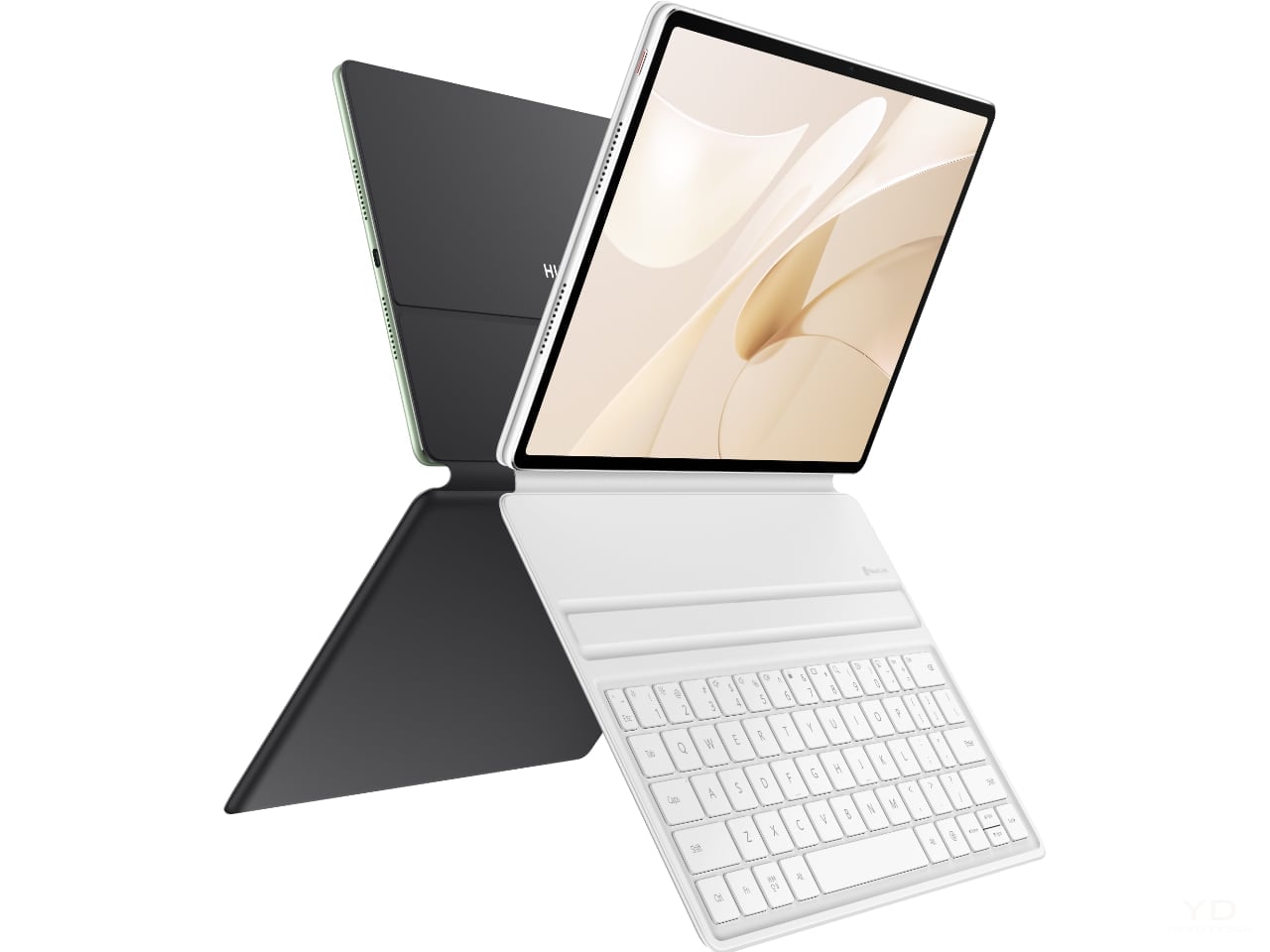
The tablet integrates with Huawei’s GoPaint app, encouraging creative expression with a wide range of digital tools. Huawei has launched the GoPaint Worldwide Creating Activity themed “Creative By Nature,” inviting painting enthusiasts worldwide to share their unique digital artworks on the HUAWEI Community platform until December 31, 2024.
The HUAWEI MatePad 12 X launches internationally from September 19, 2024. The 512GB storage model in Green or White with the keyboard included is priced at £549.99 (RRP). Customers ordering from the UK Huawei Store between September 19 and October 22 will receive a £100 off coupon and a free Huawei M-Pencil 3.
Commitment to Innovation and Creativity
Alex Huang, Chief Marketing Officer of Huawei Consumer BG, emphasized the brand’s global impact and commitment to innovation:
“We aim to bring innovative products that offer consumers a unique blend of fashion and creativity. By inspiring our users, Huawei strives to create a more connected and heartwarming world where technology enhances daily living and brings people closer together.”
Huawei continues to inspire consumers through campaigns like the “Light Up Your Rings” initiative and the “GoPaint Worldwide Creating Activity,” blending technology, fashion, and creativity into their products.
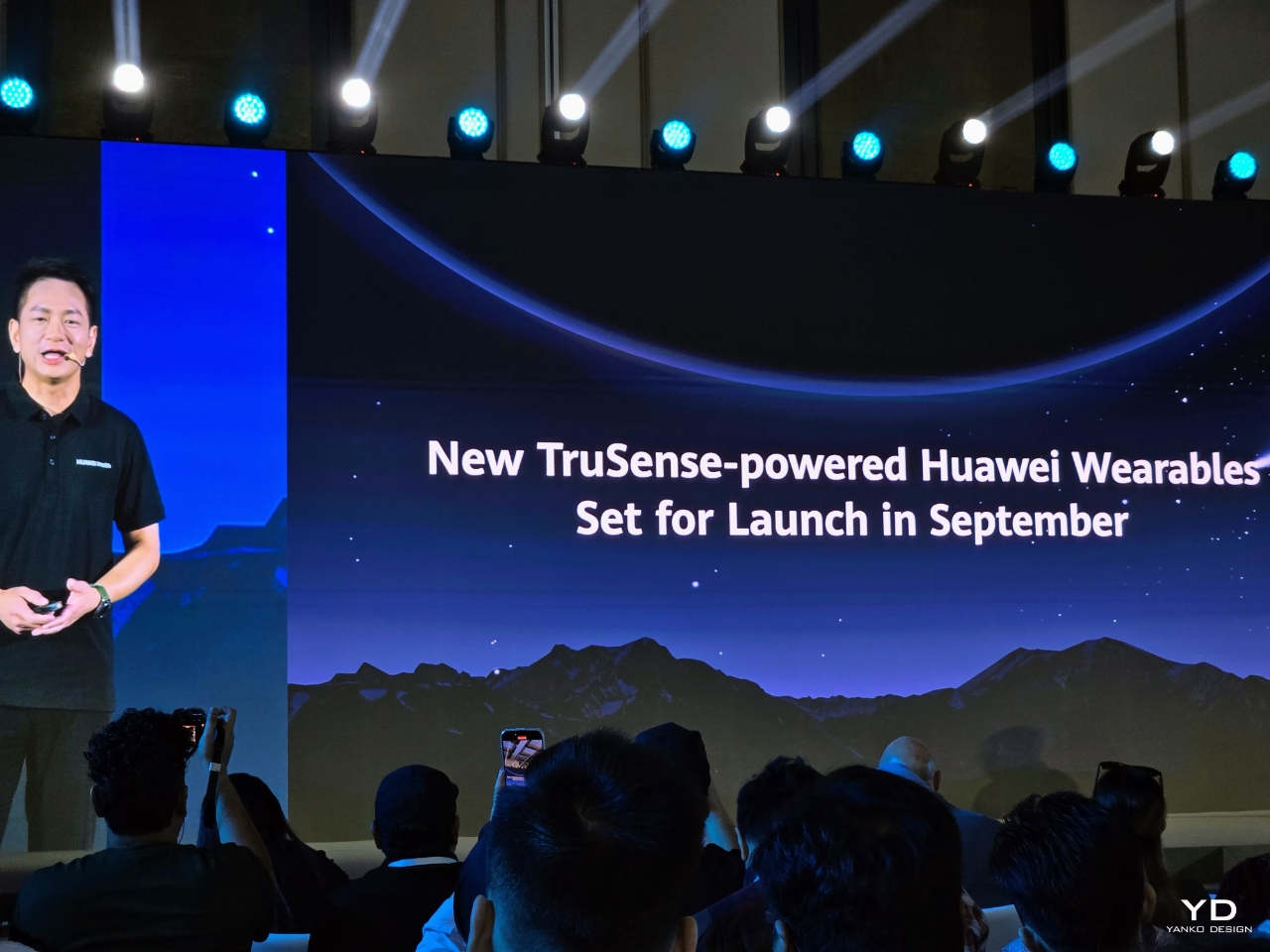
Rico Zhang: President of Smart Wearable and Health Product Line, Huawei Consumer Business Group
Huawei’s latest product lineup showcases its focus on innovation, blending advanced technology with practical, everyday use. From the world’s first smartwatch with ambulatory blood pressure monitoring to tablets designed for creativity and productivity, these products aim to improve user experiences across various aspects of daily life.
By integrating features that cater to health, fitness, creativity, and style, Huawei continues to expand its ecosystem of devices that are not only technologically advanced but also user-centric. The company’s focus on global campaigns further emphasizes its dedication to fostering a connected and creative community.
The post Here’s Everything Huawei Announced at the Next-Gen Wearables and Tablets Event first appeared on Yanko Design.
